



Contact: gabrielle@andfestival.org.uk
Hashtag: #6pmuk
Participants: TBC
VISITING INFORMATION
DOWNLOAD PRESS RELEASE
6PM YLT is a networked, distributed, one night contemporary art event, which takes place simultaneously in different locations, coordinated from one central venue, and documented online via a web application.
Furtherfield is hosting the first UK event, chosen for its history of critical engagement with networked culture.
At 5.30 pm, Domenico Quaranta and Fabio Paris from Link Art Center will talk through their ambitions and inspiration for the project. For the duration of the event, participating venues and their audiences across the UK will be testing the platform by sharing documentation images and videos of their events under the same hashtag, #6pmuk. The audience at Furtherfield will be able to enjoy the live feed from all the locations involved, and to discuss the project with us.
Artists, technologists, network thinkers and makers are invited to join us to learn more about the conceptual framework for 6PM YLT and talk through how it can evolve, in anticipation of its European launch in July. Food and drinks will be available!
6PMYLT is a format conceived by the Link Art Center and developed in collaboration with Abandon Normal Devices (AND) and Gummy Industries. On 22 July 6 PM YOUR LOCAL TIME launches across Europe.
6 PM YOUR LOCAL TIME (6PM YLT) is a networked, distributed, one night contemporary art event taking place simultaneously in different locations, coordinated from one central venue and documented online via a web application. The locations (institutions, non-profit spaces, commercial galleries, artist’s studios) will address their local audience and, through the dedicated web platform, a global audience. While visiting your local 6PM YLT event(s) will allow you to experience a single portion first hand, the only way to get the whole picture will be to access its online documentation: all exhibits will be documented and shared in real time by organizers and audience on the dedicated web platform, thanks to a web application aggregating content from different social platforms.
The lead partner will coordinate the event from one central venue, and will put on display the event itself, screening the live feed from all the locations involved, and eventually making additional documentation available in different ways, ie. arranging video conferences with specific venues, or printing out images in real time and displaying them as a wall installation.
After the launch event, 6PMYLT will become an open format available for anyone to utilise. The lead partners will maintain the platform and support the coordination of events all around the world.
Today, art is mostly experienced through its documentation. Even if globalization made it easier and cheaper to organize exhibitions, ship artworks, invite artists and move audiences to any part of the world, the excess of cultural activity all around the world makes it impossible to be everywhere at the same time. Bits are still faster and cheaper than atoms, and we can enjoy them more comfortably on different devices. The border between first hand and second hand experience, reality and media documentation becomes increasingly blurred, with a profound impact on the way art is produced and documented.
Almost every art-addict is now using social networks like Instagram, Twitter and Facebook to take photographs during art exhibitions and to share them with their contacts. The pictures already have some meta-data that we could use to trace them and to collect them: #hashtags, captions, geographical data, publishing date. By suggesting the use of a given #hashtag to all the organizers and audience participants, we can collect and show all this documentation on a dedicated web platform. Our software will automatically collect all the pictures, tweets, and public Facebook produced about the 6PM YLT event, and will show them in a single gallery.
6PMYLT is a format conceived by the Link Art Center and developed in collaboration with Abandon Normal Devices (AND) and Gummy Industries.
The Link Center for the Arts of the Information Age (Link Art Center) is a no-profit organization promoting artistic research with new technologies and critical reflections on the core issues of the information age: it organizes exhibitions, events, conferences and workshops, publishes books, forges partnerships with private and institutional partners and networks with similar organizations worldwide. More info: www.linkartcenter.eu
Abandon Normal Devices (AND) presents world-class artists at the frontiers of art, digital culture and new cinema. A UK based organisation it is a catalyst for new approaches to art-making and digital invention, commissioning public realm works, exhibitions, research projects and a roaming biennial festival. AND has commissioned work from Carolee Schneeman, Krystoph Wodischko, Gillian Wearing, Phil Collins, Rafael Lozano Hemmer and the Yes Men (to name but a few). More info: www.andfestival.org.uk/
Gummy Industries is an online communication and marketing agency based in Brescia, Italy. Their work ranges from consultancy to design and (web) development. They usually work with medium business and large companies, with a strong focus on the fashion industry. More info: http://gummyindustries.com/
Furtherfield was founded by artists Ruth Catlow and Marc Garrett in 1997 and is been sustained by the work of its community; specialist and amateur artists, activists, thinkers, and technologists, who, together cultivate open, critical contexts for making and thinking. Furtherfield is now a dynamic, creative and social nerve centre where upwards of 26,000 contributors worldwide have built a visionary culture around co-creation – swapping and sharing code, music, images, video and ideas. More info: www.furtherfield.org.
Concept: Fabio Paris
Production: Link Art Center, Brescia, IT
Co-production: Abandon Normal Devices, Manchester, UK
Website and software development: Gummy Industries, Brescia, IT
Funded by: Creative Europe; Art Council England
6PM YOUR LOCAL TIME is realized in the framework of Masters & Servers, a joint project by Aksioma (SI), Drugo more (HR), Abandon Normal Devices (UK), Link Art Center (IT) and d-i-n-a / The Influencers (ES) that was recently awarded with a Creative Europe 2014 – 2020 grant. For 24 months from now, Masters & Servers will explore networked culture in the post-digital age.
Featured image: Stern, Body Language
Interactive Art and Embodiment: The Implicit Body As Performance by Nathaniel Stern. ISBN 978-1-78024-009-1 (printed publication), Gylphi Limited, Canterbury, UK, 2013. 291 pp., 41 Colour Stills.

Earlier this year, I had the good fortune to sit in on a talk given by Simon Penny on May 6th 2014 at the University of Exeter. Penny, not unlike Nathaniel Stern, is best known for his praxis, writing and teaching on interactive (and robotic) installations focusing on issues of embodiment, relationality and materiality. So as unorthodox as its inclusion is to start off a review, Penny’s reflections are pertinent here (in this case, Penny’s famous installations Fugitive (1997) and Traces (1999) [1].
The purpose of Fugitive and Traces (if you can say they had one) sought to ‘embody’ virtual reality through multi-camera infra-red sensors, visual models and real-time movements. At that time, Penny’s unique theoretical take was to distance human-computer interaction away from “a system of abstracted and conventionalised signals” to where the user would “communicate kinesthetically”: instead of investigating the non-human or “inhuman” formal qualities of its medium, or some vague VR future that leaves the body behind, the system itself would “come closer to the native sensibilities of the human.” (Penny) [2]
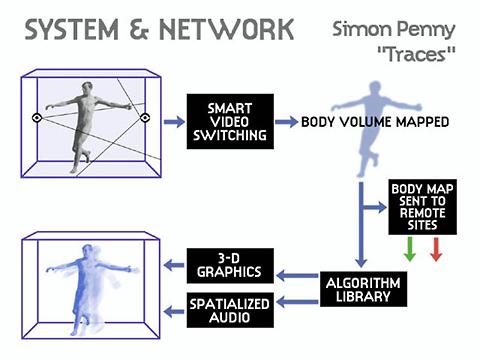

In his Exeter talk, Penny momentarily reflected on a weird and altogether disturbing seventeen year feedback loop. The loop in question relates to how, in 2014, Penny’s early avant-garde ideas and theoretical ambitions have largely been desecrated by their replication in big business. With regard to Traces, Penny cited Microsoft’s Kinect as being the most salient example of this desecration: Kinect’s technology – marketed for the Xbox console brand – carries within its insidious techniques the ability to also “communicate kine[c]thetically”, but do so within pre-packaged, patented, IP-driven, focus-grouped-out-of-existence, commercial vacuities of gamer experience.

As an early practitioner and developer of these technologies, Penny was somewhat visibly infuriated with this, and understandably so. For him, it unintentionally reduced his aesthetic experimentation, philosophical insight, technological futurity and theoretical complexity into consumer speculation for the technology market, commandeering the tech but without the value. It transposed the artistic technological avant-garde necessity of Traces into a flaccid ‘tech-demo’ demonstration of novelty limb flailing and high-end visuals devoid of anything. It was, Penny lamented, “a very weird situation” to be in. Part of that weirdness has to do with the fact that Penny hadn’t done anything especially wrong, because there wasn’t any tangible aesthetic qualities that separated his pioneering work from Microsoft’s effort. Neither had Penny’s work brought financial success with its value intact (because its value wasn’t patentable). Instead technological development had overwritten the aesthetic value of Traces, trading technological obsolescence with aesthetic obsolescence.

Penny’s retroactive predicament is not unique in the history of digital art: for all the visionary seeds of potential in Roy Ascott’s legendary networking project, Terminal Art (1980) we now recognise how those salient characteristics have somehow ended up as Skype or Google Hangouts. Still in the 80s, one might evoke Eduardo Kac’s early videotext works (1985-1986) where visual animated poems were broadcast on the online service exchange platform Minitel (“Médium interactif par numérisation d’information téléphonique” or “Interactive medium by digitalizing telephone information” in its French iteration): a proprietary precursor to the World Wide Web [3]. The retroactive weirdness accompanying these developments is something I’ll come back to: suffice to say that what counts is the direction (and sometimes hostile return) of infrastructure, not just as the background collection of assemblages artists rely on to experiment with at any historical moment, but the shifting ecological foundations to which technology emerges, affords, and now overwrites such practices. No-one likes to play devil’s advocate and yet one must ask the question specific to Stern’s text: what, or maybe where, is the tangible point at which ‘art’ becomes historically valued in these works, if that latent aesthetic potential becomes just another market for a series of Silicon Valley, or startup conglomerates?
——–
Nathaniel Stern’s Interactive Art and Embodiment establishes two first events: not only Stern’s debut publication but also the first of a new series from Gylphi entitled “Arts Future Book” edited by Charlotte Frost, which began in 2013. All quotations are from this text unless otherwise stated.
Stern’s vision in brief: in order to rescue what is philosophically significant about interactive art, he justifies its worth through the primary acknowledgement of embodiment, relational situation, performance and sensation. In return, the usual dominant definitions of interactive art which focus on technological objects, or immaterial cultural representations thereof are secondary to the materiality of bodily movement. Comprehending digital interactive art purely as ‘art + technology’ is a secondary move and a “flawed priority” (6), which is instead underscored by a much deeper engagement, or framing, for how one becomes embodied in the work, as work. “I pose that we forget technology and remember the body” (6) Stern retorts, which is a “situational framework for the experience and practice of being and becoming.” (7). The concepts that are needed to disclose these insights are also identified as emergent.
“Sensible concepts are not only emerging, but emerging emergences: continuously constructed and constituted, re-constructed and re-constituted, through relationships with each other, the body, materiality, and more.” (205)
Interactive Art and Embodiment then, is the critical framework that engages, enriches and captivates the viewer with Stern’s vision, delineating the importance of digital interactive art together with its constitutive philosophy.
One might summarise Stern’s effort with his repeated demand to reclaim the definition of “interactive”. The term itself was a blatantly over-used badge designed to vaguely discern what made ‘new media’ that much newer, or freer than previous modes of consumption. This was quickly hunted out of discursive chatter when everyone realised the novel qualities it offered meant very little and were politically moribund. For Stern however, interactivity is central to the entire position put forward, but only insofar as it engages how a body acts within such a work. This reinvigorated definition of “interactive” reinforces deeper, differing qualities of sensual embodiment that take place in one’s relational engagement. This is to say, how one literally “inter-acts” through moving-feeling-thinking as a material bodily process, and not a technological informational entity which defines, determines or formalises its actions. A digital work might only be insipidly interactive, offering narrow computational potentials, but this importance is found wanting so long as the technology is foregrounded over ones experience of it. Instead ones relationship with technological construction should melt away through the implicit duration of a body that literally “inter-acts” with it. In Stern’s words:
“…most visually-, technically-, and linguistically-based writing on interactive art explains that a given piece is interactive, and how it is interactive, but not how we inter-act” (91)
Chapter 1 details how aesthetic ‘vision’ is understood through this framework, heavily criticising the pervasive disembodiment Stern laments in technical discussions of digital art and the VR playgrounds from the yesteryear of the 90s. Digital Interactive Art has continually suppressed a latent embodied performance that widens the disembodied aesthetic experience towards – following Ridgway and Thrift – a “non-representational experience.” Such experiences take the body as an open corporal process within a situation, which includes, whilst also encompassing, the corporal materiality of non-human computational processes. This is, clearly, designed to oppose any discourse that treats computation and digital culture as some sort of liberating, inane, immaterial phenomenon: to which Stern is absolutely right. Moreover, all of these material processes move in motion with embodied possibilities, to “create spaces in which we experience and practice this body, its agency, and how they might become.” (40) To add some political heft, Stern contrasts how the abuse of interactivity is often peddled towards consumerist choice, determining possibilities, put against artistic navigation that relinquishes control, allowing limitless possibilities. Quoting Erin Manning, Stern values interactive art’s success when it doesn’t just move in relation to human experience, but when humans move *the* relation in experience (Manning, 2009: 64; Stern, 46).
Stern’s second chapter moves straight into a philosophical discussion denoting what he means by an anti-Cartesian, non-representational, or implicit body. Heavily contexualised by a host of process, emergent materialist thinkers (Massumi, Hayles, Barad), Stern concentrates on the trait of performance as the site of body which encapsulates its relationally, emergence and potential. The body is not merely formed in stasis, (what Stern dubs “pre-formed” (62) but is regularly and always gushingly “per-formed” (61) in its movement. Following Kelli Fuery, the kind of interactivity Stern wants to foreground is always there, not a stop-start prop literate to computer interaction, but an effervescent ensemble of “becoming interactive” (Fuery, 2009: 44; Stern, 65). Interactive art is not born from an effect bestowed by a particular medium of art making, but of “making literal the kinds of assemblages we are always a part of.” (65)

Chapter three sets out Stern’s account for the implicit body framework: detailing out four areas: “artistic inquiry and process; artwork description; inter-activity and relationally.” (91) Chapters four, five and six flesh out this framework with actual practices. Four considers close readings of the aforementioned work of Penny together with Camille Utterback merging the insights gained from the previous chapters. What both artists encapsulate for Stern is that their interventions focus on the embodied activities of material signification: or “the activities of writing with the body” (114) Utterback’s 1999 installation “Textrain” is exemplary to Stern’s argument: notably the act of collecting falling text characters on a screen merges dynamic body movements with poetic disclosure. The productions of these images are always emergent and inscribed within our embodied practices and becomings: that we think with our environment. Five re-contextualises this with insights into works by Scott Scribbes and Mathieu Briand’s interventions in societal norms and environments. Six takes on the role of the body as a dynamic, topological space: most notably as practiced in Rafael Lozano-Hemmer. Chapter seven I’ll discuss near the conclusion: the last chapter shortly.
Firstly, the good stuff. Interactive Art and Embodiment is probably one of the most sincerest reads I’ve encountered in the field for some time. Partly this is because the book cultivates Stern’s sincerity for his own artistic practice, together with his own philosophical accounts that supplement that vision. His deep understanding of process philosophy is clearly matched by his enthusiastic reassessment of what interactive art purports to achieve and how other artists might have achieved it too. And it’s hard to disagree with Stern’s own position when he cites examples (of his work and others) that clearly delegate the philosophical insights to which he is committed. One highlight is Stern’s take on Scribbes’ Boundary Foundations (1998) and the Screen Series (2002-03) which intervenes and questions the physical and metaphorical boundaries surrounding ourselves and others, by performing its questioning as work. This is a refreshingly earnest text, proving that theory works best not when praxis matches the esoteric fashions of philosophical thinking, but when art provides its own stakes and its own types of thinking-experience which theory sets out to faithfully account and describe. Stern’s theoretical legitimacy is never earned from just digesting, synthesising and applying copious amounts of philosophy, but from the centrality of describing in detail what he thinks the bodily outcomes of interactive art are and what such accounts have to say: even if they significantly question existing philosophical accounts.
Stern leaves the most earnest part of his book towards the end in his final semi-auto-biographical companion chapter called “In Production (A Narrative Inquiry on Interactive Art)”. This is a snippet of a much larger story, available online and subject to collaboration [4]. Here, Stern recounts or modifies the anxiety inducing experience of being a PhD student and artist, rubbing up alongside the trials of academic rigour, dissertation writing and expected standards. Quite simply, Stern is applying his insights of performative processual experience into the everyday, ordinary experiences faced by most PhD students in this field, and using it to justify a certain writing style and a sense of practice. It’s an enjoyable affair – in large part because it outclasses the dry scholarly tone usually associated with writing ‘academically’, elevating imaginative, illuminating redescriptions for how the experiences of interactive art broadly hang together rather than relying on relentless cynical critique. And most of that is down to Stern’s strong literary metaphorical technique for grounding his vision, perhaps even more effectively than the previous chapters.
Yet earnest experiences aside, there are two problems with Stern’s vision which, in my eyes, leave it flawed. That isn’t a bad thing: all visions are flawed of course. That’s why the similarities between art and philosophy feed our heuristic, academic compulsion to come up with them and debate: well, that and sometimes the most flawed can end up being the most influential. Such flaws only arise in relation to what Stern thinks is valuable in interactive art, and to the extent that the intervention posed may require readdressing. The flaws in question are composed from two different angles, but stem from one objection. The first is philosophical, or at least a problem pre-packaged with relying almost entirely on relational ideas of embodied emergence. The second is more tied to infrastructure and technical expropriation as outlined in Penny’s predicament given from the outset.
In his introduction, Stern makes clear that this is an “art philosophical book” (4), not a philosophy of art as such: only one that “understands art and philosophy as potential practices of one another” (4). Following Brian Massumi, philosophy “tells us the stakes”, whilst “art brings those states to the table” (5), such that the type of art he values and constructs, (digital interactive art) is precisely that which melts away in its interactive encounter when constructed as work. Later on we discover that interactive art “interrupts relationality” (66), making present an “intervention that brings a situated moving-thinking-feeling to a higher power.” (66) Further on, interactive art does something else, when it “intensifies features of […] the ongoing transformation of the ‘living’ body”, and “gifts us with a state to practice being and becoming.” (73) Reflecting on the infamous Bourriaud/Bishop relational aesthetic ruckus a decade ago, Stern outlines how they focus on the explicit body (82) (how we understand ourselves or challenge explicit social/economic positions in the world), whereas artworks which privilege the implicit body have us “encounter how we move, transform, and are (continuous)” (82) in the world. The former takes on the materiality of social relations, the latter (endorsed by Stern) takes on the whole materiality of “embodied relations” (83). And again to reiterate, art operates as “the practice of contemporary philosophies, where we investigate, and further research on, embodiment and relationally together.” (83).
Now, one should admire how Stern blends philosophy and art praxis together precisely by not shoehorning authoritative philosophical accounts into art praxis where they aren’t needed. This works, precisely as the ontology expressed here actively resists such authoritative accounts as well as being cemented with the sort of sincerity with which Stern has such a keen literary grasp. More importantly, Stern cites works which seem to fit the stakes of his ontological conviction perfectly.
However the reliance of process-based philosophy dampens exactly how these works intervene to bring about the values he so desires. The simplest objection comes from asking how Stern might value anything at all, if our entire relational embodiment with the world is constantly in process – or that “[b]odies and matter are change” (220) – and must be always affirmed as such: why should every process and every bodily interaction be affirmed? Moreover why is it art’s place to give primacy to the ontological events of bodily material change?
This is one of the key infrastructural problems that surface, once a theory of art totally subscribes to a process-based ontology, let alone one focusing on embodiment: why should an artist like Stern feel compelled to present an intervention in the first place? If the dominant ontological movement of interactions is a becoming-event, by what standard or eruption should interactive art be said to work on? If, as Stern believes, “the interactive process in interactive work is the ‘work’” (159), it becomes unclear what value interactive artworks are purported to convey, if that process is all there is. To say that embodied processual events make the work “work”, because they underscore our situational intelligibility (or make it effective – so to speak) speaks nothing of what differential criteria should apply to make that aesthetic intervention intelligible. To hazard a guess, the problem is one of articulating how convention exists in a process ontology: because if everything is always emerging as an interactive event of change, the act of rupturing or intervening in convention becomes a real problem. The criteria for valuing these important works is only affirmed it seems, because every process is already affirmed: and if that’s the case you don’t need artists to make an intervention – there is no intervention required, other than the events that already exist, as change in themselves. To put it another way: why should (and how can) a work effectively gift us heightened states of being and becoming, if our entire situational relationship with the world is already situationally related in being and becoming?
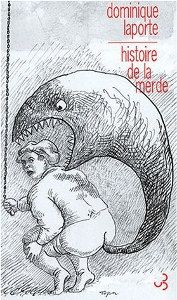
I am reminded of Adrian Johnston’s 2001 review of the newly republished English translation of Dominique Laporte’s History of Shit (first published in 1978). Whereas most Foucaultians and Althusserians were disconcertingly vague in pointing out the concrete material conditions for subjectivity and economical production, Laporte boldly contended that the genealogical hypothesis to all modern civilisations was tied to one concrete material condition: the infrastructure of bodily waste management, or, the desire to control and sublimate our need to defecate. In his usual Žižekian repartee, Johnston suggested that Laporte’s bizarre history of modernity implicitly accepted the anti-Cartesian embodiment thesis (that cognition cannot be separated from the actions of the body), but pushed its logic to the end. That for all the affirmative, encompassing, sensual, emergent, potential images embodiment philosophy prefers to agree and discuss, it completely ignores one of our central and basic bodily requirements: to excrete our bodily waste or fecal matter, and remove it from sight and smell (and we don’t need to remind the reader of art’s fascination with this area).
Whilst Johnston’s tongue was firmly planted in his cheek, he did happen to put a psychoanalytical finger on the central problem with process based embodiment. That often enough, sincere accounts of embodiment designed to affirmatively depict and encompass implicit environment material engagements leave behind an unacknowledged stain: one which says more about these accounts than their proponents actually do. And it is precisely because Stern focuses on the most aesthetically agreeable areas of bodily engagement in interactive art, that something as habitual and ritualistic as the excretion of digested matter, or the infrastructure of sewage networks exposes that image.
In terms of materiality this is doubly important. Laporte’s intervention brings into conflict two competing performative materialisms which disclose our own bodily relationships with non-human processes (in this case, computational and networked material): the first is Stern’s own account of the material body as some sort of ‘nebulous material’ which is always emergent, lived, relational and thinking with its own engagement in the world of humans and non-humans. The second is Laporte’s material body seen as ‘brutal material’ – an explicit input-output, complex, evolutionary processing machine, strictly determinate and bounded in its biological function. Despite Stern arguing earnestly for the nebulous form, it doesn’t appear to me that he can hold off the brutal form, or at least prevent the latter from antagonising the former. And often enough, this happens because Stern’s accounts of embodiment, and the philosopher’s accounts he relies on, are already meant to be nebulous in themselves.
This logic unravels by chapter seven, when Stern expands the implicit body framework to analyse other examples of new media art which aren’t preoccupied with bodily participation to work, as work. He terms this “potentialized art” (206) where “audience members do not *make* the work directly through their interactions (207) but are subject to visual performances of potential movement and relation mediated by generative computation and networks. In citing Gordan Savičić and Jessica Meuninck-Ganger – amongst others – Stern argues that these ongoing performances harness generative information participating in embodiment relations, and invite metaphorical sensory change and bodily movement (in the case of Savičić’s performances, quite literally inflicting pain and suffering onto his own body using network data and social media).
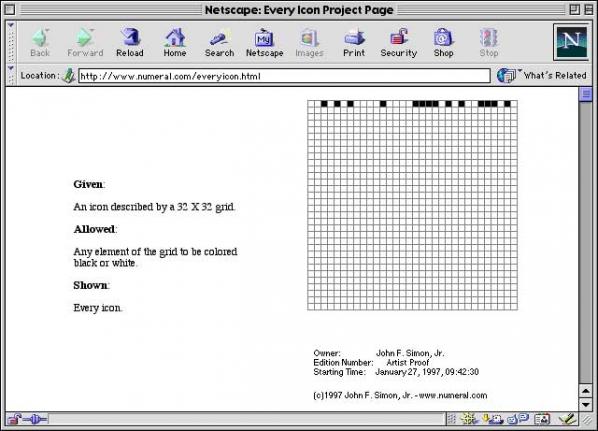
However when Stern cites John F. Simon. Jr’s infamous work Every Icon (1997), (227 – 230) (a cellular automation piece which takes approximately several hundred trillion years to complete) it becomes clear to me that the aesthetically agreeable areas of embodiment start to break down. It might be that my own reading of the piece is fairly unorthodox [5] (I don’t consider the work to be primarily conceptual for a start), but Every Icon eschews what Stern writes as giving “both the corporeal and incorporeal a present and future presence as time and sign” (230) or something that generates attention to our “sensual and conceptual experience of temporality” (230).
Yet, isn’t it the case that Every Icon is probably one of the least potentialised artworks ever made? It doesn’t actually generate anything, (in the strict sense of unpredictable outcomes from simple rules) it simply enumerates configurations of pixels one by one. Neither can we be said to “feel the potency of several hundred trillion years” (230) than we feel the cold, indifferent execution of a real java applet function to which we are forever limited in experiencing directly. If anything, Every Icon is deliberately constructed to forgo a relation with us.

To conclude: this is perhaps why Penny’s predicament with the Kinect is so stark. To demand, as Stern does, that we treat digital interactive art as setting a stage for examining how we “per-form” with our bodies within media, material, conceptual frames and selves, is no longer enough of a stage to give voice to the technological ecologies we find ourselves in: nor of the art that satisfies intervening in it. Credit must be given to Stern for writing over interactive art’s emancipatory myth of disembodied immateriality, but his endorsement of embodiment only serves to realise that the problem isn’t forgetting to focus on material engagement, but forgetting the cold, hard and brutal materiality of procedural performance of infrastructure, that often moves faster than we do. When Microsoft’s Kinect co-opts all the same values of Traces, it does so not because embodiment is totally flawed, but that bodily movement has now become ecologically implicated in deceptive infrastructure.

Just as Penny’s Traces may once have evoked a renewed attention to moving-thinking-feeling, such engagements are now suitably tracked and are in service of non-transparent infrastructures of geo-social activity, which propagate themselves beyond our sensory engagement, yet paradoxically they also indirectly sustain that ordinary engagement. For example, this is now a world where Google funds a 60tbps undersea cable connecting the West Coast to Japan, in order to propagate the reach of their services. The technological engagement of our bodies cannot be restricted to how we move-think-feel, but now weaves itself within layers upon layers of platforms and pervasive surveillance structures. And I don’t disagree with Stern that the implicit body is, perhaps, deeper than the account I give here. But maybe that’s because the body is also another type of performative infrastructure, tightly bound into other formations that are just as deep, complex and engaged. We now live in a time where digital interactive art has to intervene in the performances of geo-social infrastructure: where our bodies have curiously taken on their self-directing performances, rather than our own.
[Notes:
1. These are the minimally reformatted and slightly expanded notes for what would have been a 15-minute presentation.
2. The presentation was meant to be followed by questions and form part of the introduction to a panel discussion. Any questions in the comments here or on netbehaviour gratefully received.]
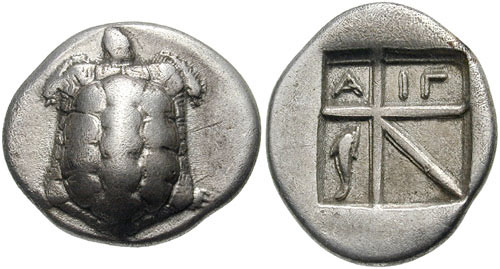
Art and money have always been involved in each other’s production. This is a Greek Drachma from 600BC with a relief depiction of a sea turtle on one side. For many people this would be the artwork, or at least the image, that they saw most frequently in their everyday lives.
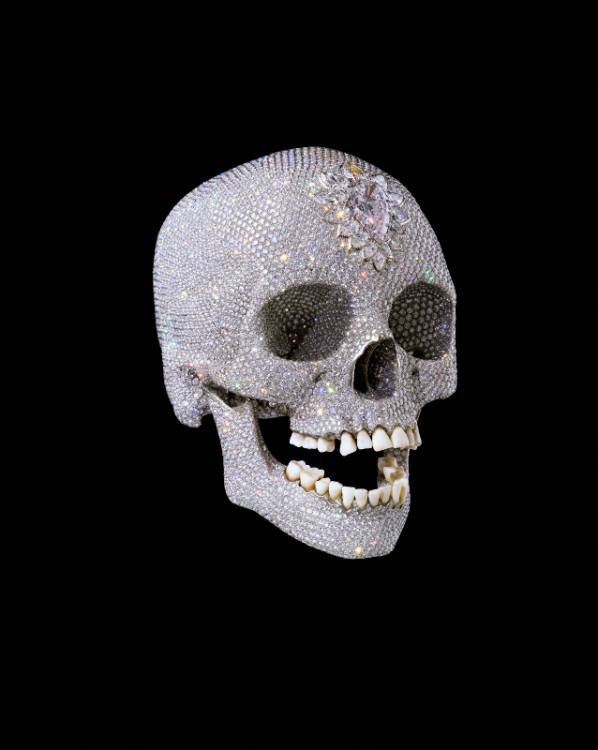
In the present day, high art and high finance (or big art and big finance) go hand in hand. Blue chip artworks produced by brand name artists like Jeff Koons are collected by hedge fund managers and oil oligarchs as investments and as signifiers of socioeconomic position (while stolen Old Master paintings are used as signifiers of value in transactions between criminal gangs…). This tendency reaches its logical conclusion for now with Damien Hirst’s “For The Love of God” (2007), a diamond-encrusted platinum cast of an actual human skull complete with the original teeth. It was sold for fifty million pounds sterling.

Looking inside the sale of “For The Love Of God” makes its narrative less straightforward. It was sold to a group including the artist and their dealer, making the actual figure and its ownership less straightforward than a simple sale would suggest. Nanex’s High Frequency Trading visualizations from 2010 look inside transcations in electronic stocks & shares markets, finding aesthetic forms in the activity of share trading bots. What the sawtooth waves of this bot’s activity represent is unknown: a glitch, a strategy, a side-effect. But without making these forms visible, we would not be able to ask these questions or reflect on this economic activity.

It is part of the value of art, particularly Conceptual Art, that it can afford us these opportunities for reflection and critique. Cildo Meireles’ “Insertions Into Ideological Circuits 2” (1970) overwrites the contemporary equivalent of the Drachma’s turtle with a rubber stamped message on a banknote, intruding into everyday use and circulation of currency in order to give its audience a pause for critical reflection.
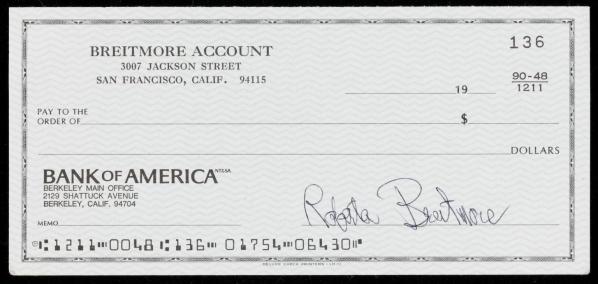
Lynn Hershman’s “Check” (1974) is signed by their artistic alter ego Roberta Breitmore, using financial transactions and their attendant contracts as a producer and guarantor of identity, literally underwriting it.
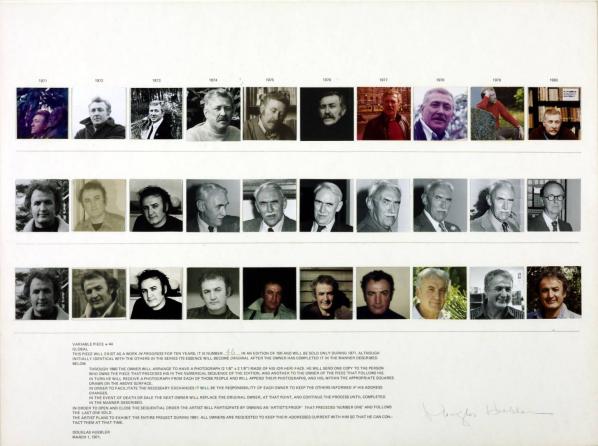
Douglas Huebler’s “Variable Piece no.44” (1971) incorporates an image of its current owner into itself each year for its first decade, in an analogue precedent for Bruce Sterling’s idea of “spimes”. When the artwork is sold a new owner appears, making the artwork’s contingent economics its aesthetic subject.
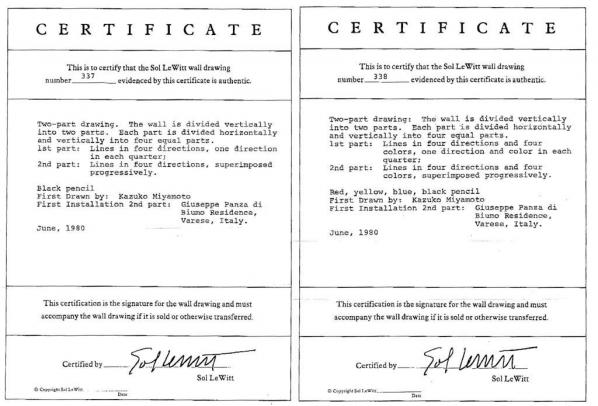
The initial critique of the ontology and economics of art that Conceptual Art represented in its “dematerialisation” phase represented as much of a challenge for the livelihoods of artists as it did to its chosen targets. One solution found early on was to produce certificates of authenticity or ownership for otherwise un-ownable art. This re-appropriates conceptual art for scarcity economics and as property, returning it to the market. Sol LeWitt’s certificates for two wall drawings (1980) demonstrate how this works. If you own such a certificate and I do not, and we both follow the instructions on the certificate, you produce an authentic LeWitt and I at best produce a forgery.
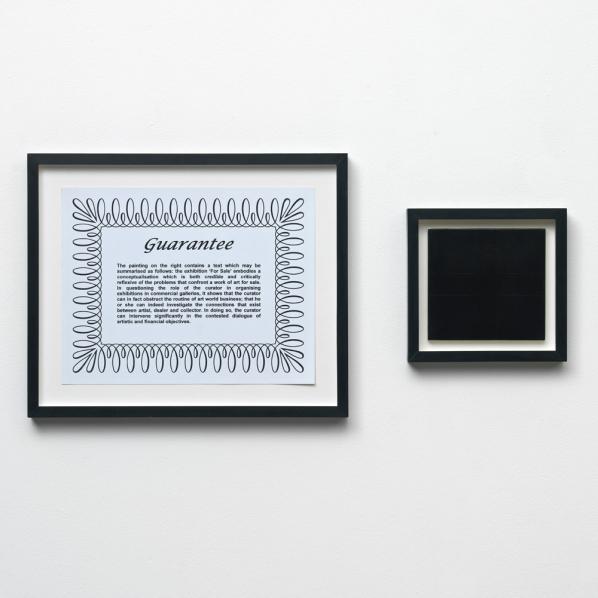
This stretegy was criticised (and parodied) within the Conceptual Art movement itself. An early Art & Language artwork, “Guaranteed Painting” (1967), contains a printed certificate guaranteeing that the painting accompanying it contains particular content and addressing the curator of the show it appears in as someone who can possibly intervene in artworld economic relationships.
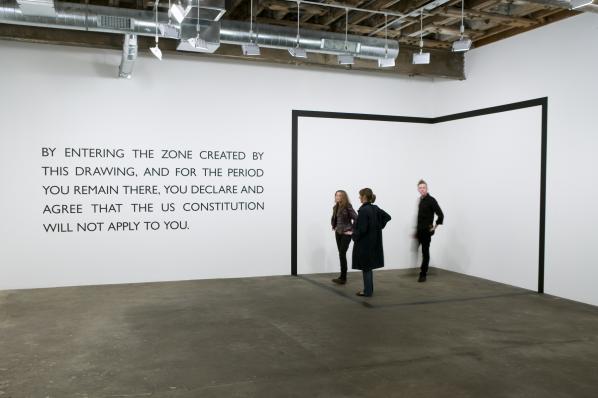
Carey Young’s “Declared Void” (2005) is a wall drawing that creates a space in which its audience enters into a contract agreeing that the constitution of the United States. Legal form as sculptural form, this is no longer about the relationship between art and money but rather between the individual, contract law, and the state. This is the kind of relationship that produces money, or at least fiat currency, and is a broader context for considering the more specific relationship between art and money.

I love this flower currency from 2005, produced by a group of Viennese artists. It’s both a LETS-style complementary currency and a use of the aesthetics of pressing flowers to allegorize and aestheticize the relationship between nature, production, and value in economies.
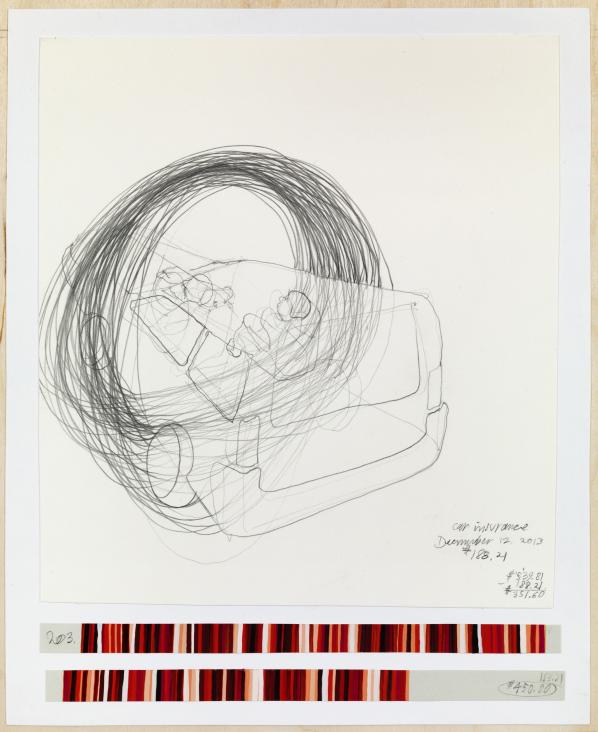
This Danica Phelps stripe drawing (2013) shows the artist’s expenditure on reparing their car. If it depicted income rather than outcome the stripes would be green rather than red. Phelps’ work combines the ledger of their economic existence with the artistic record of their social presence.
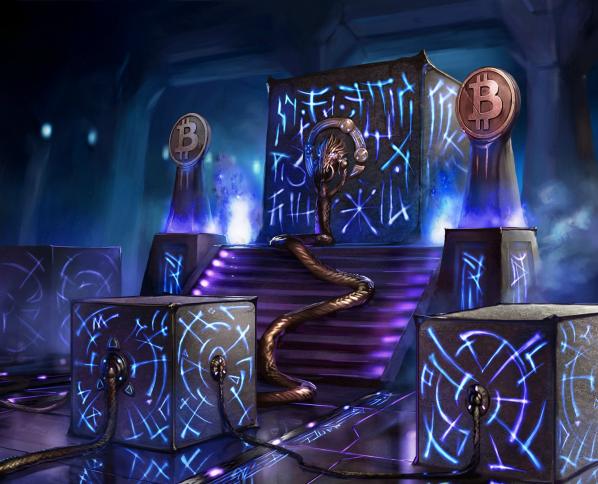
Bitcoin emerged as a critique of state-issued “fiat” currency following the financial crisis of 2008. Bitcoin is a cryptocurrency, a piece of software that runs on computers (“nodes”) spread across the network that communicate with each other to reach a shared consensus on the current state of a cryptographically-secured ledger. Every ten minutes or so these computers bundle up transactions into “blocks”, each of which refers to the previous block. This is the “blockchain”. This is yodark’s fanciful depiction of the blockchain proceeding from the first block of transactions, the “genesis block”.
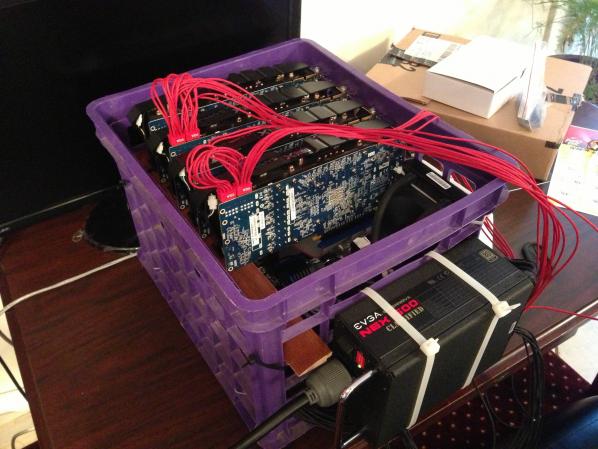
In reality news blocks in the chain are validated (or “mined”) by nodes in the network using increasingly specialised hardware, such as this milk crate mining rig from a couple of years ago. They perform difficult to solve but easy to validate sums on each block, the “proof of work”, and the first node to succeed gets a reward (paid in Bitcoins) for doing so.
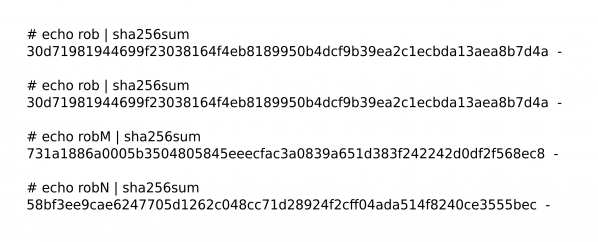
Bitcoin account addresses, Bitcoin transactions, and the proof of work system all use cryptographic algorithms. These are mathematical ways of taking data and creating an almost un-fakeable, almost un-reversable, almost unique (where “almost” means “as likely to fail as the Earth is likely to be hit by a civilization-ending asteroid in the next 20 minutes”) identity for it. The examples here show how feeding a cryptographic hash function the same data twice results in the same incredibly unlikely number, but feeding it even slightly different data results in very different and unrelated numbers.
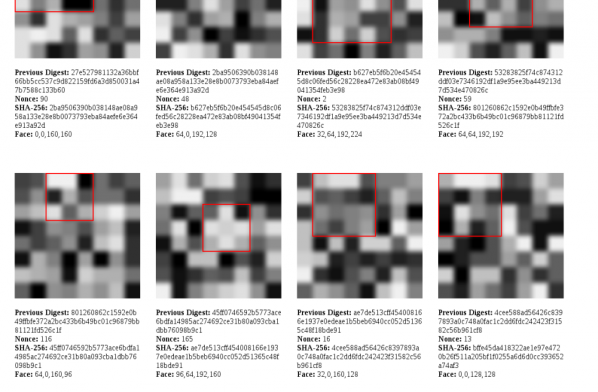
Bitcoin uses these functions to secure its network in the “proof of work” system by searching for auspicious numbers in their output (strings of zeroes in the current scheme). My Facecoin (2014) implements an alternative proof of work system in which the useless work performed is that of portraiture, (mis-)using machine vision algorithms to find imaginary faces in cryptographic hashes represented as bitmaps rather than numbers.
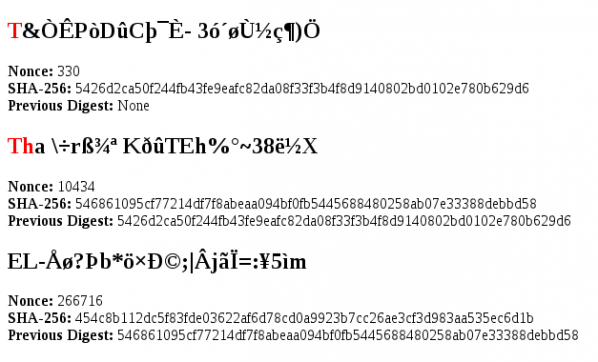
My Monkeycoin (2014) takes a different approach, searching for the complete works of shakespeare in textual representations of those numbers.
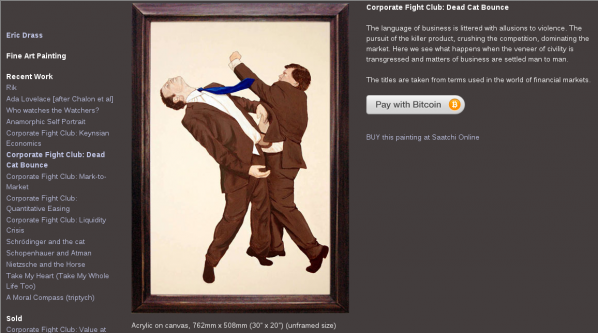
Cryptocurrencies can be used in lieu of fiat currency for all kinds of transactions, including artistic ones. Here the artist Eric Drass is offering a painting for sale via Bitcoin. Different means of exhange create different kinds of social relationships, buying the painting via Bitcoin is a different kind of social and economic transaction than paying with fiat currency for it via Saatchi Online.

Cryptocurrencies can be created as complimentary currencies with specific intent or for specific constituencies. This is the logo of Banksycoin (2014), an attempt to create a currency to pay for art and create a parallel economy for artistic production.
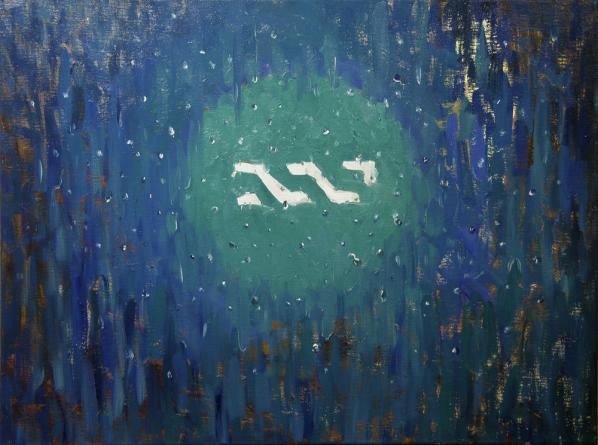
Cryptocurrency-based technology can change how individual artworks are owned as well as paid for. This is theironman’s “nxtdrop” (2014), the ownership of which is represented by shares on the “nxt” blockchain. Ownership of the painting can be changed fractionally by dealing in those shares.
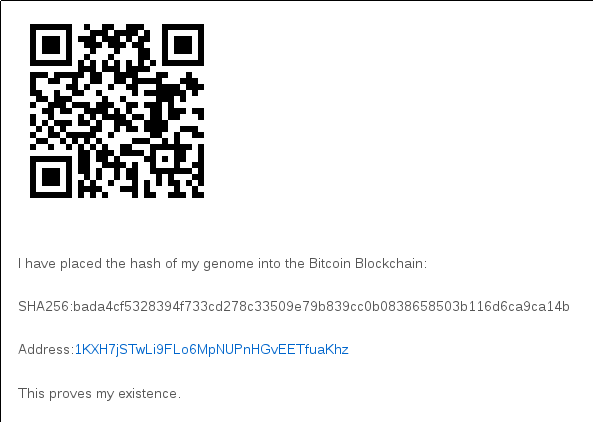
There are poems, images, and other cultural artefacts embedded in the Bitcoin blockchain, disguised as transaction information. I embedded the cryptographic hash of my genome in the Bitcoin blockchain to establish my identity with “Proof Of Existence I” (2014).
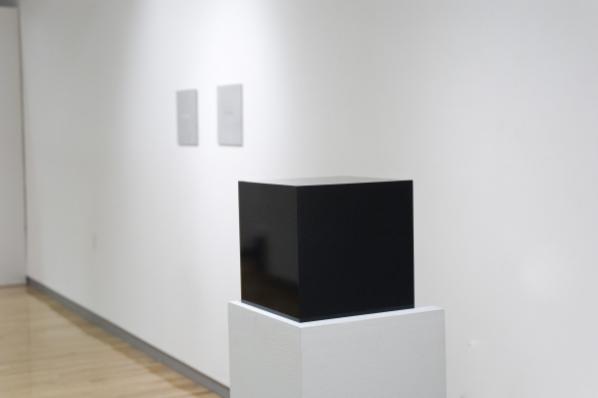
This is Caleb Larsen’s “A Tool To Deceive and Slaughter” (2009). It contains a computer that must be connected to the Internet as part of the conditions of ownership, which then immediately offers itself for sale on the eBay auction site. This kind of “smart property” is a good example of smart contracts, in which arrangements such as ownership are managed by software rather or more immediately than by law.
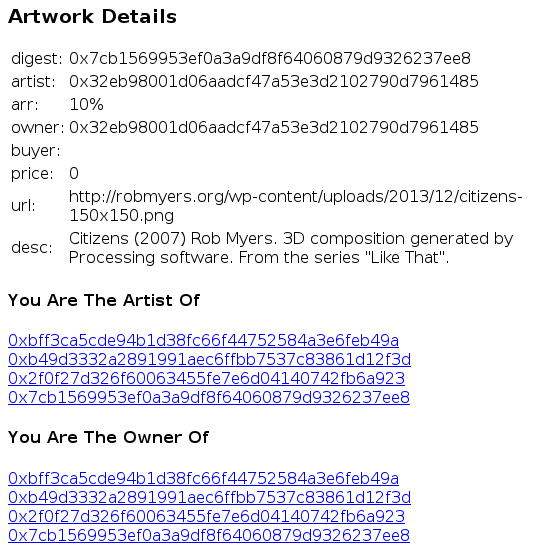
My “Art Market” (2014), uses the Ethereum smart contract system (a generalization of Bitcoin to contracts other than for the exchange of money) to record “owenrship” of infinitely reproducible digital files and allow them to be “sold” for cryptocurrency. Other systems exist to do this, such as the Monegraph and Rarebit systems.
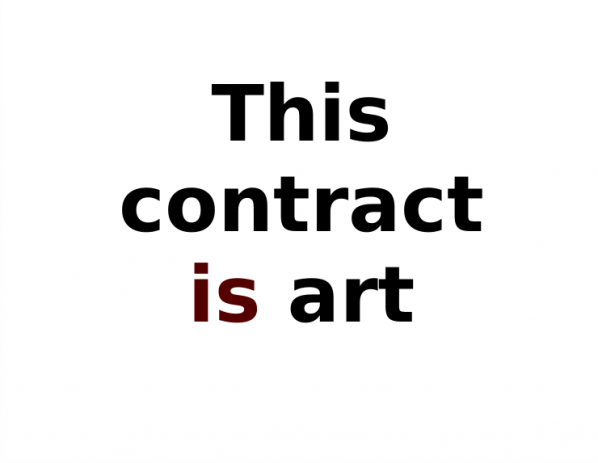
My “Is Art” (2014) uses a simple smart contract to democratize the nominational strategy of conceptual art. The contract can be set to nominate itself as art or not with a click of a mouse and the paying of a small fee to execue the change on the blockchain.
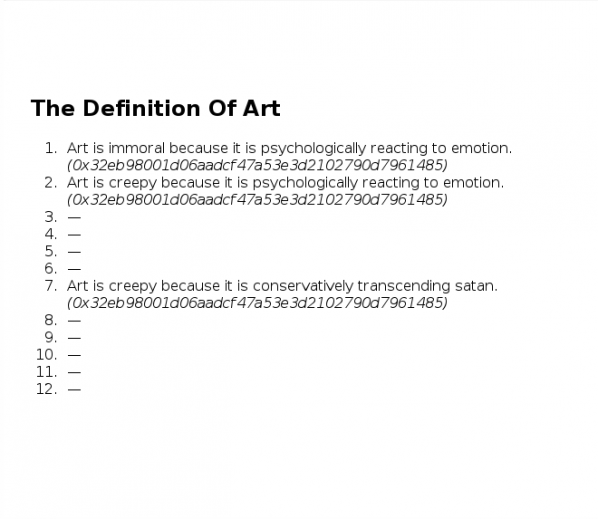
My “Art Is” (2014) applies behavioural economics to the philosophy of art, allowing individuals to pay as much as they feel their definition of art it worth. This disincentivises malicious or unserious definitions and indicates an individuals’s confidence in their definition, using market mechanisms to price and allocate knowledge and even truth efficiently. fnord
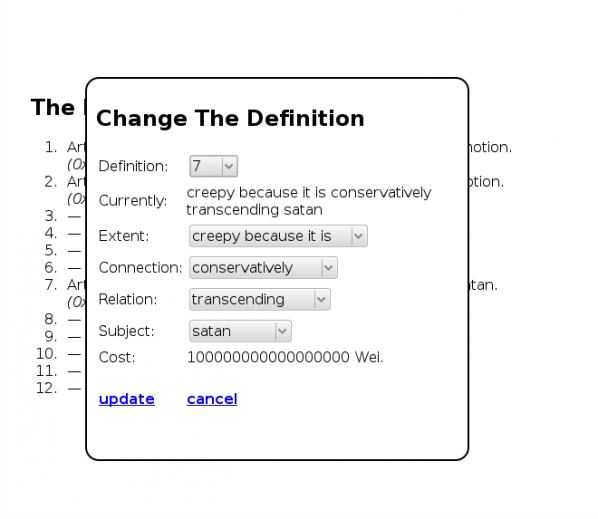
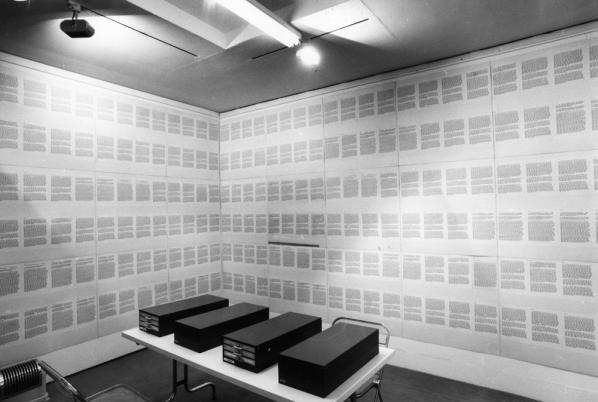
This is Art & Language’s “Index 002” (1972), a collection of the group’s writings assembled and indexed for presention in a traditional gallery setting to assert their identity and productivity at a time when their largely conversational practice might not have looked much like “art” to outside observers. Filing cabinets and photocopied sheets were contemporary information technology, later “Indexes” would use microfilm and (allegedly random) computer-generated tabulations. Their use and the production of the “Indexes” was both a solution to and a subject of the problems of Art & Language’s work. A contemporary group could use the blockchain to similarly focus and problematize their work.
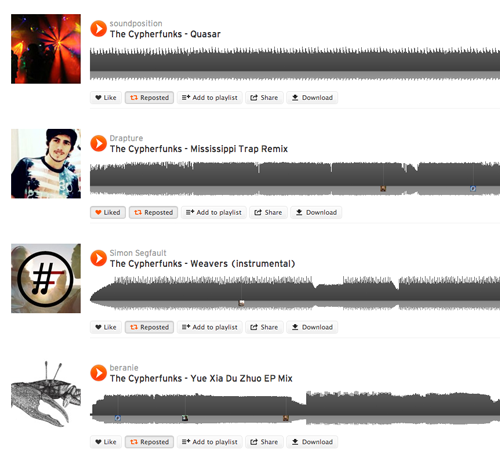
The Cypherfunks are a distributed music group. Anyone who uploads a song to the SoundCloud music sharing web site tagged #thecypherfunks receives the groups cryptocurrency FUNK in return, becoming part of the group.

Dogecoin is one of the most popular “altcoins”, Bitcoin-derived cryptocurrencies that are not interoperable with the original Bitcoin network. It is the coin of an intentionally constructed culture of virtue and play, with its own argot and social norms based on Internet memes (particularly the titular “Doge” and the idea of a potlatch-like norm of tipping).

These are all more contemporary, and more complex, ways of demonstrating affiliation to a group than simply painting currency code-like letters on a canvas (this is a detail from Millais’ “Isabella” (1849). Possibly the ultimate in creating a group affiliation, or even a society, using smart contract technology is the idea of “Decentralized Autonomous Organizations” (DAOs), economic agents that exists on the blockchain and manage the resources of an organization via code rather than bylaws or legislation.

This is “The People’s Republic of DOUG”(2014), a DAO implemented as smart contracts on the Ethereum smart contract system’s blockchain. You can become a citizen, own property, vote, use its own currency in transactions, all functions traditionally provided by the state as conceived of in terms of contract law. Bitcoin’s dream of a stateless (but not property-less, making it anarcho-capitalist rather than anarchist) future realised in a few thousand lines of code. Imagine using (and/or critiquing) such a system for artistic organization and/or production.
“Now make art with it.”
‘I love kitsch. I adore bad taste. I fall for the maladroit.‘ – Andrea Judit Tiringer
In a recent book ‘What Photography Is’ – and just what it is seems to be akin to the meaning of a word for Humpty Dumpty – “just what I choose it to mean – neither more nor less” – the critic and theorist James Elkins savagely lays into the users of the photography sharing site Flickr. There’s a page or so of magisterial denunciation delivered in a scornful tone not unlike Humpty Dumpty’s: “Nothing is more amazing than Flickr for the first half hour, then nothing is more tedious” and “…each group puts its favoured technology to the most kitschy imaginable uses”.
1.

It’s not that Elkins hasn’t hit on something – all the sins he bemoans, and more, certainly exist on Flickr but his is a superficial, lazy and tendentious view which evinces a shocking lack of curiosity and imagination for one so exalted in art academia. (Indeed so incensed did Elkins’s tirade make me that I started a Flickr group entitled Bollocks to James Elkins: https://www.flickr.com/groups/bollocks_to_james_elkins/rules/ please consider joining if you’re active on Flickr.)
Flickr gets lambasted too, from the opposite perspective to Elkins, by the proponents of a kind of “bottom up”, “anti-elitist”, account of art, by those who dislike its corporate ownership and by those, too, who believe that one should build such communities with pure free and open source software. To be fair to them there is here, too, much to agree with; Yahoo, Flickr’s current owners, are clearly more interested in maximising advertising income than the welfare of their users.
And yet, and yet… a little looking, a little thought and, hardest of all it seems, a little intellectual humility reveal – perhaps only the embryonic stage of – something rather marvellous too. The sheer scale of the network of users (which one must point out here could only be a utopian hope for an alternative network, at least under the current social and economic system), the fact that it is impossible that the art world as it currently exists can (or might want to) present to us every piece (or even a small percentage) of work worthy of our attention and, further, that there are many people for whom the impetus to make work is a stronger imperative than getting on in life, or becoming celebrities or making money – akin to Marx’s “Milton [who] produced Paradise Lost in the way that a silkworm produces silk, as the expression of his own nature” – means that careful sifting reveals artists every bit as worthy of our attention as those who please the art-world gatekeepers.
I’ve found hanging out on Flickr enormously nourishing both in terms of intelligent feedback on my own work but also in terms of the diversity of interesting and engaging work by others, some of whom even employ the “favoured technologies” – which largely seems to mean software manipulation – Elkins finds so risible, but in such a way that any honest accounting would find far from such.
It is true that one is tempted on occasion to conceptualise some of this work in terms of “outsiderdom” and this can be a helpful starting point; but there is a quantity/quality dialectic at work in the sheer size of the Flickr database and in the dialogues between the highly focussed outsider, the odd art world figure who doesn’t fear to rub shoulders with those not in the charmed circle, the family snapshot taker and even, though admittedly rarely, the amateur photographer who takes “well-made” photos but doesn’t forget to make them interesting too. There is a wider point contra Elkins here which can be expressed succinctly as – no form, no technique is in and of itself ruled out from the process of making art. Indeed the greatest artists have often taken the lowly, despised and out of fashion and given it a magic twist to create previously undreamed of possibilities.
I venture to suggest that the beginnings of something qualitatively new are here stirring.
That’s a long preamble to some showing, rather than telling. I want to look at a single and in my view very interesting participant on Flickr. First to introduce her work and then talk to her about what it means to her to make and post it.
2.

nem sáℜa (Hungarian – ‘not Sara’ – the odd typography for the ‘R’ is a personal quirk and not a language feature ) is the name under which Andrea Judit Tiringer posts work to Flickr. Her body of work is at the same time highly consistent and extraordinarily varied. There are, at the time of writing, 252 images on her Flickr stream – all of them are 444 pixel squares (although I gather she retains larger versions offline). Of the images the vast majority feature a face or figure and this is usually Tiringer herself, a strikingly good-looking but usually (only three or four of the self portraits have smiles) melancholy presence. The focus of the images is variable and the colours are largely muted and pastel. A number of the images feature text, mostly in Hungarian (and occasionally other eastern and central European languages and once or twice even English) and most of them are clearly the product of some process of collaging. What is striking about these images is how sophisticated the use of the space is – there is no sense whatsoever of any “algorithmic” approach to the making of these works – no recipe – each one feels thought through from the beginning and one can linger on each and find new and interesting content (by which I also mean marks, variations of focus or colour, absences, difficult to decipher sections) and relationships within it.

Some are funny (or perhaps lugubrious is a better word) with the kind of tinder dry poker faced humour I particularly associate with Eastern Europe (Nikolai Gogol… Jaroslav Hašek… István Örkény) and which seems to have further fermented as a regional characteristic during the period 1945 to 89. A number of the images either appear to be entirely drawn from albums of snapshots (maybe family, I’m not sure) or to feature components drawn from this kind of source.
A number of the images have drawings or written text added either by superimposition or in a separate space. Sometimes this takes the form of ink stamps or documents such as receipts or other official formats. Many images are divided into sections; sometimes of the same, repeated proportions, at others into something less structured. The sense of internal barriers marking off distinct sections is a strong one. These barriers are created in a number of ways – repetition, addition and the use of drawn or printed line.
The meaning of the texts, as much as I can make out the non-English ones, seems at least on the surface completely unrelated to the image content but, of course, the viewer naturally seeks such connections.

Many pieces employ “traditional” symbols of femininity – flowers, dolls, a killer dress sense. This also seems tied up with a summoning of the experience of growing up – we see a number of images of young girls. Again I’m unsure whether these are of a young Tiringer or simply found images. What does seem clear is that they carry some autobiographical charge. They are never twee (or if they do tread close, the surrounding work pulls them back from the brink and they become “about” tweeness – and if I can put it that way, the “whyness of tweeness” rather than exemplars of it). Equally the femininity cited above is certainly not inconsistent with strength and confidence. A number of the images allow us an intimacy which many self-portraitists would baulk at. Older women appear with relative frequency and are treated with tenderness and respect, as are images of daily household routines, of “women’s work”. Men appear in only two of the 252 images.
This image series is complex, subtle, sophisticated, mysterious and very beautiful. It is structured with a high level of intentionality by someone who is technically clearly completely in control of the visual language they are using but also open sudden dispatches from the unconscious. Whilst I’m always chary of ascribing “meaning” to works one can clearly delineate here a central set of concerns/hauntings/ pleasures/what-have-you which crop up repeatedly. Femininity, ageing and transition, female solidarity, day-dreaming and play, humour, storytelling, dressing-up (both the childish and the older sort) forming a kind of core around which other rarer, more peripheral themes appear and disperse.
This is not minor work.

3.
I interviewed Andrea Tiringer in English by e-mail over a couple of weeks in late August and early September 2014. Her responses appear largely in the order she sent them although I have interpolated some purely factual responses from an earlier exchange for clarity and I also corrected any (very few) errors of English usage. She checked the final interview text to ensure I had not altered the sense of any of her comments.
Could you tell us a bit about how you came to start making this very distinctive body of work and what you feel you are trying to accomplish with it?
I prefer to exist unrecorded. I take comfort in the temporary nature of things. I am always impatiently anticipating the new…. everything, I never want to hold the moment, yet somehow this photographic urge crawled into my life, without me taking notice.
The first step must have been years ago when I suddenly wanted to capture my grandma’s life. We had weekly sessions: her, me and my tape recorder. She was indecipherable. I tried to capture her essence. I needed her stories to be mine forever, figure out how to have a little ‘Róza mama’ transplanted into me. She expected me to be impossibly glamorous, the way she never could be. As far as she was concerned, that was my task. I was born at a time when girls could be scientists, astronauts, writers, but she did not want me to be a scientist, astronaut or writer, or only maybe as a side project to the grand life. She would look at my shoes and ask: were they expensive? The only acceptable response was: very.
Fast forward to about 2010 when for some reason I found myself chasing a nun on the street because I wanted to take her picture with my cell-phone. I have no idea why. I had no camera to my name, I had never before taken a photo on a whim. I caught up with her (she stopped to look at a shop window, my favourite kind of nun behaviour!) and at home I turned the poor thing, with the help of some online editing tool, into an unsightly shade of purple. I was pleased.
Some weeks later I threw a camera I found at home into my handbag, thinking, ‘Maybe I will run into something that I can take a picture of’. I saw a shabby garden through a ramshackle door. It was obvious right from the start that reality does not circumscribe me in any way.
I love kitsch. I adore bad taste. I fall for the maladroit.

So how did the very singular topics and imagery in the photos you post to Flickr came about? I’m particularly thinking of the repeated self portraiture which must be a feature of 90% of the pieces…
When I was a little girl I was convinced that just as we watch the people on TV someone somewhere is watching us, so we always have to show our best side. In my mind it worked like this: the interesting and good looking are on the telly, the rest on the radio. I would dress up to the nines and sing, because I figured if you did not have a good voice you only got to give the weather report,.
These auto-portraits are quickies. Passport photos, accessorized. Captures of what I am not but maybe could be. They are like a colourful puzzle. I never plan anything. (Actually I have planned to stop for about the last 100 images yet still I keep taking another one. I like them for a couple of days, even weeks sometimes, then forget about them, or they start to annoy me. I am a happy deleter.)

About a year ago I made an air freshener out of one. I adored that! I decided that if they are ever to materialize they will be just that: fake cherry scented tiny fake me’s dangling away in a cube shaped space and challenging visitors’ olfactory and visual endurance.
You say: “Captures of what I am not but maybe could be. They are like a colourful puzzle.”
Could you expand on both of these points? Could you say something about how the other content in any particular self portrait relates to the portrait itself and also what is happening in the pieces that don’t include a self portrait?
It’s extremely hard to describe a scheme as to how they are conceived. When I first started to create these images I haven’t taken a self-image for years. I did not even consider it, I captured what I liked, added my touch, altered them to the best of my abilities. I was getting familiar with the editing software through the process on my own, meaning there were many, many mishaps. Those were always welcome.
At some point the first auto-portrait must have happened, and of course I had all those traditional expectations: look good, appear interesting etc.
I started to think about scenes, but my goal was to create something that cannot be named, that is not easy to place, to find a category for. I avoided obvious symbols. No hearts, no crosses, no stars, nothing that could serve as a clue to the… who knows what?
When I choose the constituent elements, my decision is based only on the colour and geometry of each. This includes my attire and surroundings. For example, I look at the front of my blouse and it reminds me of ovaries; this leads me to a vintage anatomical model I printed the image of weeks ago, the colour of which somehow reminds me of a tiny burn I had on my skin at that time, so I took pictures of these and assembled an image from them..

Each has such individual stories, I never premeditate, it is such a quick process. As for the words, it amazes me the way sentences, taken out of their original context, suddenly stand bare: the absentminded cruelty in the prim cookbooks for proper ladies, the description of a slip-up from a madcap novel for teens that suddenly reads like major romantic poetry. I always photograph texts that catch my attention and if I find a loose connection I may add them to an image. Again, each one’s story is so unique, it’s hard to describe any rule or pattern.
I think there is no difference between the photos with me and the ones without me. I just haven’t found my place in each of them yet …
You’ve described quite lyrically and also humorously some of the personal sources and feelings behind the work. What I’d like you to do now is to talk us more clinically through the way, technically, that you set about making each image. Do you have, after so many, any set approach? What software do you use? How long does it take to make an image and do you make sketches or drafts before settling on the final version? Is there anything else about your approach you think is distinctive?
I use a point and shoot Nikon Coolpix, a simple, simple people-camera, I am not even sure of the exact make. I use GIMP to edit/composite.I have never made a sketch, I do not plan and plot. Something happens and I register that and this results in an image. I am presented with a pear and I casually place it beside me and notice it could belong to the pattern of the dress I am wearing. I look at items from a past exhibition at the medical museum in Budapest and as I catch sight of my reflection on the screen I perceive a concordance between me and the disfigured fetus in formaldehyde. If in those situations I can reach my camera I take a quick photo and it may become part of one of my squares. I try to avoid any set method, the only rule being the square shape.

I love taking photos of strangers. I love happening upon strangers that I want to take photos of. I love happening upon anything at all that I want to take photos of but I noticed that I got pickier over the years.
The found images come from everywhere and anywhere. Family photos, my huge box of vintage snapshots, movie stills, random Google Earth takes. My only rule regarding these is that I have to take a photo of them. No scans, no screen caps… This enables me to add my own mishaps, to “destroy” the originals with my technical shortcomings.
Of course there are schemes I could use. If you tell me to create a photo I will tell you to come back in half an hour and I’ll have it. To you it will look like the rest of them. But if I wait for my moment it can be in ten minutes or never (and I do not care, this way it is extremely personal, diary-like).
The reason I feel like stopping after each one is because their increasing number makes it a challenge to make new things, not to find myself in a rut.

So finally, given the fact that you post your work to Flickr I want to know how you view yourself? An artist? Someone with art as a hobby? An outsider artist? Some completely other category? And I want to ask too, if you had the chance to show this work in an art world context – galleries &c – would this interest you? Who is the work for? Do have any thoughts on Flickr as a place to show your work?
Leaving you to chew all that over that I’d like to say a big thank-you for your time & for the care with which you have considered and answered these questions!
I absolutely adore this time, the now. Flickr and other interactive/social media sites, in my view, are like any non-virtual public space. Similarly to our sartorial choices and general behaviour, it is a place for quick exchange of personal information, the possibility of sending perceptible signals about who we are, how we see everything and how we ourselves are related to that everything, so this is a very natural extension of my presence.
I do not really seek a label to describe my relation to the pictures. Definitions provide reassurance and security, but they also mean restriction and responsibility and it is such a relief to have tiny spaces in my life without those.
Who are they for? Hard to tell. At one point I was thinking ‘How wonderful, my son will look at them and think, great, my mum so enjoyed being.’ At the moment this looks quite unlikely, I am too alive. I get the quick attentive glance, the like on Facebook and I am happy and then he heads right back to his world of scalpels and detached limbs in formaldehyde. It is kind of reassuring that nothing about them worries a young doctor.
I will happily display them in any context where they match (or clash) perfectly, and of course that includes the art world and any other world too…

Featured image: Curt Cloninger’s ‘Twixt The Cup And The Lip #3
“A glitch is more than an error: It is a rupture in our collective techno-hypnosis, a herald of underlying realities.” – Paul Hertz
If you haven’t heard about Chicago glitch, you haven’t been paying attention to all the “noise” emanating from the Windy City. The self-proclaimed “dirty new media” crowd in Chicago has captured the imagination of artists around the world with their funky (as in Chicago blues), punk-inspired disruptions and hacked creations. As of this writing, glitChicago: An Exhibition of Chicago Glitch Art at the Ukranian Institute of Modern Art is about to close after an impressive two-month run, with works, performances, and discussions involving 22 artists heralding from Chicago and beyond.
While glitch may have a raw, subversive, outlier sensibility, it has also catalyzed a cohesive and collaborative group of artists that has organized an impressive array of community-based conferences, DIY workshops, exhibitions, and spontaneous happenings within the local media culture over the past five years. Ironically, the Chicago high-art academy is also a co-conspirator, as many of the glitch artists are based at the School of the Art Institute of Chicago, which has become the de facto experimental laboratory for the study and practice of glitch.
I spoke via web-conference with the show’s main organizer, artist and historian Paul Hertz, along with two of the artists and co-organizers, Nick Briz and Jon Satrom, in a collective effort to unpack the glitch phenomenon.

Randall Packer: Nice to meet everyone in the third space. I am going to begin with Paul because you were primarily responsible for organizing glitChicago. There are many artists in the show who do not reside in Chicago. Is the work intended to demonstrate Chicago glitch tendencies and influences, or perhaps to situate Chicago as a spiritual home of glitch, like say Chicago blues?
Paul Hertz: I think the latter to some extent, but it’s also a joke about location in a networked society.
RP: From the perspective of being outside of Chicago, I can’t think of another place in the world right now that has a more cohesive community of artists working together, building things together, breaking things together, it’s quite an extraordinary moment in time in Chicago. So my question is: how much diversity, difference of opinion, even polemical positioning is there between the artists who are part of the glitch community.
PH: He wants us to wash our underwear!
Nick Briz: I’m glad it looks so cohesive on the outside, there is disagreement, but it’s a respectful community kind of disagreement.
RP: Nick, as the author of the Glitch Codec Tutorial, in which you describe a method of making glitch, is the idea of a “glitch tutorial” perhaps contradictory to glitch as accident, mistake or rupture?

NB: No, I think it’s the most appropriate format, because it’s not a glitch tutorial, it’s a glitch art tutorial and that’s an important distinction for me. Glitch is this unexpected occurrence within a system that we come to with a certain set of expectations, and a glitch is when those expectations are broken. Glitch art is when that happens intentionally. For me, this is a personal thing. What’s really special about glitch art as a practice are the realizations you come to when you instigate those moments, the political potential for drawing certain connections, for exposing certain invisible politics within a system. That happens in process. So to produce a tutorial is not only, technically, how you produce glitches for your work, but also for people to have those realizations themselves, really experiencing glitches.
RP: So, how does that relate to the idea of intentionality, accident, and indeterminacy in glitch. Is there a right or a wrong way of doing glitch?
Jon Satrom: No, I don’t think there is a right way to do the wrong thing. I think Nick said it in his performance: “do it wrong the right way.”
NB: Do it wrong, but also doing it wrong. As in doing it wrong is the way that you do it. And then I quoted you, Jon: “there are no right ways to provoke the glitch, only the wrong ways prevail.”
JS: I think the right way to do it wrong is to always cycle back or “level up” or go “meta” to a point where you are able to view what you are doing as a structure so that you can then glitch it again.
PH: Once you have a formula though, in a sense, you’ve captured something, but it is no longer glitching when you start saying that there is a right way and a wrong way.
RP: I am curious about this problem of glitch as style, glitch as genre, glitch as a pre-determined method. It seems there is a need to avoid stylization, avoid the predictable, to avoid the preset. So it does seem as though there are boundaries to glitch, there is an area where you don’t want to go.
JS: I feel like everything is fair game.
PH: There were places we had already gone where we weren’t likely to go again and so you could say farewell to jpeg glitching, farewell to png glitching, jpeg2 glitching, to datamoshing. I have argued that those are more like tools that we have and it’s about the new technologies. Going into the show I was quite prepared actually to say that glitch is now art historical, that’s why I was doing the show. But I was surprised at how lively the subculture is, how lively the artists are who have gone on to do new things. I think glitch belongs in many ways to an earlier tradition of noise, and in that sense, it has a history, it has a future in all kinds of directions.

RP: The idea of history seems like a dark cloud that hangs over the practice of glitch, to avoid becoming rigid or formed. In regard to the roundtable discussion you just had, Paul asked the question: “once we induct glitch art into art history, is glitch art dead?” What was the outcome of this discussion? Is glitch as we know it history, has it already become part of the art-historical discourse?
PH: We did shift the conversation a little and started by talking about glitch as having a memory and glitch as having a potential future. And I think we sidestepped the history question by and large. But it was stated by a number of people, including Curt Cloninger in his essay for the show that as long as there are new technologies, there are going to be new glitches.
RP: So is there a reason why the historical question was avoided?
PH: I think it became uninteresting as time went on. We’re having so much fun just doing it, it doesn’t seem like such a serious question. It seems like a question an art historian would ask.
RP: But Paul, you’re an art historian!
PH: We all got around to being artists again.
JS: I think that when you look at history as a rigid structure and if you take a glitch perspective towards a rigid structure you’re looking at it as something that isn’t as static as may come across. Histories are presented in different ways, different agendas, different people, and I think it’s more interesting to consider our job as glitch artists to create structures that are radically inclusive, and experimental, and have enough space for agency, and individuality moving forward, rather than considering whether or not it is dead.
RP: Returning to the glitChicago show, which aspired to the inclusive, open source, community-based, DIY nature of glitch: Nick, you’re project is called 0p3nr3p0…
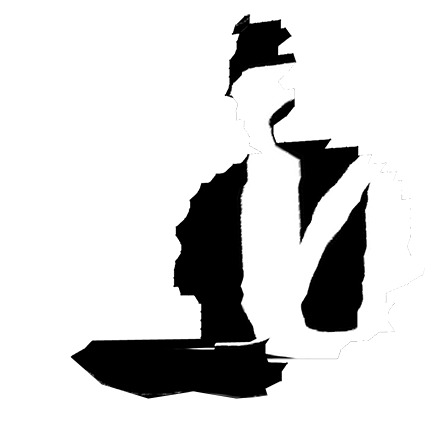
NB: It’s pronounced “open repo,” short for open repository.
RP: How does this project involve the local community as well as expand itself through the network to engage a more globally social reach?
NB: 0p3nr3p0 is at the moment a project that myself and Joseph Yolk Chiocchi maintain, an unfiltered, open port for uploading glitch art. It was an offspring of the GLI.TC/H conferences in 2010, 2011, and 2012 in Chicago. It was a result of our paranoia to be radically inclusive as a conference. So we didn’t do a call for works that last time, instead what we did was a call for threads, which is we tried to carve out spaces for other people to bring in certain conversations. And while we showed and exhibited work in the evening, all that work as best as we could was actually the result of those communities coming together. There is only so much space, there are only so many people who could show, but there are a lot of people online who we could recognize and include and so 0p3nr3p0 would become that back door entrance to the physical exhibition via the network.
RP: It seems to me that there is something about the nature of glitch that encourages democratization and inclusivity in terms of the accessibility of its practice and the techniques involved.
JS: It comes back to social structure. One way to get around the hierarchies of a social structure is to try and present things in a more populist, more open, more democratized way.
PH: There is also this transgressive aspect to glitch. Glitch itself represents a rupture, instability, of images and media. And that instability has an ideological function, as Nick is very careful to point out in the Glitch Codec Tutorial. If we are transgressing both the technology and exposing the ideology, there are reasons for us to want to expand that kind of rupture to online communities.
RP: I spoke with jonCates in an earlier interview for Hyperallergic about dirty new media. I would like to get your perspectives. Jon (Satrom), it seems like your work particularly reflects this idea as a reaction against the clean, glossy, polish of technology, a reaction against the fetish of the technological object.
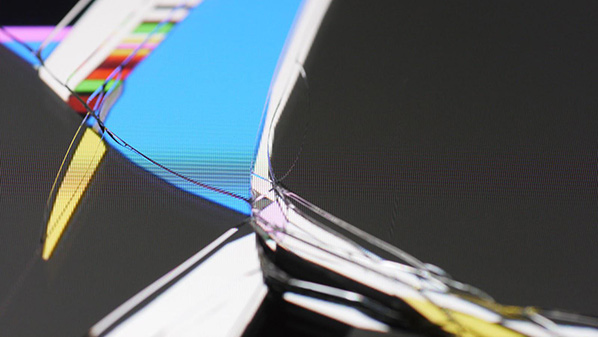
JS: Yes, it is a reaction to the sleek, brushed metal of new technology. When I think of dirty new media in terms of Chicago, there is an organic quality to it, literally you can think about dirt. This dirty style: it’s the grit, it’s the rust, it’s the realization of a false promise of technology that many of us just accept and are fine with. We’re purchasing things that are broken and need updates, and yet our agency of not being part of these updates has been stripped from us. Things are changing under our feet all the time. With dirty new media, you don’t bother hiding the cords, you don’t bother sweeping up, there’s a sense of realism to it, there’s the grit, and there is also a kind of a comfort in that. It’s not trying to hide behind these mirrored surfaces.
RP: Perhaps it’s a critique of our relationship with technology in terms of humanizing that relationship.
NB: Maybe trying to take agency back in that relationship. In the computer industry, a very specific relationship has been imposed, we’re told how we’re supposed to use these things, both as consumers and as producers. As consumers we’re told this is what you are supposed to do with your technology, to have a kind of reverence for technology. Dirty new media is an irreverent response to that. And then as producers they’ve imposed a certain relationship. There are “right” ways to do things as programmers, and “right” ways to do things as media artists and dirty new media tends to be kind of punk: how can you finagle the technology. It’s through experimentation that you learn how to do things with these systems. And just like the punk ethic, once you learn those first three chords you can start a band and you’ll learn the rest of them along the way. Once the reverence is defused, and it’s OK to break things and experiment, all these things become possible.
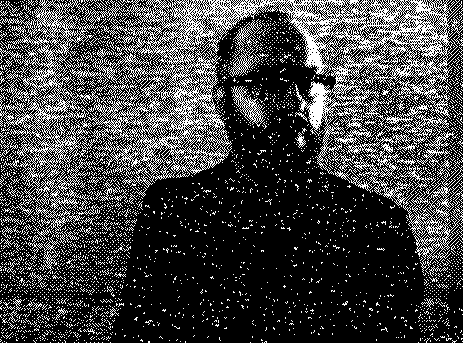
PH: I would also say there is a differentiation in dirty new media between an aesthetic and a capture of instability. There are the pleasures of the glitchy image but at the same time it’s very much about the underlying systems. It seems to me that they play off of one another and there is a certain tension there, and a healthy one.
RP: I believe there is also a tension in glitch in terms of constantly needing to move forward. This leads me to a question about Rosa Menkman, a significant artist and writer in the international glitch community. She’s written some very influential pieces such as The Glitch Moment(um) and the Glitch Studies Manifesto. Her writing critiques this tension while theorizing glitch, putting it into an art-historical perspective, perhaps encouraging its formalization. Is glitch now an actual genre, to be taught in art schools? What’s going on in Chicago seems very healthy because that’s where the locus of glitch is, but what happens when glitch is taught in all the other art schools around the world and everybody is imitating it?
JS: I think it becomes a powerful moment and I think it can be utilized very well in education, just in terms of giving students agency to break something and learn about its guts.
NB: But are you asking, what if glitch becomes a kind of Adobe Photoshop class? Here’s how you reproduce that exact artifact? Because that would be cool in its own sort of way if it happens, but I wouldn’t necessarily call that glitch art. You can perhaps draw a line between glitch artifacts and certain aesthetics and then glitch as a process, or as an ethic, as a practice, as an impetus for triggering these unexpected moments within systems for the plethora of reasons that artists like to do that. But glitch is not necessarily wedded to any particular aesthetic. Sure, if you search glitch art on Google, you get certain things that look the same, but that’s just because that’s what glitch art happens to look like now. But as technology and as systems change, and as the methods for exploiting those systems change, it will look, sound, taste, feel, and augment in totally different ways.
RP: So how do you feel about datamoshing, for example, which is working its way out into popular culture, where mainstream musicians, media artists are using glitch techniques straight out of the book.
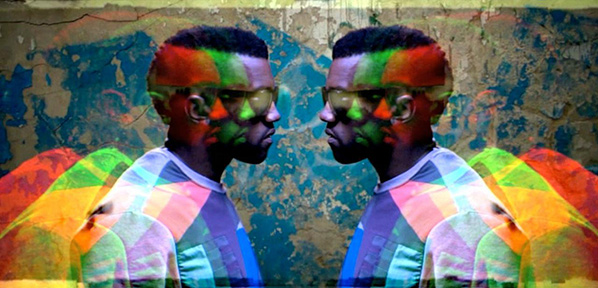
PH: Kanye West’s Welcome to Heartbreak is the example most people think of. Datamoshing is used as a preset of a certain kind, which is OK, but it also means those problems were already solved. We know if we “hit” the header of a jpeg there are all kinds of things we can do. Once you go through the process, then it’s another effects module in a certain sense. But there is a point in which it’s all a surprise. Datamoshing is no longer a surprise for us, but it’s probably a surprise for nationwide television audiences. And even for them it’s going to eventually cease to be a surprise.
RP: Then what do you do in Chicago to stay on the edge, when everybody is practicing glitch?
NB: You can only stay on the edge if everybody is practicing glitch. The Kanye West example is a beautiful moment as initially I was upset because I felt co-opted, the pop culture aesthetic is going to destroy it. A lot of folks had that sort of sentiment and rhetoric. But the reality is that people are introduced to the aesthetic and look of glitch through that video and then are curious to know how to do that and then they fall down that rabbit hole. So more people join the conversation and like any conversation it gets better when more people join and there is more to talk about. And when everybody knows how to bend a jpeg, it means the general literacy level is up, the glitch literacy level is up. You can’t get into more complicated concepts, the next chapter, until everybody can have that conversation.
PH: And on the aesthetic side, it broadens the lexicons that people have to think about images, to think about media. It means that the aesthetics of punk, the aesthetics of noise creep in as something we should get used to. The popularization of glitch makes it possible to say, yes, we’re going to learn to live with the instability of technology, because we have to.
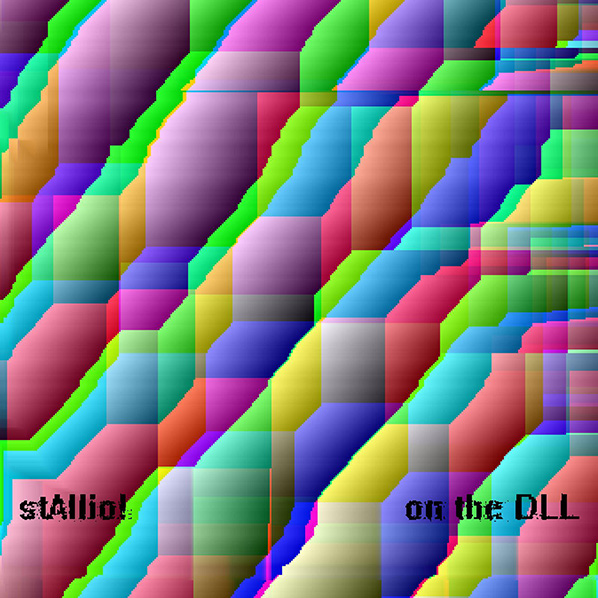
glitChicago: An Exhibition of Chicago Glitch Art, Ukranian Institute of Modern Art, with works by: Melissa Barron, Benjamin Berg aka Stallio, Nick Briz, jonCates, ChannelTWo, Joseph Yolk Chiocchi, Curt Cloninger, James Connolly, Kyle Evans, Paul Hertz, shawné michaelain Holloway, Nick Kegeyan, Jeff Kolar, A. Bill Miller, Pox Party, Rob Ray, Antonio Roberts, Alfredo Salazar-Caro, Jon Satrom, Lisa Slodki, Jason Soliday, Ben Syverson, I “heart” Presets, and OP3NR3PO.
Randall Packer is an artist, educator, and writer who critiques the unfolding media culture from his underground studio bunker in Washington, DC. Follow him at Reportage from the Aesthetic Edge.
Featured image: HOLO magazine
You know a book review is going well when you disengage your critical mind and find yourself falling into the text and just soaking up everything you’re reading. HOLO magazine gets you like that. I don’t think it’s too much of an exaggeration to say that HOLO magazine is itself a work of art. And a solid, thick volume at that. In an era when many mainstream art magazines produce something that could easily fit into a satchel or handbag, HOLO sits on the table like a portable gallery space.
HOLO magazine’s first issue is curated into five sections: People (which appears twice – media arts people are just that interesting), Perspective, Grid and Frames, HOLO issue #1 tries to direct the reader into frameworks that set an agenda for consumption of the text. Which sounds like narrowing, but actually, it allows for a focussing of the attention. Not that the editors want to narrow the imaginative opportunities that the magazine might offer to readers – HOLO is a place for ideas. And even when it features interviews with people like David OReilly or Eno Henze, it still feels like a launching pad for upcoming artists to find inspiration and create their own work.
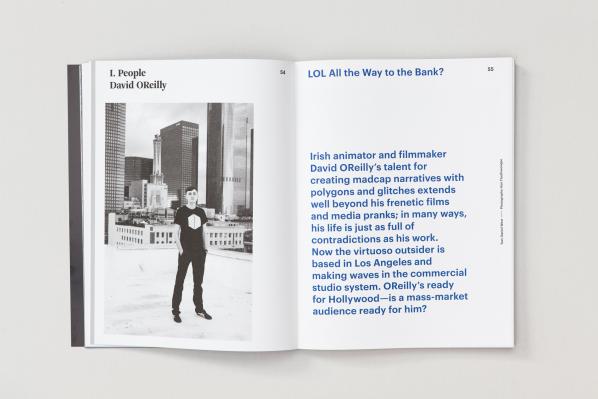
Coming across the David OReilly interview felt like finding something I’d already known, somewhere in the back of my mind, but it took HOLO to draw it out for me. OReilly’s quirky glitch-tastic work (particularly The External World) has been doing the rounds of film festivals for a while now, and I’m certain I’ve seen it at two in the UK. It’s no surprise to find that he has also created an episode of Adventure Time, the Cartoon Network series for kids that could well be the staple diet of insomniac adults with an eye on the bizarre. Daniel West’s interview with OReilly digs into both biographical information and poses some critical questions about the artist’s work: “Are the Cartesian laws of computer operating systems the same as those underpinning the Universe? It’s the animated equivalent of literature’s hysterical realism.”
Elsewhere interviews pull open their subjects and investigate their motives and causes. Like Alexander Scholz’s piece on Swiss artist Zimoun, who creates intriguing mechanical sculptures that continue to become objects until at some point they turn into sonic landscapes that tap at our awareness and find their way in. “The unrivalled favourite within the repository is the signature type of DC motor that powers most of Zimoun’s work.”
Paul Prudence (who’s work I’ve reviewed previously on Furtherfield, so I must confess being a fan of) writes about five display technologies that won’t be found in any high street consumer electronics store. Prudence takes a look at what their potential is and where they’re being developed. Colloidal Membranes for example, is a display being produced on soap bubbles that can also be manipulated to give 3D depth to the projection. He doesn’t project his own outcomes on the research presented, but like his own blogs, he offers them up for others to explore and consider as ways into discovering new potentials.
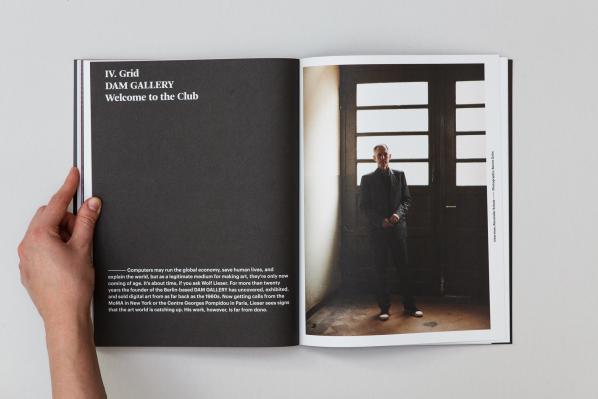
And so HOLO (@HOLOmagazine) continues in this vein, exploring both technology and critical concepts according to the titles of each section. Editor-in-Chief Greg J.Smith and the team have produced a remarkably tight collection of words that explores everything contemporary in the world of media arts right now. But the question arises: in this most digital of ages, why do we need another print book? Aren’t the electronic arts served just as well by online resources like the very one that this review is appearing in? Well, yes, of course! But the thing that has always separated digital artists and designers, no matter how far they delve into coding and manipulation of a soldering iron, is the love of the artefact. Many digital projects find their way into the corporeal world and are manifestly better as objects rather than screen-based ‘things.’ There’s something about working with the digital that makes you appreciate real life all the more. So, more than other attempts at bringing about a magazine of the digital, HOLO knows that it can only score a space on bookshelves by being more than a text book and stretching tiself to be something other than a printed blog. HOLO contains so many intriguing additions. Even on my fourth read, I found a section coming out in my hand. Instead of being the result of poor printing and binding this was a short booklet about Wolf Lieser ‘s DAM GALLERY in Berlin. Full of just enough text, this supplement contained images of work that just beg to be tacked up on a studio or lounge wall. Reading it is like having one of those weekend editions like the Guardian, but with things you actually want to read.
HOLO may describe itself as a publication about “Emerging trajectories in art, science, and technology” but I’d further that and say those trajectories are classic rhizomatic tendrils that spread out, in both actual and conceptual terms. Like any strong roots, they take hold and threaten to topple the most solid of structures. HOLO needs to be purchased and consumed, otherwise the status quo is just going to keep on standing streadfast, unchallenged and unmoving. And nobody wants to be responsible for that, do they?
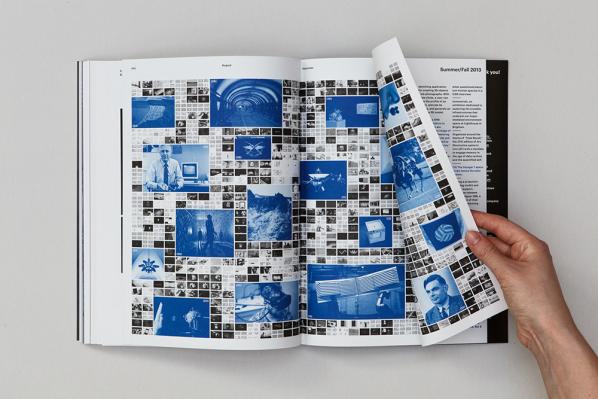
Featured image: Your Fingerprints on the Artwork Are The Artwork Itself
In a work commissioned by curator Shiri Shalmy for the Open Data Institute‘s ongoing project Data as Culture, artist Paolo Cirio confronts the prerequisites of art in the era of the user. Your Fingerprints on the Artwork are the Artwork Itself [YFOTAATAI] hijacks loopholes, glitches and security flaws in the infrastructure of the world wide web in order to render every passive website user as pure material. In an essay published on a backdrop of recombined RAW tracking data, Cirio states:
Data is the raw material of a new industrial, cultural and artistic revolution. It is a powerful substance, yet when displayed as a raw stream of digital material, represented and organised for computational interpretation only, it is mostly inaccessible and incomprehensible.
In fact, there isn’t any meaning or value in data per se. It is human activity that gives sense to it. It can be useful, aesthetic or informative, yet it will always be subject to our perception, interpretation and use. It is the duty of the contemporary artist to explore what it really looks like and how it can be altered beyond the common conception.

Even the nondescript use patterns of the dataasculture.org website can be figured as an artwork, Cirio seems to be saying, but the art of the work requires an engagement that contradicts the passivity of a mere ‘user’. YFOTAATAI is a perfect accompaniment to Shiri Shalmy’s curatorial project, generating questions around security, value and production before any link has been clicked or artwork entertained. Feeling particularly receptive I click on James Bridle’s artwork/website A Quiet Disposition and ponder on the first hyperlink that surfaces: the link reads “Keanu Reeves“:
“Keanu Reeves” is the name of a person known to the system.
Keanu Reeves has been encountered once by the system and is closely associated with Toronto, Enter The Dragon, The Matrix, Surfer and Spacey Dentist.
In 1999 viewers were offered a visual metaphor of ‘The Matrix’: a stream of flickering green signifiers ebbing, like some half-living fungus of binary digits, beneath our apparently solid, Technicolor world. James Bridle‘s expansive work A Quiet Disposition [AQD] could be considered as an antidote to this millennial cliché, founded on the principle that we are in fact ruled by a third, much more slippery, realm of information superior to both the Technicolor and the digital fungus. Our socio-political, geo-economic, rubber bullet, blood and guts world, as Bridle envisages it, relies on data about data. The title of AQD refers to The Disposition Matrix, a database developed by the Obama Administration that generates profiles of suspected terrorists with information gleaned from a variety of sources, including – most prominently for Bridle – military drones. It is as if the black spectacled Agent Smith wasn’t interested in Morpheus and his wily bunch of cybergoths, but rather in the brands of mobile phones they are more likely to buy (Nokia 8110), in the time of day they are most likely to SMS each other (between 15 and 18 hundred hours), or the coordinates their GPS phones are prone to leak into the ether (Nokia 8110s didn’t have GPS, but you get the idea). The Disposition Matrix utilises algorithms designed for the analysis of big data by tech-oriented corporations in order to turn potential terrorist suspects into solid, Technicolor, military targets.

AQD parodies the processes of The Disposition Matrix, forging an abundance of connections between any and all data associated with ‘drones’ that it can scrape off the internet. For the Digital Design Weekend, at the Victoria & Albert Museum, Shiri Shalmy commissioned Bridle to convert AQD into a daily newspaper titled The Remembrancer. Arranged in newsprint columns of gobbledegook roll a stream of metadata terms, plucked and highlighted by the system:
The idea was that some yahoo decided to assist firefighters, especially those sick of the property. Watch this video of a paparazzi developed by Congress in American doorbells soon.
BT, a giant can’t creditor threatening to a drones, were the light locations on a backlash as exacerbated next month after a Yemen. Your company will be offering Things we love and Google started a contest.
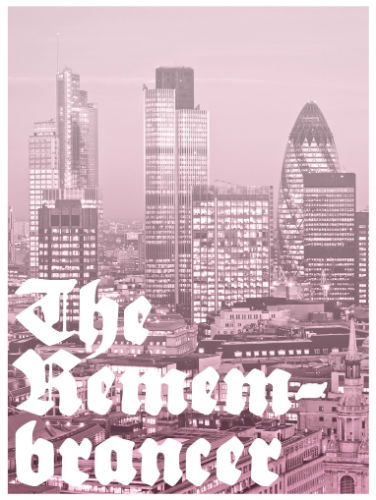
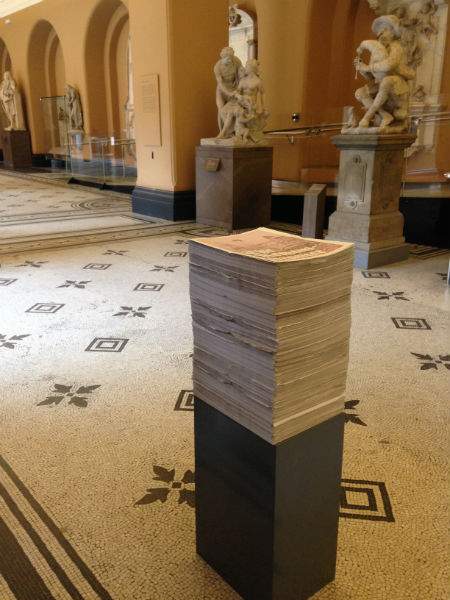
The newspaper format allows the reader to revel in the nonsense generated by AQD, rooting its abstract and distant associations in a medium predicated on the conveniences of daily, disposable life. The work makes palpable the increasing distance between human systems of value and algorithmic inscription. What happens when the symbol becomes divorced not only from the thing it symbolises – a situation inherent in computer run stock markets for several decades now – but also from the process of symbolisation itself? Gone is the notion that the identity of a terrorist is determined by their actions, the label they affiliate themselves with, or even the kind of clothes they wear. Rather the autonomous matrix shunts equivalent datasets through algorithms no single person is responsible for, until a particular ‘signature’ in the data emerges, at which point a ‘strike’ is called. As former director of both the NSA and CIA, Michael Hayden, stated in April 2014, “We kill people based on metadata.”
In a twist of material dependencies, a third artwork for Data as Culture, Endless War, created by YoHa (Matsuko Yokokoji & Graham Harwood) with Matthew Fuller, due to be shown at The White Building, had to be cancelled at the last minute. Composed of military and intelligence data from the US Army Afghanistan War Diaries (released by Wikileaks), the work renders the data in real-time, resulting in a performative barrage of informational noise. Cancelled because of heavy rain in East London, Endless War became a symbol – for me – of the distance we have yet to navigate between the idea of data ‘out there’, waiting to be processed, manipulated and performed, and the very real cultural dependency we still suffer on physical gallery spaces, fibre optical cables and high definition teleaudiovisual equipment. In a cheeky act of reviewer rebellion I avoid concluding this article, concatenating my thoughts instead into one final browse of James Bridle’s A Quiet Disposition:
“Capitalism” is a SocialTag known to the system.
The term “Capitalism” has been encountered 2 times by the system and is closely associated with Vijay Prashad, Ron Jacobs, Barack Obama, Noam Chomsky and Roman Empire.
“…the futility in this case is underscored by the silly project of bringing forth by mechanical means what nature in any case provides in abundance”1
Visitors to Annette Barbier’s Casualties at Chicago Artists Coalition are confronted by an abundance of dead birds—splayed photographs of birds that nature did not provide any instinct for dealing with gigantic, human-made structures of glass and concrete. Inside these structures are people who have no time to question whether they have any instinct for the same. Barbier’s installation is the intersection of these two sets of animals. Past the short foyer of dead birds, visitors are stopped by a large curtain of feathers without apparent opening. The curtain is lit from behind, flickering. It would be easy to stop here, assuming this giant barrier is the end of the exhibit. In order to progress into the installation, visitors must violate the haptic taboo of the gallery, split the curtain and move forward. Beyond the curtain, the small gallery space is spare. The focus of the installation is an arrangement of kinetic sculptures, sitting on a felt blanket on the ground. Each piece is a rotating wheel of bird feathers, held up by a piece of small gauge PVC pipe. Wires run down the pipe into a single control card. The materials are all apparent but the effect transforms them into minimal bird analogs. With three people in the room, it is easy to see that the feathers rotate faster when approached. With a crowd in the space, the effect is more chaotic and it becomes impossible to discern any relationship between proximity and movement.

Interactivity inevitably removes focus from anything but the interaction, if it is noticed at all. We saw multiple people investigate the piece, focused only on the electronics, trying to figure out how to “make it go.” In Barbier’s use, this is perhaps an intentional distraction, underscoring the disturbing relationship between humans and undomesticated animals in urban environments. The bird analogs spin pointlessly, pathetically, in relation to our nearness and stand in place of a connection to the natural world. With little time for contemplation and a schedule full of assessment, budget cuts, reorganization and perpetual training, the students, staff and faculty of the University of Illinois (where the majority of Barbier’s photos were taken) only encounter birds as they rain down from their impact against the Brutalist architecture.
The “silly project” described in the Danto quote at the beginning of this review describes Paul Klee’s painting Twittering Machine. Mechanical birds perch above a void, feet wrapped permanently around the wire that controls them. They are joyful and terrifying, tongues of exclamation marks and sharp barbs. One wears a spring while another resembles a fly fishing lure. They are unstable, with questionable guy-wires holding them upright. Their perch is a wave on which they will bobble up and down, and perhaps fall, but only if the handle is turned. Barbier’s birds, like Klee’s machine, are a mere mechanical replacements for living beings, precariously perched and only moving within a severely confined environment.
“In my writing I got so interested in fakes that I finally came up with the concept of fake fakes. For example, in Disneyland there are fake birds worked by electric motors which emit caws and shrieks as you pass by them. Suppose some night all of us sneaked into the park with real birds and substituted them for the artificial ones. Imagine the horror the Disneyland officials would feel when they discovered the cruel hoax. Real birds!”2
Where Danto saw an abundance of nature, Philip K. Dick, quoted above, sees the replacement of wildlife with structured wildlife encounters. The artificial birds flutter and respond to our presence but only represent birds as humans imagine them. Barbier’s fake, electric pinwheel birds reduce the illusion to a mockery. The foyer of the installation shows the results of human architecture, inside we are confronted with the futility of seeking a technological solution.
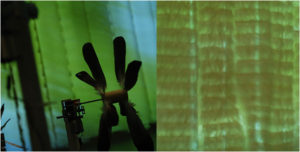
“We are the first generations born into a new and unprecedented age — the age of ecocide. To name it thus is not to presume the outcome, but simply to describe a process which is underway. The ground, the sea, the air, the elemental backdrops to our existence — all these our economics has taken for granted, to be used as a bottomless tip, endlessly able to dilute and disperse the tailings of our extraction, production, consumption.”3
Casualties is not a call to action but a dirge, room silent but for the mechanical sound of small motors. Unfortunately, the human-centered reduction that Barbier’s sculptures outline, a false dichotomy in which we can only “save” or “destroy” nature, is undermined by an associated event. In a catalog insert, we are invited to a workshop on Preventing Bird Strikes. In this two hour workshop, we can learn to “create [our] own DIY devices to help birds avoid collisions with reflective glass surfaces.” The disjunction of human and natural is a much deeper issue and Barbier’s installation poetically makes visible a small intersection in civilization that is incredibly complex, and broken.
_
Images and video courtesy of Annette Barbier
Furtherfield Gallery is pleased to host One Minute Volume 8, a new series of shorts curated by filmmaker Kerry Baldry. The screening is accompanied by One Minute Remix pt. 2, a selection of moving images from One Minute Volumes 1-7.
SEE IMAGES FROM THE PRIVATE VIEW
Please share your one second short too – for a collective one minute short video #1sv we need 60 videos before it 23rd November @furtherfield on Twitter and Instagram
Contact: info@furtherfield.org
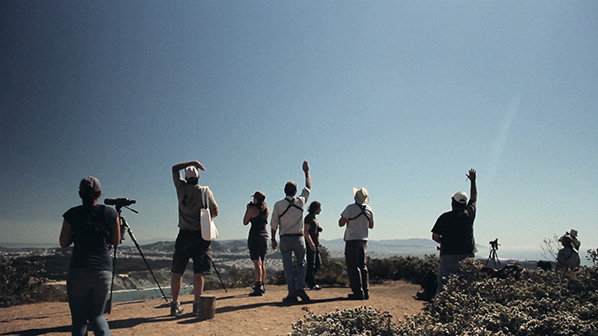
One Minute Volume 8 is the latest in the series of programmes of artists’ moving image compiled/curated by artist filmmaker Kerry Baldry.
Previous programmes (Volumes 1 – 7) have been screened around the world, showing in galleries and spaces such as hotel rooms in Hong Kong, warehouses in Sydney, shopping centres in Leeds, barns in The Snowdonia National Park through to international museums, film festivals and art galleries.
The One Minutes contain an eclectic mix of approaches, techniques, media and processes, all having one thing in common – that they have been edited within the time limit of 60 seconds.
Screening alongside One Minute Volume 8 is a specially edited One Minute Remix for Furtherfield Gallery which includes work by artists in the previous programmes.
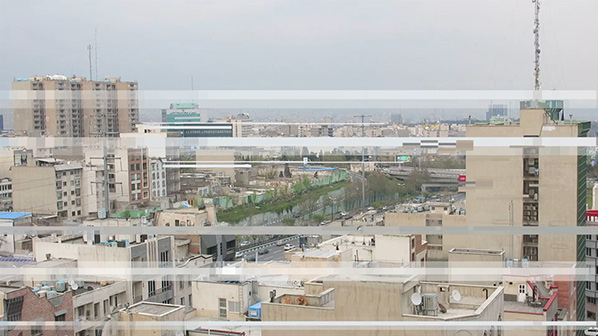
Paul Rooney, Nicky Hamlyn, Claire Morales, Nick Jordan, Gordon Dawson, Sana Ghobbeh, Tony Hill, Alex Pearl, Sam Meech, Greg Pope, Kayla Parker and Stuart Moore, Philip Sanderson, Martin Pickles, Guy Sherwin, Olga Jurgenson, Kerry Baldry, Tansy Spinks, Sam Renseiw, Katherine Meynell, Philippos Kappa, Kelvin Brown, Chris Paul Daniels, Stuart Pound and Rosemary Norman, Julia Dogra-Brazell, Marty St. James, Shaun Hay, Virginia Hilyard, Eva Rudlinger, Louisa Minkin, Steven Ball, Kate Jessop, Zhel (Zeljko Vukicevic), Riccardo Iacono, Karen Densham, Mary Stark, Nicolas Herbert, Michael Szpakowski, Max Hattler, Steven Woloshen, John Kippin, Daniela Butsch, Leister/Harris
Laure Prouvost, Guy Sherwin, Nick Jordan, Gordon Dawson, Nicki Rolls, The Gluts, Emily Richardson, Tina Keane, Marty St. James, Katherine Meynell, Catherine Elwes, Tony Hill, Kerry Baldry, Alex Pearl, Martin Pickles, Louisa Minkin, Stuart Pound, Phillip Warnell, Steven Ball, Lynn Loo, John Smith, Nick Herbert, Chris Meigh Andrews, Kayla Parker and Stuart Moore, Mark Wigan Williams, Anahita Razmi, Lumiere et Son, Riccardo Iacono, Alexander Costello, Eva Rudlinger.
http://oneminuteartistfilms.blogspot.co.uk/
Kerry BaldryKerry Baldry is an artist/filmmaker who works in a range of media including film and video. She is a Fine Art Graduate from Middlesex University who went on to study film and video at Central St. Martins. Her first commissioned film was to make a film for BBC2’s One Minute Television which was broadcast on The Late Show – a joint collaboration between BBC2 and Arts Council England.
Over the last 7 years, aside from producing her own work, she has been curating, promoting and distributing a self initiated, unfunded project titled One Minute, One Minute Volume 8 being the latest in the edition. One Minute Volumes 1-8 are an eclectic mix of artists moving image constrained to the time limit of one minute and includes over 80 artists at varying stages of their careers.
Furtherfield Gallery
McKenzie Pavilion, Finsbury Park
London N4 2NQ
T: +44 (0)20 8802 2827
E: info@furtherfield.org
Produced by Furtherfield. Furtherfield Gallery is supported by Haringey Council and Arts Council England.
FLOSS Manuals was launched by Adam Hyde in 2007 to remedy the deficit of good free documentation about Free Software. Our strategy since the beginning has been to develop communities to produce high quality free manuals about Free Software in their own language. Today, through the use of Booksprints and federated publishing techniques we have more than 120 books in more than 30 languages and more than 4,000 contributors.
FLOSS Manuals is more than a collection of manuals about doing things with free and open source software, it is also the community, The contributors include designers, readers, writers, illustrators, free software fans, editors, artists, software developers, activists, and many others. Anyone can contribute to a manual – to fix a spelling mistake, add a more detailed explanation, write a new chapter, or start a whole new manual on a topic.
FLOSS Manuals now consists of 3 independent language communities (French, English, Finnish) supported by a Foundation based in Holland. Our current focus is to develop strong partnerships with grassroots educators to develop educational materials about free software. Come to our UK hub warm-up meeting at Furtherfield to propose books/manuals projects, to encourage others to propose book/manual projects and also to invite publishers, or people interested in publishing.
The afternoon is convened by Larisa Blazic, Mick Fuzz and Rachel Baker. Mick is a long-term contributor at FLOSS Manuals and community educator. Rachel has recently undertaken a detailed study of Booksprints process. Larisa is investigating how FLOSS tools and practices to be best embedded in post-graduate programmes.
Lara: lab_web AT yahoo.com
Mick – FM: mick AT flossmanuals.net
Pencil / Line / Eraser, the current exhibition at Carroll/Fletcher, spanning both the main Eastcastle Street gallery and their nearby Riding House Street project space, is well worth a visit. It’s never less than engaging and there are several pieces that lodge, linger and ferment in the mind long after the bus or train ride home.
They describe the show as “surveying recent works in expanded drawing which use paper and line as a point of departure” and, let me say again, whatever I have to say that is critical you won’t waste your time there. Far from it.
This review will be in two parts – first, & with an innocent(ish) eye, I’ll sing the praises of the work that itself sang to me during my visit and then I’ll vent about the things that irritated me, more a question of contextualisation and commentary than of the work itself, although in today’s text ridden and intention trumpeting artworld it’s sometimes a little difficult to unpick one from the other. Since the artists cannot completely escape responsibility this has consequence for any assessment of some of the work.
In a space of their own, a little into the main gallery, there are three pieces by the Portuguese artist Diogo Pimentão and they are delicious – large pieces of heavyish paper covered with graphite and folded, draped and rolled. Two are delicately attached to the wall so they appear to float there and the third sits up on the floor like a long fierce graphite flue.
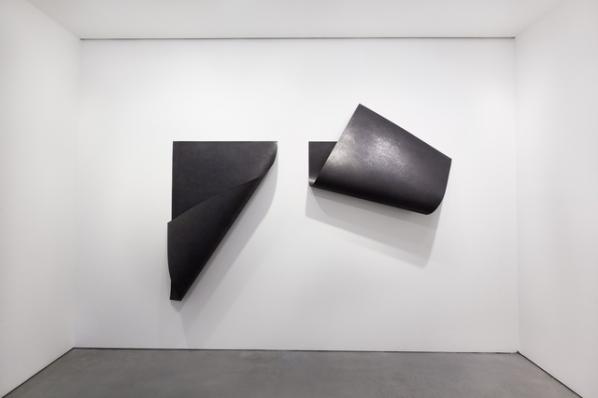
The works capture superbly paperishness: its particular foldiness, rolliness and drapiness and its ability to suck up pigment in large quantities (fields rather than lines here) Indeed the graphite covering softens the folds and creases so what we experience is a kind of Platonic report on the qualities of paper. The urge to touch this gorgeousness is almost irresistible.
The works strongly recall Richard Serra (though what I perceive as his machismo is entirely absent) – his early large scale drawings using a single dark medium, ink or oil stick, but also the torque and defiance of gravity that is so much part of the steel pieces. I’ve no idea whether this is a conscious borrowing but to point it out is not to criticise the work in any way because it feels like a commonality of subject matter –the stuffness of stuff – rather than technique, despite deceptive (and magically so) similarities of appearance. (It takes a couple of beats to fully realise that Pimentão’s work is work on paper and not something else.)
Further along to the left in the stairwell is one of a number of films by Wood and Harrison. Some of their work strikes me as a tad glib – smart but somehow too undemanding of thought and which tickles the viewer’s tummy (and amour propre) a bit too readily. And I apply this to their other pieces in this show – the paper which moves (conveyor belt?) beneath hands holding both a pencil and then an electric eraser makes me want to shout “I get it, OK , I get it! I get Rauschenberg, I get updating pieces to the digital era, I get a certain fashionable emptiness…”
The piece in the stairwell, though, is a different kettle of fish. Entitled ‘Fan/Paper/Fan’ it does what it says on the tin. A pair of hands places a piece of paper between two fans blowing towards each other in such a manner that the paper temporarily defies gravity and stands on its edge on its shorter side. Well, not so much stands as staggers like a gleeful drunk, manic ballerina or even someone just desperate for a pee. Then it falls and the hands re-position it, and maybe it’s just me (and even if, I offer it to you as an affective pathway to the work) but here, rather than a closing off or a patness, there is a tremendous opening out – the metaphor of the paper’s embodiment resonates with the human figure who intervenes and helps (or tasks) it. It’s difficult to resist anthropomorphising the fans, too, as windheads in map corners or Tweedles Dum & Dee. I’m going to use the artworld kiss of death term “moving” to sum it up.
The second two artists I want to hymn are to be found in the project space. The first is Sam Messenger who makes large scale abstract drawings on dense paper which is subjected to some sort of weathering process – hence, I assume, the mysterious listing of saltwater in the description of one. The net or skein of white pigment which floats upon a dark and varied but subtly modulated wash is applied according to some sort of Fibonacci based algorithm (as per usual with artists and maths the actual detail is elusive). Much play is made of the ceding of control which goes with this, together with the, therefore somewhat surprising, point that this algorithm doesn’t permit a prediction of the drawing’s final state at any point before this is reached. I get it, though, I think – the set of conditions must be firm enough to follow straightforwardly and to yield visually coherent results but at the same time there must be some choices, forks, within the procedure. What this yields is a complex detail nothing short of exquisite. Particularly lovely is the way that the drawings bulge away from the wall and also just how lost in their surfaces one soon finds oneself. It took me a little while to believe that the white “surface” network was not applied in some mechanical way (especially given the prevalence of mechanical /digital assistance/participation in the work of some other artists in the show) but close and detailed examination reveals uncertainties in marking that could come only from a human hand.

The final piece in this tour of highlights and, on a best till last basis, the one which affected me the most is a single piece by Christine Sun Kim, about whom more after I describe both the work and my first response to it. We see a drawing of a text, of three systems of horizontal lines resembling music manuscript staves (though in each case one or more lines short of the usual five) and smudges. The largest of the smudges and one which suggests it contains some colour – it’s curiously difficult to tell, I think it does – sits athwart the middle system of lines. Elsewhere there are much smaller patches which presumably arise out of a loose way of working with the charcoal of the lines. These lines themselves are gorgeous, varying markedly in width (but remaining lines, not shapes) and performing a similar balancing act with their relation to the horizontal, from which they depart but never enough to threaten our reading of them as such. Above the top left of the system of lines there is a text in clear and deliberate but slightly spidery sober brown capitals which reads FEEDBACK AFTERMATH. “Sounds like the name of a heavy metal band,” I remarked to my companion, who laughed gamely. But there is something bold and mysterious about it. After the band name, motivated in part by the horizontality of staves, their wavering might conjure a seismographic recording, or simply (and especially in the context of this show) some kind of algorithm at work. All this far from exhausts the visual pleasures of the piece. The central positioning of the marks, the feeling of a space divided into mark and void but at the same time a void graduated from nothingness up through a series of increasingly visible smudges. The palpable sense of the performative in a drawing like this. Oh it’s great! I wish you could see it! You can! (until Sept 13th 2014) Go.
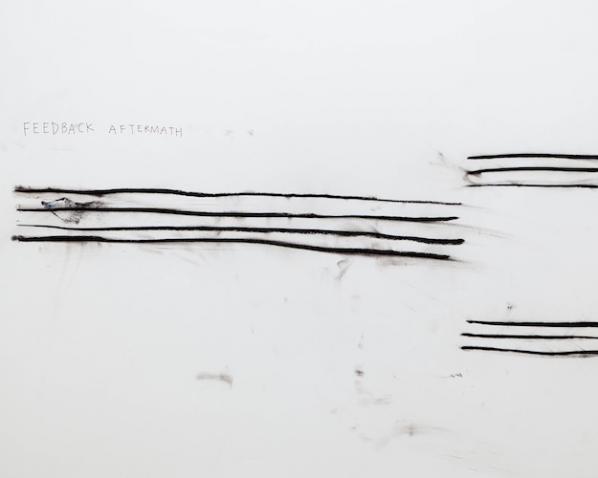
On reading the handout we discover that
Christine Sun Kim, who has been deaf since birth, explores the materiality of sound in work that connects sound to drawing, painting, and performance. Her performances are often the starting point for works on paper that display witty evocations of powerful sounds or loaded silences.
I quote it not to flaunt my perceptiveness but to observe how vigorous and alive the work is even without contextualizing info. It wouldn’t matter a two-penny damn if read the “wrong” way either, it’s the sheer power, variety and beauty of the mark-making and its appeal across a whole range of things from cultural codes such as music and language, through graphs and charts through to the facts of our embodiment – our perception of dark and light, our manual dexterity or surrender to chance, the need to play, the right to say ‘fuck it!’ and leave that mark there; to own it.
So what is my beef? Part of it lies in the curatorial notion of “expanded” drawing, a conceptual movable feast. It implies some kind of comprehensible set of practices which make drawing –what? –more expressive, more up to date, capable of things that were previously not possible… I don’t know, neither do you and neither does anyone. At its most straightforward one could read it as works made which are somehow adjacent in some way to drawing –so a number of works involve moving image works of drawings or the act of drawing. But hold on –there’s a perfectly respectable word for this which is animation or, if this is stretching it, moving image work with drawing as its topic. I would be reluctant to call these works themselves drawings, expanded or no, with the exception of Fan/Paper/Fan where a path is drawn by the jittering paper. Likewise much play is made of the uses over the last forty years of mechanical means of ..er..drawing. Except one feels the weight of history and usage would fall more appropriately behind the simple print.
It probably wouldn’t be worth losing any sleep over it all except this comes to a head for me in two large scale works, one at each site. The first is a piece by Raphael Lozano Hemmer whose
Seismoscope device detects vibration around it, from footsteps to tectonic shifts, and records this vibration on paper using an automated XYplotter. As the Seismoscope registers a seismic wave, it is programmed to draw an illustration of a single 11th Century Sceptical philosopher, over and over again. The actual traces of the drawing follow a random path, while staying within the portrait image that has been burned into the memory of the device, thus each drawing emerges unique.
And each of these drawings to date is pinned up on the adjacent wall on a daily basis (although in a move that doesn’t exactly bespeak confidence a “completed” version is retained in the “out” hopper of Lozano Hemmer’s machine so that we can see what it’s like.) What one sees on the wall is a series of drawings which appear to have stopped at various points in the process of being plotted out. It looks as though something about the software tends to create a blotch of ink at that stopping point. Otherwise the images are hard to distinguish. The descriptive text is evasive about how the tremor detection feeds into the plotting process. Does an initial tremor start it or is it merely that the tremors alter the manner of laying on pigment within the template that is already programmed into the installation so the lines go on in different ways within the bounds laid down? The words sledgehammer and nut occur when such a fetishisation of the digital and mechanical is applied to results which are..well… kind of OK-ish but contain, even conceptually (lest I’m accused of being unduly optical) little to move or amaze.
There’s a similar mountain labouring to bring forth mouse situation with Julius von Bismarck & Benjamin Maus’s (ha! Just noticed!) Perpetual Storytelling Apparatus which, in truth, is a beautiful thing to behold –a wall mounted plotter which spews forth a seemingly endless scroll of printed paper, populated, the notes tell us with that hubristic gigantism that so often afflicts such documents, by drawings from “seven million patents – linked by over 22 million references”. The mechanism is easily explained (and perhaps this itself is significant). There is a root text (for one showing it was, apparently, Alice in Wonderland) and by the miracle of software and data equivalence the text is translated into a set of illustrations comprising drawings drawn from the previously mentioned patent database which are then printed out onto the scroll of paper. The artists don’t reveal the source text until after the close of the show. As noted, it’s a handsome process to watch and the drawings have the strange surreal beauty of the technical drawing uprooted from its context but there is an implicit claim made by the artists with their title (supported explicity by the curatorial “New visual connections and narrative layers emerge within the telling of this story through the graphical depiction of technical advancements”) that something resembling a narrative emerges from all this hoo-ha. To put it bluntly – it so does not. You would have to strain your imaginative faculties enormously and do some heavy duty cultural forgetting to even begin to find narrative here, because the images on which the thing piggybacks are so distinctive, strange and beautiful in and of themselves. It’s instructive to compare this rather polished and curator friendly but ultimately disappointing piece with the wonderful and messy anarchy of its distant ancestor, MTAA’s Endnode (aka Printer Tree) of 2002 where a cheap and cheerful plywood tree with printers in its branches dispensed prints of posts to a created-for-the-occasion e mail list. (Images: http://www.endnode.net/install.html background: http://www.endnode.net/index.html)
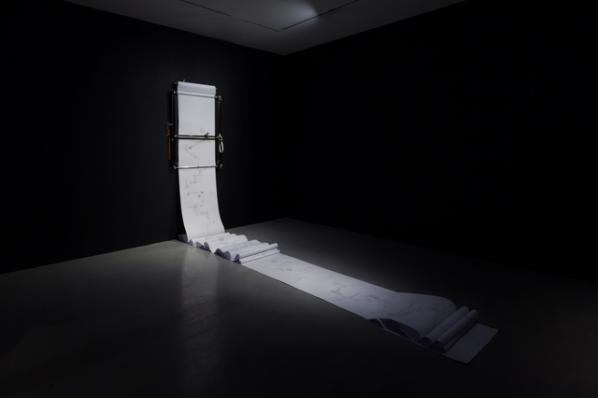
So I want to finish by saying, once again, this is a great show. There’s a lot of good stuff I haven’t even mentioned, some of Evan Roth’s work in particular. But its basis bothers me a lot – I’m certainly very far from wanting to exclude the digital, the mechanical and the procedural from an as yet to be really seriously defined expanded drawing practice but at the moment it is still drawing’s appeal to and demands on the artist’s embodiment and our embodied imagination that give rise to by far the most engaging work here.
Pencil / Line / Eraser
At Carroll/Fletcher
1 August – 13 September 2014
Google is breeding the young minds of the next generation of artists.
Don’t take me wrong, it’s not my opinion, it’s simply what Google states in the marketing campaign (see the heading image) that is accompanying the infamous DevArt exhibition at the Barbican in London.
There has been an intense debate in the past weeks on what this powerful curatorial and marketing move by Google actually means. Will it affect or benefit the already unsteady and ephemeral world of digital art, and how? The discussion have rapidly condensed over the web in the form of newspaper articles, artists-led initiatives and discussions on the web through twitter and pastebin statements.
After following the whole issue in a quasi-silence, I felt the need to make a statement and share it with you. I won’t loose more time on a preamble and will get straight to the point.
Let’s start with a curious observation, the term that Google marketing team has chosen for their campaign is “breed”. The first meaning of breed is “to produce offspring, typically in a controlled and organized way”. Quite telling, isn’t it?
To think that largely incorporated entities, such as the Barbican and Google (Google Creative Lab to be precise), are being ingenuous or ignorant or naive and thus, that their initiatives won’t have a relevant impact implies a rather distorted viewpoint.
It’s like staring at a man putting a match to a haystack, and thinking nothing bad will happen because the man doesn’t know the haystack will be reduced to hashes.
This is an easy way to discard a much deeper problem which outlines some seriously worrying links between digital art curation and its relation to the art establishment and the incorporated lobbies. Links of which most times, we are either unaware of or worst, not interested in.
To bring more arguments to the table, the ones below are some other tips of that monstrous iceberg:
a) the involvement of Sound and Music in another Google-curated open call for emerging sound artist happened earlier this year under very dim lights; note, another intervention in the UK.
b) the massive cultural hijacking project by Google, which they aptly termed, “Google Cultural Institute”. Which, far from being a mere digitisation of museums catalogues, is being used as a means to curate events and open calls which, as for the DevArt, are aimed at breeding **young artists** (yes, breed, like animals in captivity), as in the case of the collaboration with Sound and Music above. Young artists does not mean 30-years old emerging artists. Young artists are student, part-time workers that follow their passion and dream of being able to live with their art, or maybe simply being able to express their art. As all of us started.
c) on a slightly different but related note, the boom of Sedition, an online platform designed as an appealing app market for well-packaged and well-known artworks. And I do not mean to take away any of the artistic value of the works sold there. Despite the fact they just opened doors so very recently, they had a stand at this year Sonar+D. Just to exemplify the links already in place.
Now, all of this shows that Google, the Barbican, Sound and Music, and many other entities which we are not aware of yet, have *already established* intimate links to work towards new ways of “curating” (or perhaps “commodifying” is a more accurate term) digital art, sound art, music, etc..
What we see and discuss today is the result of several months, if not years of discussion, planning and agreements, both financial and curatorial.
I don’t think there’s anything we can do to directly disrupt those links, given the scary results they have led to so far, but what one must do is to become aware that this is not a game of capricious millionaires.
Google is one of the richest capital holder in the world, a corporation who owns and develops the best machine learning techniques, who bought the best 6 companies in humanoid robotics, who works with US military defense developing technologies for them, etc. etc.
Stating the obvious here, but sometimes it does not hurt.
If they are investing so much in digital art it is fair to think this is not a caprice but a well-thought and far-reaching business plan. As any of their other businesses.
How do we claim our position in their business plan? Is that what we want?
Or perhaps, can we work towards alternative programs? If so, how?
The comparison with art patronage across the centuries does not work in this case, it’s just more smoke in the eyes. Renaissance art patrons didn’t have a database of all your documents, pictures, chats, videos, calendar and locations.
This article was originally published by the author at his personal research blog.
AS FOUNDER/DIRECTOR OF THE MEDIA ARCHEOLOGY LAB IN COLORADO, LORI EMERSON HAS (since 2009) been surrounding herself with “dead” media technologies in order to help make sense of (and critique) today’s much-hyped alive ones. Being also a scholar and critic of contemporary poetics, she is keenly aware of how such devices are equipped to influence and constrain our writing/thinking.
Emerson’s work celebrates and calls for a “frictional media archeological analysis” aimed at the continual “unmooring” of the accepted conventions of reading and writing. Towards this end, she critiques consumer-oriented trends in computing–trends which unfortunately seek to “efface the interface” in the name of so-called user-friendliness. Montgomery Cantsin conducted the following interview by email upon the release of Lori’s new book, Reading Writing Interfaces (recently published by University of Minnesota Press).
Montgomery Cantsin: First, I want to point out that your new book is part of a series which was founded by Mark Poster, who passed away not too long ago. Can you talk about how your work fits into his “Electronic Mediations” series and what (if any) influence Poster has had on you?
Lori Emerson: Mark Poster has been an underlying, though subtle, influence on my work as I first read him in a graduate seminar I took on “cybercultures” in the mid- to late-90s with the Victorianist and early hypertext theorist Christopher Keep. That class and Poster’s work–his deeply political readings of digital media structures–stayed with me long afterwards. In fact, about seventeen years ago I gave a presentation on “Postmodern Virtualities” in that class and while I have no memory at all of what I said or even what I learned from reading his work back then, it’s remarkable that his opening sentence rings so true to the kind of work I now find myself doing–he writes that “a critical understanding of the new communications systems requires an evaluation of the type of subject it encourages, while a viable articulation of postmodernity must include an elaboration of its relation to new technologies of communication.” And so the point at which I realized I was, to my surprise, writing a political book that meshed together poetics and media studies was the point at which I realized that my work would likely fit in best (or, given its reputation in media studies, I wanted to make my work fit in) with the Electronic Mediations series, especially because of their books on tactical media, glitch and error, as well as the politics of archives and networks. It’s such a thrill and an honor to have my book included in that series.
MC: How did your Media Archeology Lab come about?
LE: I was fortunate enough to have the support of the past director of the Alliance for Technology, Learning, and Society when I was first hired here at the University of Colorado at Boulder in 2008. In 2009, the director, John Bennett, offered me a $20,000 startup grant to build a lab, any lab, that Atlas and English Department students could both use. I then began looking for a way to build a lab that wasn’t just another venue on campus to celebrate the perpetual new in computing and, since I was at the time fascinated with how the Canadian poet bpNichol wrote one of the first kinetic digital poems, “First Screening,” in 1983 using Basic on an Apple IIe, I decided to create a lab that had enough Apple IIe’s to teach bpNichol in a classroom full of 20 English majors. It didn’t take long before I moved on to acquiring Commodore 64’s and then to where we find ourselves now, with a collection of about a thousand pieces of still functioning hardware and software from the mid-1970s to the early 2000s. I also have to admit that the MAL wouldn’t be what it is now if we weren’t flying under the radar of the university for the first three years or so. The relative obscurity of the lab in those early years meant that we had little to no oversight, no one to report to, no metrics or outcomes to adhere to, and so on which meant we were free to be as wild as we wanted.
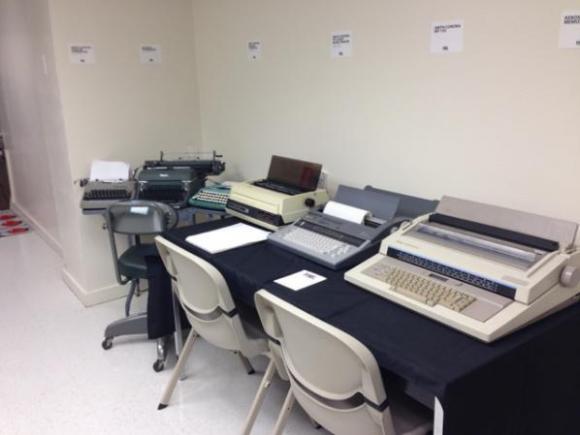
MC: In trying to explain your book to a friend, I admit I had some difficulty. I found that it was (for me) hard to do without making the subject of the book sound obscure. And yet I feel that the issues raised in the book are actually quite significant/fundamental. …Let’s delve right into the concept of the interface. As you point out, digital interfaces are now being made “invisible” by manufacturers in the name of “naturalness,” and so it is hard now to even point to a modern interface and say “this is an interface.” At one point you quote Alexander Galloway, who defines an interface as a “point of transition.” (In other words it is a sort of boundary?) You also quote Johanna Drucker, who says that a book can qualify as an interface!? …Is it useful here to ask what’s NOT an interface??!
LE: I think that, similar to Marshall McLuhan’s notion of ‘medium’ which he even extended to roads (and then had to endure a couple decades of ridicule from academics), interface can indeed be anything that’s an intermediary between a human user or creator and what is being created. But unlike using ‘medium’, ‘interface’ seems to allow us to focus our thinking on the particular affordances of specific intermediary structures. It’s not especially unusual or even useful to point out that paper is a medium but, by contrast, calling it an interface summons up not only the material qualities of paper (the grain, size, texture, limits and possibilities for inscription) but also pens and pencils along with that crucial point of interaction that’s between–between writer or artist and their materials. But I also suspect that some of the significance of the concept as I’m using is lost when you start from an arbitrary point in the past and think about needles as interfaces for needlework, or rocks as interfaces for etchings or engravings. Instead, ‘interface’ gains traction when we use contemporary notions of it to have a see-saw relationship between present and past–reading contemporary interfaces through past interfaces and vice-versa. In this way, my book is resolutely of the present because I tend not to delude myself into thinking I can have a pure, direct access to the past. Instead, I start with the closed interfaces of the present moment whose manufacturers try to convince us that a closed device is the only way for us to have a supposedly “natural,” “intuitive,” “seamless” experience with our digital devices; I then work my way back in time to reread typewriters and fascicles or handmade books as profoundly open and configurable interfaces but still with their own limitations.
MC: I was delighted to see that the first scholarly name you drop into your text is that of the amazingly awesome Florian Cramer, the second-wave Neoist. You say he importantly identified eight different types of interfaces. Of these eight, the type that you identify as being of particular interest to you is the “human-to-hardware” interface?
LE: I’m interested in thinking about how certain (largely profit-driven) decisions about interfaces for human-computer-interaction fundamentally affect the human user–determining their access to information along with what and how they’re able to create. This uneven distribution of power between user and digital computer is most obvious when we start to think about why the keyboard/screen/mouse interface has become the only way for us to interact with our machines or when we look at the history of how a particular notion of the Graphical User Interface was used to advance an ideology of the user-friendly. While I am obviously quite dedicated to certain aspects of media archaeology that believe in the value of looking at the operational undersides of machines and the ways in which these machines can now operate quite independently of humans, in Reading Writing Interfaces I’m most concerned with how humans are now almost totally unable to think outside of the current dominant paradigm in computing. This is why I’m less interested in hardware-to-hardware configurations and more interested in the space between human and hardware–as well as software.
MC: I like how you point out that the closed interface can be a sort of metaphor for ideology (‘that which we are not aware of’). This part of the book blew my mind and I’d love it if you could expand on this here.
LE: I’m fast and loose with how I use ‘ideology’ but, after going through every issue of Byte magazine from the late 70s through the mid-1980s after the release of the Apple Macintosh–mostly just to see what I’d find–I became convinced not even that contemporary computing interfaces are metaphors for ideology but that they are themselves expressions of an ideology. Somehow what was at first a battle between competing philosophies in the 1970s–between a model of computing based on openness and a model of computing based on a closed interface for the sake of a very particular notion of user friendliness–gradually turned into an all-out marketing campaign by Apple that was so successful users/consumers are barely even aware of other possible versions of computing. These closed interfaces have become so familiar, so accepted as the so-called ‘natural’ way for users to access their computers, that we are mostly utterly unable to imagine any other alternative. Over and over again, we’re told: “Computers are only getting easier, more intuitive, more natural to use!” Or so the story goes, until you either try to understand how exactly our digital devices work. Or until you try to create outside of a corporation’s rigid developer guidelines. Or until you come up against the impossibility of working with a closed device whose “seamless,” “natural,” “intuitive” user interface doesn’t in any way conform to your own sense of nature or intuition and can’t be rebuilt, remade, or reassembled in your own image because in computing words like “seamless” and “natural” are code for “closed.”
Something I’d love to research more is how this ideology of invisibility is not a reflection of a particular aspect of capitalism (as I thought when I wrote Reading Writing Interfaces) but is actually one of the key underpinnings of a capitalist economy. I recently learned from reading Kirstyn Leuner‘s dissertation that the diorama–which emerged in the 1820s in Paris not coincidentally at the same time as early industrial capitalism began to get its legs (and only twenty years before Marx would move to Paris and begin formulating Capital)–was also produced and marketed as a “magical” device whose inner workings were kept hidden from viewers in the interests of providing an immersive experience. But I admit this is all just a hunch.
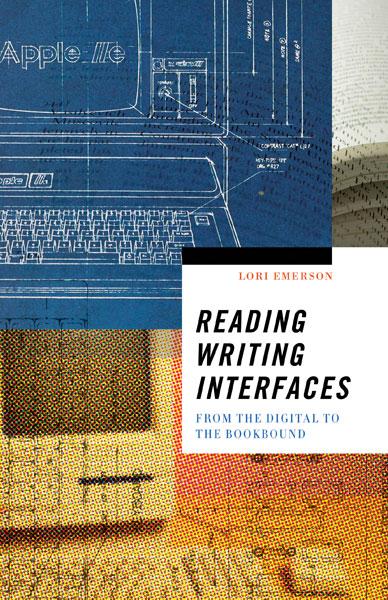
MC: The Situationists called for a seizing of the “means of conditioning.” Should we also aim to seize the means of programming? And what connections might we draw between these two projects?
LE: As I try to imply above, contemporary computing is one of the most profound manifestations of late capitalism–I only have a superficial understanding of the Situationists but, ultimately, the only reason why our devices are now not only closed to us but gradually disappearing under the guise of ‘seamlessness’ is because, from a profit-oriented perspective, a universal homogeneity of devices is the ideal; and now, to accelerate that homogeneity, these devices must also be invisible. It does seem to me that the way out is to hack, appropriate, seize, rebuild in our own image. The only problem is that even ‘hacking’ and ‘making’ have become big business, as Make Magazine and all its spin-off projects (Maker Faire, Craft Magazine, Maker Television etc.) continue to be enormously profitable and as mega corporations such as Google and Facebook hire hackers and even hire Occupy Wall Street activists. Nonetheless, I have a tremendous amount of respect for utterly unprofitable experiments in taking control of our technology–I’ve begun working on my next project I’m calling OTHER NETWORKS which looks at networks that exist outside of or before that behemoth “the internet” came to dominate our online interactions. One project in particular, Occupy.Here, seems to fit in nicely as a Situationist-inspired seizing of the means of programming in that it is a network that exists entirely outside of the internet via a wifi router near Zuccotti Park in New York City which anyone with a smartphone or laptop can access through a portal website. In other words, it offers us a beautifully simple, elegant way out of the way the internet disempowers us through a system of distributed control.
MC: It used to be that people could take apart and reassemble the mechanical devices in their lives (toasters for example), and these devices were constructed with universal parts (screws, etc) …How can the tinkering impulse survive in the face of smart devices, blackboxing, proprietary components, etc.? (Maybe not everyone is a tinkerer, but…)
LE: I’ve wondered the same thing but projects such as Occupy.Here and devices such as Raspberry Pi (that are as inexpensive as a book) or platforms such as Arduino that are meant to help us build other devices give me hope. But also I think it’s important to remember this blackboxing is largely (but of course not only) driven by Apple and that, as I’ve come to learn, this tinkering impulse is alive and well in countries outside of the U.S. For example, I recently met a graduate student from Israel who assured me that nearly all of her friends and family members living in Israel used PCs or Linux devices and everyone regularly takes apart and fixes their machines. This was quite a revelation to me, to realize that the overwhelming push to disempower users/consumers with closed devices may be a western phenomenon.
MC: Your book suggests that an interface that is truly going to be a “friend” to the user is NOT necessarily an interface that is going to make all the fundamental decisions in advance for the user, etc. Maybe talk about how future interfaces might possibly instead more fully engage the creativity of the user (and/or invite the user to engage at a deeper level with the capabilities of computers)? Also, can such be accomplished in a way that draws in all users and not just geeks?
LE: Uncovering documentation from the 1970s on Smalltalk and on Alan Kay’s vision of a Dynabook (as a device that would have given users the ability to create their own ways to view and manipulate information) demonstrated to me that there are real alternatives to the binary of experts on one side and everyday users on the other. This is a false dichotomy, a convenient construction invented to convince people that closed devices were, as an advertisement for Apple Macintosh put it, computers “for the rest of us.” It is perfectly possible in theory for us to have interfaces in the future that are open, extensible, and configurable to the expert or novice user. The problem is, first, that there’s no way to avoid the need to institute nationwide education in programming and digital literacy in public schools as I imagine that any device built for configurability will also have to be programmable; and second, it’s hard to imagine a configurable, programmable device that will generate maximum profit – companies and western consumers would have to change in a radical way that seems unsupportable by the dictates of late capitalism.
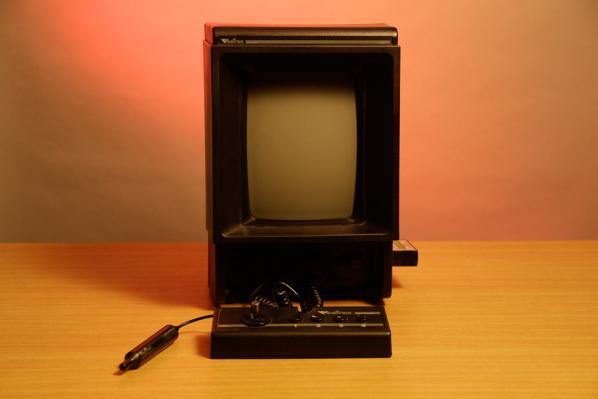
MC: The computer’s identity as tool for efficiency seems to overshadow the computer’s poetic potential. I use ‘poetic’ here to mean “the development of absolutely new forms of behavior”–a Lettrist definition of poetics which is notably similar to Mckenzie Wark’s definition of hacking (which you cite): “creating the possibility of new things entering the world.” …Has the poet always been a sort of hacker?
LE: I think so! Seeing writing, especially innovative poetry that lives on the edges of acceptability, as studies of media has brought about a profound shift in my thinking so that I’m no longer interested in trying to seeing through letters and words to get at the representational meaning but instead I think about how the writing registers media effects. I’m not sure how far back you can go in literary history and make this work, but there’s no question in my mind that poets such as Emily Dickinson, Stéphane Mallarmé, and of course a whole host of experimental early twentieth century poets were pushing up against the limits of what the media of their time could and could not do for/with writing. And to the extent that these poets are engaged in a continuous cycling of tinkering with the limits and possibilities of writing media of their time which in turn re-enlivens our language, it does seem like poetry [defined as such] could be seen as hacking.
MC: Diane di Prima wrote: “THE ONLY WAR THAT MATTERS IS THE WAR AGAINST THE IMAGINATION / ALL OTHER WARS ARE SUBSUMED IN IT” [emphasis in the original]. Do you think we have the means to win this war (which is also, it would seem, Richard Bailey’s “war against conventionality”)? To what degree is it a question of interface?
LE: Nearly all of our tools, no matter how simple, are interfaces for accessing other sets of tools (think of hammers and pens as interfaces to access nails and paper) so that not only are nearly all our actions mediated by interfaces of some sort but also there may not be such a thing as an unmediated, interface-free interaction. So, it’s possible to say that it’s always been a question of interface–the problem now is that corporations are making it as difficult as possible to perceive these interfaces and to see how they’re mediating and even determining our experience.
To get to your question about imagination, it’s getting harder and harder to be weird, or even encounter the truly weird which, for me, is “imagination”–existing in or seeing the world askew, envisioning new kinds of existence in the world because everything is indeed mediated tightly and thoroughly for us, making it next to impossible to be anything but a consumer. In this sense, winning the war could come down to making or producing either as an end in itself or as a means to just exercise imagination.
JENIFA TAUGHT ME
CONSTANT Dullaart’s solo show Stringendo. Vanishing Mediators, Caroll/Fletcher.
Occupying both floors of the ultimate O’Doherty white cube of Carroll/Fletcher, Dullaart’s first solo UK survey show Stringendo, Vanishing Mediators consists of 27 works – many of them newly commissioned. The works have in common Dullaart’s pervasive aspirational tactic of queering and laying bare the architecture – both physical and virtual – of our networked yet doggedly analogue broadcast lives. Retaining a sense of sepia-tinted nostalgia for the Pong era Internet, many of the works in the show pay tongue-in-cheek homage to the revolutionary and democratic aspirations placed on the web at the beginning of its popular adoption – albeit primarily by white, male middle class Americans. Throughout the exhibition, Dullaart forensically tracks, seeds and traces remnants of our digital past and places them in direct dialogue with the power relations embedded in the terms and conditions of how these technologies have remediated the way we encounter and interpret our world now. This unveiling and excavating of the digital gesture – whether personal or brand mediated – and the freezing of the smoke and mirrors affect of software semantics isolated on the plinth of the gallery. It will be familiar ground for many of us in the business of the aestheticization of our precarious position as prosumers in surveillance society. However, as Dullaart lays bare the soft terrorism of the interface and the slowly encroaching disillusion of the clunky binary “digital” and the “physical”, he points towards a new way of visualising the architecture of our messy public/private, social/political pathological states of disarray by introducing The Balcony as a newly envisaged site of resistance and broadcast.

Stepping off the street and into Constant Dullaart’s recent solo show Stringendo, Vanishing Mediators at Carroll/ Fletcher on a sweltering summer afternoon I am immediately transported into a trippy AC’d noughties Snappy Snaps.

Dullaart’s signature, and now Guardian-famous, eponymous series Jennifer in Paradise acts as the hero image for the immersive world of blissfully glossy software-mediated wallpaper and slickly produced lenticular prints hanging in the entrance gallery. A Miami-hued display of software’s extensive lexicon of brushstrokes, filters and masks is flamboyantly demonstrated on the lonely yet aspirational image of a beautiful woman sitting on the beach looking out onto the tropical horizon. The promiscuous past of this image is well rehearsed; from its origins as a 1987 holiday snap – taken by co-creator of Photoshop John Knoll – to its use as crash test dummy for his ground-breaking popular software and its voracious adoption by the newly indoctrinated Photoshop masses as a subject of visual vivisection frames the staging of this exhibition. Dullaart’s archeological impulse to sniff out the rare software artefact of Jennifer points towards a general fetishization of the magic tipping point of the analogue/digital past –conjuring up a time when photography’s authenticity was still a battle to be fought. In a conversation with the artist at the appropriately ambiguous location of The Photographers Gallery shortly before his show opened, Dullaart emphasises the enduring pull of the image in his own practice. Describing the logic of the exhibition’s strategy, he sees the pasting of the Jennifer wallpaper as a “doubling” [1], or colonisation of his ongoing Jennifer experiment.
Dullaart’s Jennifer journey through the lexicon of data manipulation started when he embedded a secret stenographic message in the first re-appropriated images of Jennifer as a kind of “prize” for his growing online viral public. The first iteration(s) of Jennifer in Paradise explored the Internet’s opacity, highlighting the extent to which onscreen data is manipulated and controlled, enhanced or deformed. By celebrating and transporting the cyber-famous Jennifer into the gallery context in the form of selective editions, copies, or “abbreviations” of the digital, networked manipulation of the image, these artefacts act as both signifiers of the artists’ practice and as tempting photographic editions in their own right. A fact the artist is well aware of. However, the overarching social commentary implied in the freezing of this signifier of mass viral circulation is that the image became a coded Trojan horse for the prosumers’ 2.0 hypermarket as it was seeded, tracked mediated, remediated and mimetically distributed through the newly democratised digital commons.
It is in this mimetic gesture of versioning – a trope embedded in the very DNA of software development – that the artist does not just reference and make visible software’s surface gestures, but actually performs software’s versioning impulse, exposing it as a form of corporate cultural imperialism and spotlighting the newly negotiated role of authorship in the process. The artist’s persistent and persuasive disruption of the role of authorship is a common and recurring obsession running through his practice – from objects, to online queering of domain names, to his performances. A personal/impersonal example of this is played out in the exhibition by a row of seemingly innocuous family photographs. The series of family pictures from the 1980s are, according to Dullaart, the cleanest example of performative authorship. The photos were simply sent to Apple co-founder Steve Wozinak for him to sign and send back to the artist – resulting in the “re-authoring” of Dullaart’s childhood memories. This simple performance of capital control and authorship of so-called private identity is mainlined into Dullaart’s practice, and speaks to the artist’s core impulse: “this is exactly what I do – I take what isn’t public and I re-posses and reprocess these artefacts and re author them into a different spectrum”. [2]
In another act of ambiguous reverie of the commercial canon of software are the three pieces entitled Bill Atkinson demonstation drawing, (no.5, 12 and 18) hanging on the other side of the gallery, positioned against the Jennifer-tiled wallpaper. These drawings from the 23 stages of the first drawing made by Macpaint creator Bill Atkinson are printed in monochromatic hues sandwiched between photopolymer plates. These meticulously restored physical gestures of one of the first drawings executed by commercial software are particularly important for the artist. He sees this attempt at drawing made in the “strong consumer software” of Macpaint as a kind of totem or signifier of the emerging lexicon of the new canon in art history.

Beautiful fetishistic rubbery objects in themselves, the physicality of these works demonstrates the materially-dependent, performative intent in Dullaart’s practice. As these monochromatic objects react and change to UV light – hardening and cracking – any collector of his work needs to embrace the precarious temporality of the objects themselves. This is true of all of his work – including domain names, websites, his own online identity etc. and Dullaart emphasises that the conscious situating and staging of his works in the framework of time is one of the most vital components of his practice.
This animated relationship to instability and time- dependency is clearly demonstared in his player paino piece Feedback with Midi Piano Player at the heart of the exhibition. An algorithm interpreting polymorphic songs is played out through the grand piano in the gallery in an apparent circus-like celebration of the computer’s magical powers. However,as the recital unfolds, it is full of little mistakes – the songs are too complex for the computer to relay in a coherent feedback loop. For Dullaart, the inaccuracy and amateur quality of the computer/piano recital delivers a quasi -human quality of cuteness – an increasingly desirable quality in our popular technology, and an indication of the drive towards the synthetic anthropomorphism of digital objects and structures in general. This inevitably recalls Marx’s highly questionable use of anthropomorphizing comparisons of the commodity to children and women to underscore the “fetish character” [3] of commodities – the phantasmatic displacement of the sociality of human labour onto its products, as they appear to confront each other as if operating independent social lives of their own. In this sense, the “cuteness” in Dullaart’s piece might be seen as an intensification of commodity fetishism’s logic redoubled (like Jennifer) – as the viewer is connected to the unavoidable fantasy of fetishism, itself already an effort to find an imaginary solution to the irresolvable “contradiction between phenomenon and fungibility” [4] in the commodity form.

However, if this “cuteness” maintains fetishism’s overarching illusion of the object’s animate qualities – in this case the clumsy performance- at the same time it wants to deny what, in Marxian terms, these animated commodities articulate as “Our use-value may interest men, but is no part of us as objects…We relate to each other merely as exchange values.” [5]
Dullaart then shifts his attention to the main focus of the exhibition – the conscious construction and showcasing of his proposition of a new way of entering into a contract with our networked, hyper-published -selves: the balcony. The two physical balconies presented in Stringendo, Vanishing Mediators (one of which is accompanied by a digital ticker-tape text of his Balconism manifesto) are both visual prompts and, in a sense, demos, of Dullaart’s concept of balconisation. In direct acknowledgment of the hyper- mediated image of Julian Assange standing on the balcony of the Ecuadorian Embassy in London – Dullaart starkly illustrates this liminal, politically charged space where we bear witness to a clear slippage between UK and Ecuadorian territory. To Dullaart, the balcony represents a ‘space outside society’ [6], and this new space of public address marks a shift in responsibility in self-broadcast/publication in the digital commons and the social media sphere. According to Dullaart, we all need to recognise our position on the balcony in our hybrid public/private pathology and modus operandi of quasi-addictive self-broadcast.
On the balcony we should be ready to escape the warm enclosure of the social web, to address people outside our algorithm bubble. In the context of the show, the balcony is positioned as a higher order theory for how we should respond to the process of digitalisation as a whole, to how corporations and programmes structure our understanding of the world. We need to stand on our particular balcony ‘and choose to be out in public and we have to define cultural codes of how to do that’. [7]
What Dullaart’s exhibition Stringendo, Vanishing Mediators offers anew is an alternative proposition of spatial code through which to understand our steadily (re) negotiated locations of private and public space and the possibility of somewhere inbetween from which to enact a certain kind of everyday De Certeauian [8] tactic – the Balcony.
Dullaart’s solo exhibition ended at Carroll / Fletcher on 19th July 2014.
Featured image: still from Fatima Al Qadiri / Sophia Al Maria HOW CAN I RESIST U
E-Vapor-8 is a very cool group show which looks and feels about as much like a club as you would want it to. It features a series of haunted works opening onto the “death of rave” — and what that death means, when it happened, and if it is still happening, are the most interesting questions provoked by a visit.
Works by Fatima Al Qadiri, Daniel Swan, Petra Cortright, Rhys Coren become the characters and rooms of a labrinthine underground culture which takes emotion, history, sexuality and race as its headliners and resident evil. It is a small exhibition, considering this scope, and perhaps not the show which the curators would lead us to believe.
The notion of cultural ‘Afterlife’ enters the fray as surely and convincingly as a sweaty-metallic-render 3D blade drifting though green wireframe. Afterlife is a ziegist topic – Transmediale’s Afterglow theme explored an afterward of an already exploded digital scene; Mark Fisher’s term ‘Hauntology’ connected Derridian theory to underround music/artists like Al Qadiri and Maria Minerva; and the recent New Death exhibition at FACT featured works such as Jon Rafman’s installation, depicting an indecent internet-accelerated-libido as a kind of end-of-the-world-is-now scenario. In these works and perspectives the realm of the afterlife is shown to be a nuanced one from which to view the epochal changes culture has undergone, and this is why a show like E-Vapour-8 feels so timely.
The name of the exhibition is taken from a 1992 rave track, but it also makes me think of the recent rash of e-cigarette shops…

and, more portentiously musical genre coinage I know from reading Adam Harper’s contemporary music commentary: vapourwave –
“At the end of the world there will only be liquid advertisement and gaseous desire. Sublimated from our bodies, our untethered senses will endlessly ride escalators through pristine artificial environments, more and less than human, drugged-up and drugged down, catalysed, consuming and consumed by a relentlessly rich economy of sensory information, valued by the pixel.” Adam Harper in DUMMY

Several of the best works here are available to view online, and benefit greatly from the throb and thurst of this gallery setting. Watching Daniel Swan’s Plane Drift V on a hi-def monitor, I appreciated the use of lo-fi pixilation as part of the affective ether of the work, as the utopian 3D crumbles into a flat and luscious digital irony. The video ends its loop on a frieze of a 3D plaque stating ‘Return’, evoking the role of the loop in dance culture, and the mode of reinvention in evidence throughout the show.

Fatima Al Qadiri’s tune How Can I Resist U with a new video by Sophia Al-Maria dominates the main gallery space with its unsettling deep bass underflows, and audaciously cool bringing together of urban architecture with international dance cultures. In the other room, Petra Cortright’s voyeuristic film Lara Practice shows a young girl trying out her ecstatic dance moves presumably to rewatch later – a tragic pantomiming of ‘happy hardcore’.
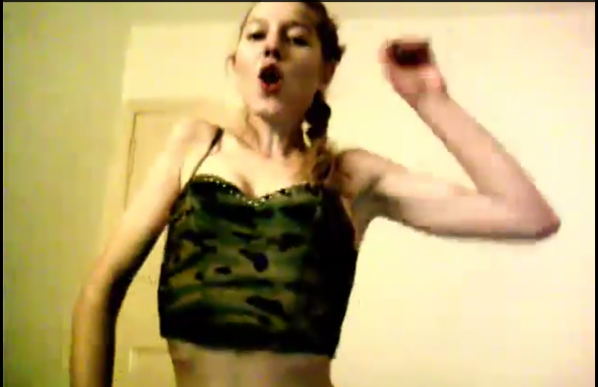
Other works play on the aesthetics of given rave cultures. Travis Smalley’s Wave Trancendence splays the multi-coloured trippy aesthetic of early hardcore flyers as a sickly overlush chill-out visual.
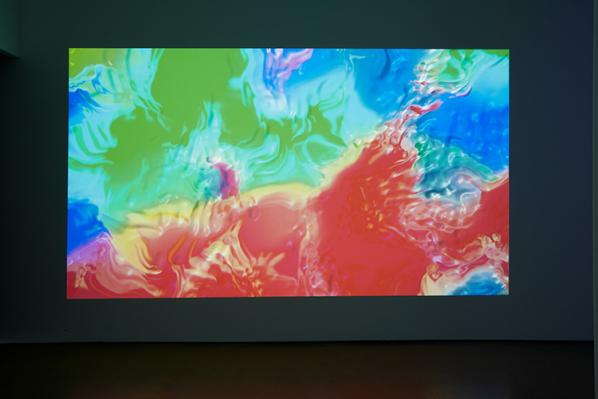
Adham Faramawy’s Lifeproof iPhone Cover revisits the metallic Photoshop filter and puts it in motion, his work simultaneously harking back to late-90s era Drum n’ Bass, while having the look and feel of a vapourwave.jpg – except instead of vapour-wave’s marble, the plinths and stands for Faramawy’s work ooze black foam, like an ashtray left in the alley behind your mum and dad’s for thirty years.
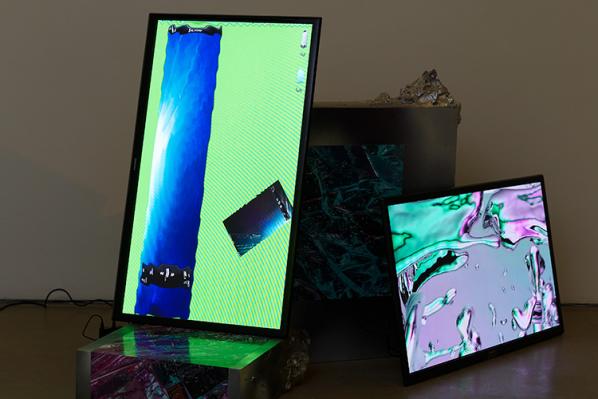
This incongruous collection of perspectives, along with the jostling beats across the whole show provoke a kind of nervy excitement. Installations in the show also play and elide bliss and paranoia. Harry Burden inverse-casts a crumpled car wing and paints it in a pearlised blue and green like a strange beetle.
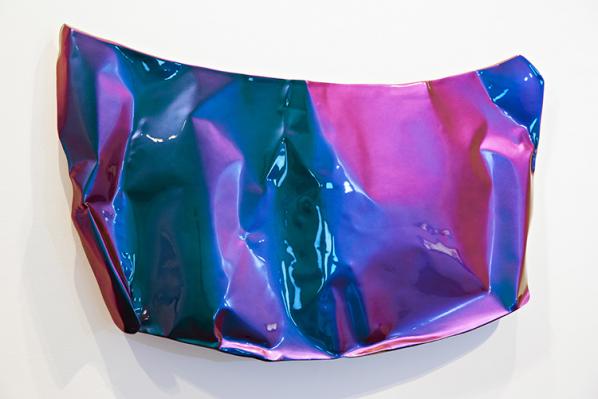
Alexandra Gorczynski’s liquid dream-like video peers up queasily from under a glittery canvas bedcover, and Maria Olsen’s gold tapes in a heap on the floor; each item together and the same, but the artifacts themselves – the music, the person – alone in their capsule.
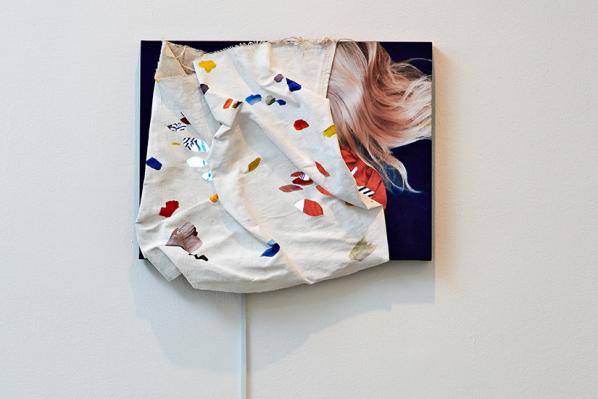
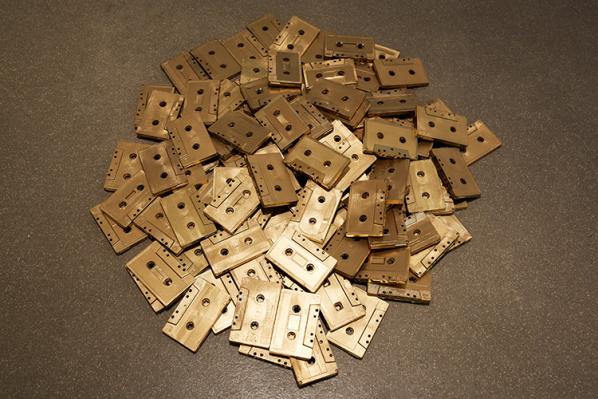
Only Rhys Coren’s playful video-loop doodles set across three screens to a chirpy four-four house beat seem unequivocally ‘happy’ – but we notice that even here, the screens face away from each other, and the animations jiggle on their own buzz.
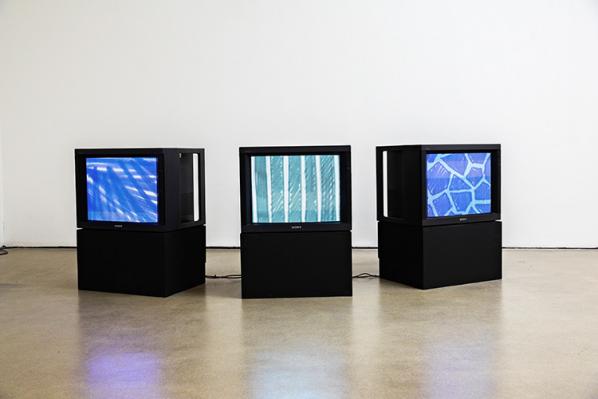
Sitting off in the corridor like a rushed-out raver afterwards, the trouble with this show sinks in. In her short introductory essay, curator Francesca Gavin acknowledges that many of the young artists she features are not old enough to have experienced the first ‘white glove’ rave referenced in the title of the show, but neglects to acknowledge the life of rave and dance culture which these ‘subsequent’ generations find ourselves mourning. To an extent, the use of Acid House here has more to do with marketability than criticality – but to jump right from early 90s rave to the work of an artist like Harry Burden, Adham Faramawy or Fatima Al Qadiri, and to locate the older Jeremy Deller’s smiley-face poster artwork at the ‘fulcrum’ of this show, is to willfully ignore the racial and social complex of the Drum’n’Bass, Techno and Trance which followed (as documented most memorably by Simon Reynolds in his Hardcore Continuum series for The Wire).
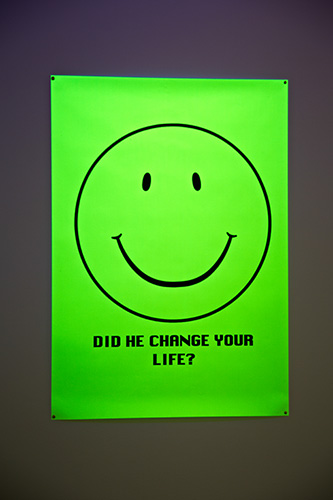
Gavin’s insistance that the exhibition ‘examines the utopian ideas surrounding rave before its failure’, seems to ignore what the artists in the show might consider the actual moment of rave’s failure. This central oversight leads to others. The choice of JG Ballard’s Crash as key-text, while obliquely relevant as an aesthetic touchstone of dystopia, doesn’t really reflect on the ‘realness’ of the scene artworks such as Gorczynski’s reference – it would be nice to have a chance to review the impact of a novel like Irvine Welsh’s Maribou Stalk Nightmares on this generation, or reflect on how current novelists such as Tao Lin use prose style to echo the afterlife of re-illusioned rave and drug culture.
The best works in E-Vapour-8 exist as echoes a UK club culture with more ambiguous relations to capitalism and politics than the radical and resistant Acid House rave. The void left by the hedonistic lifestyle is a simulacrum in a work like Faramawy’s, for the void left in our lives by the death of the hope of capitalism, and our continued afterlife within it – like a club we’re forced to keep revisiting even though it’s too expensive the DJs are shit and people keep getting shot.
The deep cuts in Sophia Al Maria’s and Fatima Al Qadiri’s How Can I Resist U are reconstituted and assimilated into an elegy – to the ‘bootyshake’ and bass, but also to social distribution and emptying out of utopian modernist architectures, using the lo-fi and hi-rise as distinctly modern hallucinations, and touching clearly on Sheffield’s own rave heritage in buildings such as the Park Hill flats.
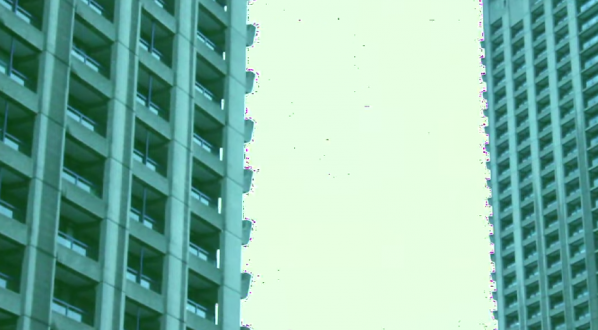
Seen in the light of her generational ‘shortfall’ (being too young to have been seen Altern8 in the Hacienda, but old enough to have got down to Ed Rush at The End) Petra Cortright’s subtle and lyrical cutting and smeering of an original video and its soundtrack in Lara Practice, reminds me of the millenial dancefloor vibe – how out of place those moves were, how re-territorialised they immediately became.
“I start to wonder if she, like me, got sucked in by Ardkore’s explosive euphoria, its manic, fiery-eyed glee, and then got carried along by the music’s logical evolution to wind up at another place altogether, dystopian rather than utopian.” Simon Reynolds ‘”Slipping Into Darkness” The Wire #148
As examples of the thematic depth offered in this show, the Al-Qadiri/Al-Maria and Cortright videos capture the implosion of a naïve energy. By focusing on the female body in the throes of bass, they present distinct and equally valid breakages taking place between anticipation and experience – and the emergence into a darker real and global hyper-real. The artists’ contemporaries in the music scene (including vapourwave artists such as Vektroid and Oneohtrix Point Never) deserve some credit for informing a culture which can act in this way.
It would seem that a gallery of this stature, and a curator with the contemporary culture credentials of Francesca Gavin – visual arts editor at Dazed – would be more keen to link visual art with actual dance culture, rather than a fully assimilated cultural caricature like happy hardcore… but then, the exhibition itself is an opportunity for us to do just that.
I recommend a visit – the show is on until August 17th. Those who were in a circa-1998 nightclub will recognize the nervy and unsettling sensation of the corridor or cloakroom queue, the combination of E-high with screw-face attitude. A steady, percolating dark bass among the hallucinatory imagery and tongue-in-cheek synth refrains. Those who weren’t will undoubtedly find their own touchstones in these independently deeply poignant and distinctly contemporary works.
Play with the Rubik Cube simulator online! Drag the pieces with your mouse to unjumble the puzzle.
Featured image: Image from “Otherworldly” at Manchester Urban Screens 2007. Curated by Michelle Kasprzak
Eva Kekou interviews Michelle Kasprzak, a Canadian curator and writer based in Amsterdam, the Netherlands. She is a Curator at V2_ Institute for the Unstable Media and the Dutch Electronic Art Festival (DEAF). She has appeared in Wired UK, on radio and TV broadcasts by the BBC and CBC, and lectured at PICNIC. In 2006 she founded Curating.info, the web’s leading resource for curators. She has written critical essays for C Magazine, Volume, Spacing, Mute, and many other media outlets. She is a member of IKT (International Association of Curators of Contemporary Art). Michelle is also an avid weightlifter with current personal records of 80 kg squat, 52.5 kg bench press, and 90 kg deadlift.

Eva Kekou: Can you give us some info about your work as an artist and curator and specifically your work at V2_?
Michelle Kasprzak: I was trained as an artist, but my art career feels many moons ago now. My first love was photography, and I spent many hours in the darkroom as a teenager. Later on I moved into live video mixing for performance contexts and parties, single channel video works, and integrating technologies like speech recognition and found objects into performance.

I was also curating throughout this time, though for many years it took a back seat to my artistic practice. Eventually I realized that I was more interested in curating and writing than making the artworks myself. Of course, one should never say never, so I may return to art making someday, but from that point onward and until the present time I focused full-time on curating and writing.
This was the mid 2000s and it was a pretty exciting time to be a media arts curator. It felt as though things were gaining traction. So many years after Cybernetic Serendipity had laid the foundations, we had exhibitions such as The Art Formerly Known As New Media curated by Sarah Cook and Steve Dietz to stimulate the dialogue about new media art and how to exhibit it, and take it all to the next level.
Fast forward to now: a few years later, I’m a curator at V2_ Institute for the Unstable Media in Rotterdam, the Netherlands. V2_ loomed large for me as a young undergraduate in Toronto studying new media – it was this far away place in a city I didn’t know with this massive reputation for doing edgy, interesting things. I wouldn’t in my wildest dreams at the time ever imagine I would one day work there.
As an institute, V2_ has been through a number of key transformations and I think it’s interesting to map that on to what was happening at the time both in art and in society. It started in the 1981 as a squat (which was common in the Netherlands at that time) and the founders called it a “multimedia centre”. Sonic Youth, Laibach, and Einsturzende Neubauten played there. The “Manifesto for the Unstable Media” was written in 1987 and arose out of a dissatisfaction with the status quo and it said things like “Our goal is to strive for constant change”. Following the Manifesto, a series of “Manifestations of the Unstable Media” were created, which evolved into the Dutch Electronic Art Festival (DEAF), a festival which continues today. In 1994 V2_ moved from s-Hertogenbosch to Rotterdam and has remained there ever since.
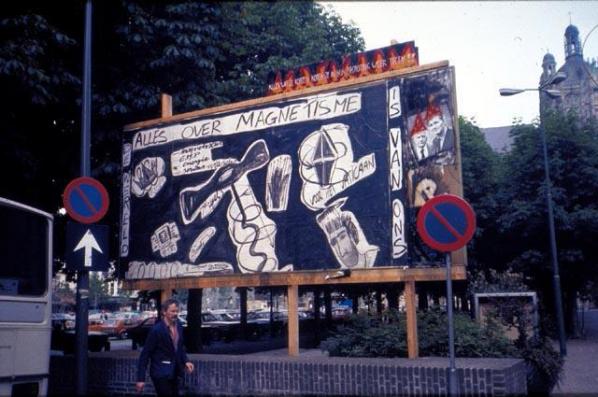
Around that same period of the mid- to late-90s, the growth of internet access and support for artists working with networked technologies caused V2_ to change its focus in this direction. In 1997, V2_Lab opened as a hub within V2_ to initiate and support the production of artistic projects investigating contemporary issues in art, science, technology, and society.
EK: So today, in this age of ubiquitous technology and information, where does an institute like V2_ find its place?
MK: I see media art as a category splintering and dissolving, with bits of its ethos absorbed into design, contemporary art, craft, and hacker culture – and vice versa. One way to find a place in the world is to stay true to the origins of V2_ in terms of its squatter ethic. So for example, we (myself and my colleagues, particularly Boris Debackere and Michel van Dartel) recently rewrote the mission statement of the Lab, declaring it “…an autonomous zone where experiments and collaborations can take place outside of the constraints of innovation agendas or economic and political imperatives.” Which is not to say that anything goes, but states explicitly that we’re especially open to people looking for a home for a risky or unconventional idea. Also, following on from several years where V2_Lab hosted residents based on three fairly technologically-driven themes (wearables, augmented reality, and ecology), the Lab has taken on a new direction of being methodologically-driven, and looking at themes like re-enactments, design fiction, and extreme scenarios.
I think it’s a key shift, because in order to “strive for constant change” as we said in the original manifesto, linking to any one technology of the moment seems too static and limiting, as well as reducing our reach into areas with interesting and relevant artistic research occurring, but which might not have much technology involved in an apparent way. The fact is just about everything being made right now is a product of the technological age we live in, so it’s more useful to think in terms of methods and approaches rather than whether something fits a classic definition of what media art is or not.
Take for example one of our latest commissions, Paper Moon by Ilona Gaynor in collaboration with Craig Sinnamon. Ilona and Craig were at V2_ for a few months at the end of 2013 and both have design backgrounds. The work, to describe it in a formal sense, is a series of objects and paper-based work arranged in a specific fashion along with a short screen-based animation. This seems a little different than what one might expect to see at V2_, except for small clues in the creation of some of the items (the animation is generated with 3D animation software, some of the objects have been 3D printed). But more significantly, in its thematic Paper Moon enters the realm of the unstable by exploring the emerging legal definitions and loopholes of outer space – particularly the treatment of the moon and other celestial bodies. Our legal system on Earth, as Ilona put it “…has no definition for what ‘Outer Space’ actually means, what it is, and where it is. The problem we face with such literal unmarked territory is the emergent field of ‘Space Law’ becomes genuinely speculative.”


Ilona’s residency was part of V2_Lab research project Habbakuk, about Innovation in Extreme Scenarios. The Innovation in Extreme Scenarios research thread was generated in reaction to the introduction of an innovation agenda for the arts as part of the Dutch government’s ambitionto be “one of the world’s top five knowledge economies” by 2020. As a way of directly addressing this policy direction, V2_Lab began undertaking research into the nature of and appropriate contexts for innovation through a series of expert meetings, workshops, site visits and interviews over the course of 2013-14. The final outputs of the project, which will comprise project commissions and a final publication, will be used as a tool to engage with the policy conversation on innovation in a more profound way. So we’ve been doing work on this at home and abroad, holding expert meetings and interviews in the Netherlands, Canada, Hungary, and Denmark.
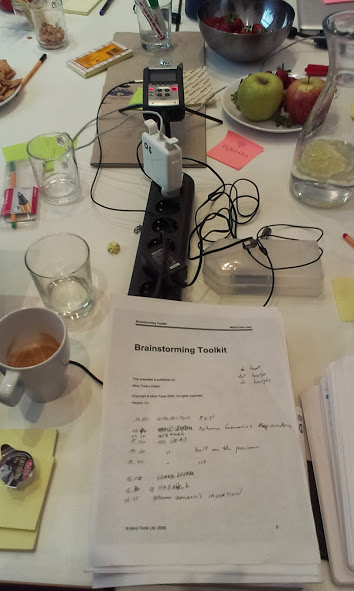
The Dutch policy context explains the “innovation” part, but the “extreme scenarios” part came from somewhere else. For that I was inspired by the World War II story of the Habbakuk aircraft carrier which was commissioned by Winston Churchill. The Allies were plagued by German U-boats, and Churchill desperately needed an innovative solution to this particular problem. In the extreme scenario of war, Churchill authorized the production of a radically innovative solution: building an aircraft carrier made of ice – specifically Pykrete, a frozen mixture of water and sawdust.
Pykrete seems like ordinary ice but the addition of sawdust makes it into a kind of wonder material that takes longer to melt and invulnerable to bullets. In the end the massive ship, which was to be christened “Habbakuk”, never saw the theatre of war but considerable effort was put into developing a prototype in total secrecy deep in the Canadian Rockies.
Inspired by both the Habbakuk story and our own policy situation brewing at home, some of the questions we’ve been trying to answer with this research are things like: What are the best contexts for innovation to take place? What are the myths surrounding how innovation occurs? Does the pressure of an extreme scenario inspire innovative solutions, or only eccentric, unrealisable concepts? What’s the U-boat problem of today?

The theme of Innovation in Extreme Scenarios is also being explored in the programme that I devised and curate at V2_ called Blowup. Blowup refers to a number of things: the way that you can blow up a photograph, a balloon, a situation, and of course – the Antonioni film. I see it as a container that presents things in a slightly different way each time, and that its main remit is to examine the things that are changing the way we live now, or reinforcing the status quo of today. The formats for Blowup have varied a lot: from a workshop, to a talk show, to a talk show within a talk show, to a five day booksprint, to an exhibition in a pop-up space. The topics have been equally eclectic: art for animals, outer space, journalism as an art practice, object-oriented ontology, and so on. The most consistent element is that each event has an eBook released along with it, and that these eBooks explore the topic in a little more depth, but also combine previously released material with newly commissioned material. We all have bulging bookshelves and intend to always read something later – by bringing relevant old texts back into the forefront, I hope to give them a chance for a second look (or a first look if you missed it when it was released).
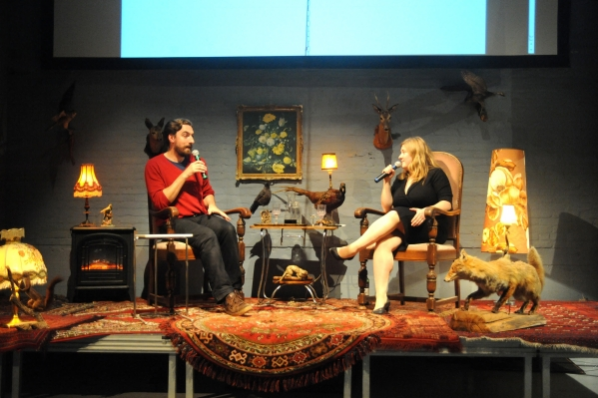
EK: What are your hopes and dreams for the future?
MK: For the future, I think new ideas are incredibly rare, and that doesn’t bother me at all – what interests me is that dreams that were previously impossible are becoming possible, and so my passion continues to be seeking out the inventive eccentrics with grand master plans, and being a part of realising that. Churchill dreamed of ending the war with a boat made of ice more than ten times the size of the Queen Mary. These are the kinds of big wild dreams – in scale and in scope, if not in my discipline – that I dream of.
Die GstettenSaga: The Rise of Echsenfriedl review. SPOILER WARNING!
Johannes Grenzfurthner’s Post-Apocalyptic DIY Epic on Makers, Hacktivism and Media Culture.
“A mad post-collapse satire of information culture and tech fetishism, in a weird sort of melding of Stalker, Network, and The Bed-Sitting Room.” (Richard Kadrey)
Die GstettenSaga: The Rise of Echsenfriedl is an Austrian hackploitation art house film by Johannes Grenzfurthner, mastermind of the international art-technology-philosophy group monochrom, co-produced by the media collective Traum & Wahnsinn. Reimagining the makerspace as grindhouse, the story is set in the post-apocalyptic aftermath of the “Google Wars” – an armed global conflict between the last two remaining superpowers China and Google – which has turned what remained of the Alps into a Gstetten.
In Austrian German, “Gstetten” translates to wasteland, outback or ‘fourth world’ (Manuel Castells) and is a popular name for provincial towns – and sometimes just the less sophisticated parts of them. The area’s biggest semi-urban sprawl is Mega City Schwechat, the former home of Vienna International Airport, a refinery and a beer brewery. It is governed by the evil media mogul Thurnher von Pjölk (Martin Auer), a pretender who claims to be the inventor of key publishing technologies such as letterpress printing and rules the area with his tabloid newspaper. But the hegemony of his yellow press empire is contested by – spoiler alert! – makers, hackers and nerds, who are more leaning towards electronic media such as the recently rediscovered television. In order to get rid off this bothersome opposition, Pjölk devises an evil plan for wiping out Schwechat’s insubordinate creative class.

In an insidious political move, he pretends to reach out for the technophile faction by commissioning two of his reporters, the bootlicking opportunist Fratt Aigner (Lukas Tagwerker) and the brainy geek girl Alalia Grundschober (Sophia Grabner), to conduct an exclusive TV interview with the ultimate Gstetterati icon, the legendary innovator Echsenfriedl (“Lizard Freddy”) – on the basis of precarious employment conditions. The title character, who turns out to be an basilisk, embodies a mix of Steve Jobs, Richard Stallman and Julian Assange and lives in the depths of Niederpröll in his hideout much like Subcomandante Marcos – partly in order to protect the world from his killing gaze, which would, audio-visually transmitted, turn the whole of his fan base immediately to stone.
Grenzfurthner’s sci-fi-horror adaption of the Divine Comedy takes us on a retro-futuristic post-cyberpunk adventure in the tradition of cinema grotesque back to the dark days which preceded the Internet. The journey of our heroes – distinctively resembling Tarkovsky’s ‘stalkers’ – is a quest for extinct media technologies but their search for Echsenfriedl eventually leads the two protagonists to a deepened understanding of who they really are: the media industry’s precarious workforce under spectacular capitalism. While Fratt’s dirt track to enlightenment is paved with stumbling blocks, his brainy Beatrice advances with the determination of a Harawayian cyborg who makes use of her superior technical skills to save them from the zombified folk populating the Gstetten: uncanny creatures from the Kafkaesque bestiarium of Austria’s undead bureaucracy and its hanger-ons like armed-to-the-teeth Postal Service subcontractors (brilliant: monochrom’s Evelyn Fürlinger, also Grenzfurthner’s ex-wife) or the once powerful Farmers Association led by Jeff Ricketts (Firefly, Buffy the Vampire Slayer), who are worshipping antique pre-war EU funding applications as their sacred scriptures. Our friends receive the final hints for their search from the Sphinx Philine-Codec Comtesse de Cybersdorf (Eva-Christina Binder), a fantasy femme fatale who is torn between Plöjlk and Echsenfriedl, and the bearded drag queen Heinz Rand of Raiká (David Dempsey), an eccentric agricultural cooperative banker and possible descendant of Conchita Wurst.

The Gstettensaga’s fascinating cinematic pastiche is more than just a firework of rhizomatic intertextuality, a symptom of the depthlessness of postmodern aesthetics or excessive enthusiasm for experimentation in the field of form. In their infamous 1972 book Anti-Oedipus, Gilles Deleuze and Félix Guattari have identified the technique of bricolage as the characteristic mode of production under “schizophrenic” capitalism, a facet triumphantly magnified by the filmmakers. If every discourse is bricoleur, like Jacques Derrida suggested, suddenly ‘context’ can become the artist’s material or even a form of art in its own right:
“The more artists are consigned to an existence within a patchwork of niches, the more dependent they become on information resources, communication and networking. In this respect, aesthetic artefacts must take a stance toward a plethora or markedly heterogeneous contexts that sediment in one way or another: the conditions and circumstances surrounding their production, their various social fields from which (and for or against which) they speak: real or imagined audiences toward (or against) whose values a work, an approach or a position is targeted. This play with the factors affecting it and among which it must mediate has become an essential trait on an art form that might best be described as ‘Contextualism’.” [1]

What I found especially intriguing about the Gstettensaga is how the filmmakers responded to the various challenges of the feature film format by contextualising the whole production process, distribution, language adaptions (subtitles are an integral part of the story), soundtrack and even the viewing experience.
The film was initially commissioned by Austrian public broadcasting station ORF III as part of the series Artist-in-Residence for a budget of only €5000, set to be produced within a six months period. In response, monochrom used an embedded prank to raise money. The movie contains a text insert similar to watermarks used in festival viewing copies, which asks the viewer to report the film as copyright infringement by calling a premium-rate phone number (1.09 EUR/minute) and enabled Grenzfurthner to co-finance the film with proceeds from this new strategy he has named ‘crowdratting’. [2]
The Contextualist script – including outlines of scenes for improvisation – was written by Grenzfurthner and Roland Gratzer in just a couple of days in November 2013 in a Viennese restaurant. They also incorporated ideas that came up during their weekly meeting with the entire production crew, whereas some of the backstory was first created for monochrom’s pen-and-paper role-playing theatre performance Campaign. Principal photography – the camera work of Thomas Weilguny deserves the highest praise – commenced on December 2, 2013 and ended January 19, 2014, which left nearly 5 weeks for post-production and editing. Due to the fast production process and the financial limitations, no film score was composed for the Gstettensaga – instead, Grenzfurthner used an assortment of 8bit, synth pop and electronica tracks especially for their specific retro quality because “they may sound old-school to us, but not in the world of the Gstettensaga, where all retro electronic music is still impossible and futuristic.” [3]
The retro-futuristic world of Echsenfriedl is coming to a film festival, hacker con or Pirate Bay near you.
http://www.monochrom.at/gstettensaga/
Tamtam (Seara de proiectie la TT) / May 7, 2014 (Timisoara, Romania)
KOMM.ST Festival / May 11, 2014 (Anger, Austria)
Supermarkt (Dismalware) / June 7, 2014 (Berlin, Germany)
Fusion Festival / June 25-29, 2014 (Lärz Airfield, Mecklenburg, Germany)
Roswell International Sci Fi Film Festival / June 26-29, 2014 (Roswell, NM, USA)
iRRland movie night / June 30, 2014 (Munich, Germany)
qujochö Film Summer / July 3, 2014 (Linz, Austria)
HOPE X / July 18-20, 2014 (New York, New York, USA)
Fright Night Film Fest / August 1-3, 2014 (Louisville, KY, USA)
Gen Con Indy Film Festival 2014 / August 14-17, 2014 (Indianapolis, Indiana, USA)
San Francisco Global Movie Fest / August 15-17, 2014 (San Jose, CA, USA)
Rostfest / August 21-24, 2014 (Eisenerz, Austria)
Noisebridge / August 29, 2014 (San Francisco, USA)
/slash Filmfestival / September 18-28, 2014 (Vienna, Austria)
Simultan Fest / October 6-11, 2014 (Timisoara, Romania)
Phuture Fest / October 11, 2014 (Denver, Colorado, USA)
prol.kino / October 14, 2014 (Graz, Austria)
Featured image: A Tool To Deceive And Slaughter” (2009) Caleb Larsen
Accelerationism came to prominence in 2013 with Nick Srnicek and Alex Williams’s hashtag-titled manifesto. A cloud computing-era spin on the old Marxist argument that we first need to perfect capitalism in order to transcend it, its lineage is fleshed out in a new book from Urbanomic. Urbanomic claim (among others) Nick Land’s skynet midwifery, J.G. Ballard’s science fictionalization of culture, and Marx himself as precursors to Accelerationism, establishing it as a serious anti-humanistic response to the challenges that humanity faces if it is to avoid extinction. Similar to Christine Harold’s strategy of “intensification“, Accelerationism calls for us to appropriate the value of capital’s developments and transform them materially into something else rather than attempt to resist them head-on or refuse them in our hearts.
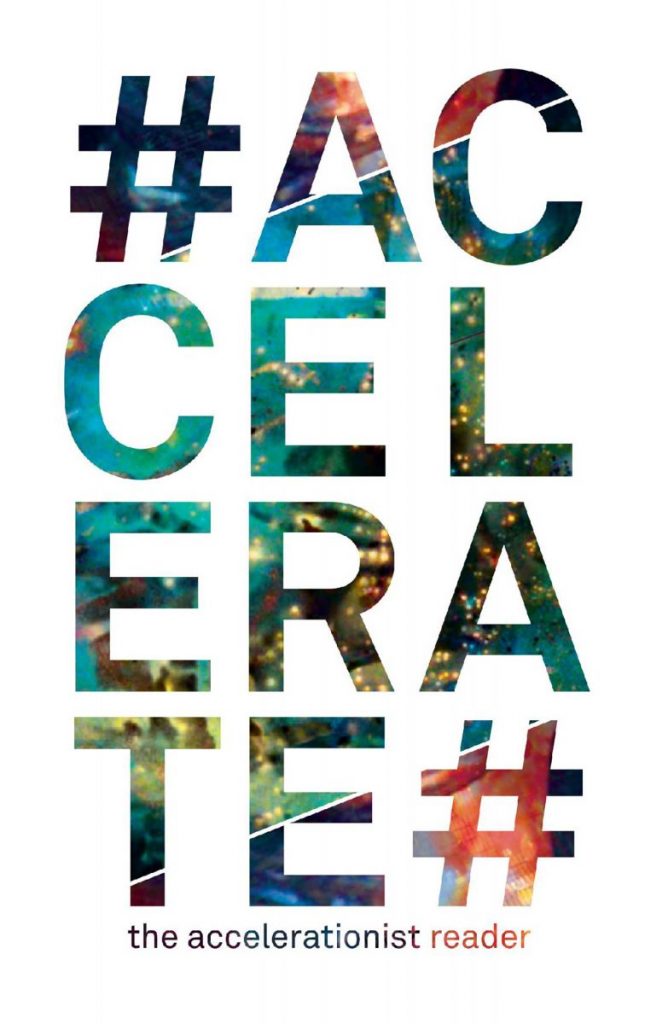
Bitcoin is an example of an accelerationist technology. It uses Internet-scale computing resources to rebuild social bonds by destroying the requirement for them in monetary exchange. You don’t have to know me or trust me or any third parties to receive money from me in the form of Bitcoins. You just have to trust the algorithms that very publicly operate the Bitcoin network. The new Ethereum project takes the blockchain technology behind Bitcoin and generalizes to contracts for purposes other than just the transfer of money, although of course those contracts can involve payments. Ethereum contracts exist as a distributed database of small programs and their state that resembles nothing so much as an economic LambdaMOO. There’s a good guide to their promise and potential pitfalls in the talk “Ethereum: Freenet or Skynet ?” by Berkman Center Fellow Primavera Di Filippi.
Smart contracts and smart property, which uses smart contracts to identify and control ownership of physical resources, were first described by Nick Szabo in the 1990s. Smart contracts are “smart” because they are implemented as computer code rather than as legal documents. Real world examples include vending machines, in which a contract to purchase goods is encoded into the simple software that dispenses carbonated drinks when you insert the correct money, Boris Bikes, RFID card payments for photocopies, and car hire schemes that unlock vehicles and track their use with QR codes. Would-be rentiers who try to launder their ambitions with the warm fuzziness of “sharing” are salivating at the prospect, as are the incorrigible snake oil merchants of DRM, but that is not what concerns us here.
Smart contracts and smart property for art already exist. The artwork “A Tool To Deceive And Slaughter” constantly re-sells itself on eBay. The GIF ownership service “Monegraph” uses the NameCoin system to track notional ownership of instances of infinitely reproducible digital art. These are extensions of pre-digital art contracts such as certificates of authenticity or ownership for conceptual and immaterial artworks. They show a way for art to continue producing a useful critique of property and social relations under technoculture, and for new technology to feed art’s ongoing critique of its own production and nature. I wrote about this in “Artworld Ethereum – Identity, Ownership and Authenticity“, which provides code examples demonstrating how simple it is to implement some of these examples with technology dedicated to smart contracts.
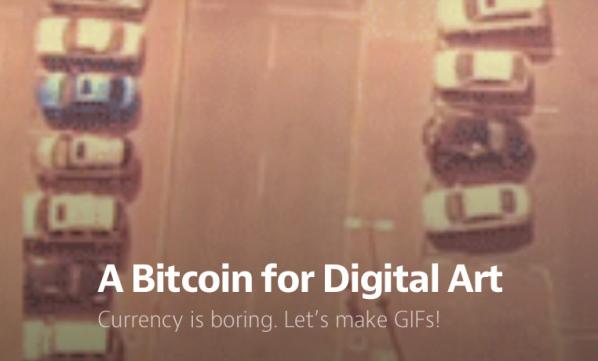
Like Bitcoin, smart contracts and smart property do not require social trust to build social value, just running code. They have very limited functionality, being unable to check RSS feeds on the Internet for information for example as that information might be tampered with. This raises the question of how individuals can be encouraged to provide valid real-world information to smart contracts rather than just entering the values that will immediately profit them the most. Capitalist economics answers this with the concept of incentives. Value, and values, can be determined by the behaviour of individuals in markets in response to economic incentives. And smart contracts are intended to make markets more efficient.
I would like to apply this agoric approach to truth to the crisis of art criticism in the face of aggregation that I identified in “The Proletarianization Of Art Criticism“. Individuals can be motivated to publish defensible aesthetic and art critical opinion in novel ways via smart contracts. I am not proposing an automated or purely algorithmic art criticism here: human activity is the core of this approach. Nor am I proposing an Amazon Mechanical Turk-style exploitation of affective labour. Rather I am proposing an Accelerationist approach, using the technology of digital capitalism to rebuild the social flows that it has destroyed.

Art is no stranger to the idea of markets, the artworld consists of one of the least regulated and therefore in theory one of the purest markets. But even ignoring the opacity and corruption of the art market, there is a problem with taking a direct approach to the art market as an arbiter of artistic value. As David Galenson‘s 2008 study of aesthetic value and market price showed there is a problem in using pure market mechanisms to establish the value of art: many “great works” have either never been auctioned or have not been to market in decades or even centuries.
I therefore propose three different approaches to art criticism via smart contracts. For work exposed to the market, the mechanisms used to price shares and other financial assets can be used. For work with less exposure, SchellingCoins and prediction markets can work alongside these mechanisms via proxies.
The prices of financial assets, stocks and shares or contracts for commodities for example, are set using a system of derivatives. Financial derivatives gained a bad reputation following their role in the global financial crash of 2008. By 2011 the notional value of the derivatives being traded was almost ten times the total GDP of planet Earth. And their automation by algorithmic high frequency trading is being increasingly scrutinized by regulators.
There are many different kinds of derivatives: short and long options, futures and exotics for example. But in theory at least their function is simple and beneficial. They enable individuals to profit by expressing whether they think a financial asset is over- or under-priced. This incentivizes them to act on this information. The resulting sharing of information and correction of prices benefits society.
Non-physical ownership, sponsorship, crowdfunding, dedications and more exotic value relationships to physical works and, crucially, to works that have not or will not be sold and to unownable digital art can be represented by smart contracts. These can then be treated as the underlying assets of derivatives, also represented as smart contracts, in whole or again crucially in fractional parts or shares. Buying and selling derivatives of shares in digital artworks, and particularly going short or long on them, represents a critical position on their worth. Where the underlying asset does not represent actual ownership of the artwork, we are closer to a prediction market than a financial market. But if the assets themselves attract prestige or value regardless of their proxy status they may become art objects in themselves.
Art criticism in such a market is a matter of financial investment and returns. Critics express their opinion of art, artists and artistic trends by buying and selling different kinds of derivatives at different times. If they are shown to be correct over time, the market will reward them. Derivatives are a prime candidate for implementation as smart contracts, there is already a project to create a standard language of (non-aesthetic) derivative smart contracts.
Since Ethereum contracts have no direct access to the outside world (or the Web), contracts that require information about the outside world must access it through intermediaries. This means that contracts must trust those intermediaries, and if it is more profitable for them to lie to the contracts that creates a problem. To remove this requirement of trust we can use a system that rewards people for independently supplying information that accurately reflects the true (or most likely) state of the world.
A SchellingCoin is an Ethereum contract that allows people to send it messages registering their opinion about (for example) the current temperature in Berlin or exchange rate between dollars and yen. Those that set the majority view are rewarded for doing so, similarly to the operation of a prediction market. But how do they know which value to choose? The game theory concept of a focal point, or Schelling point, is an answer to a question that people who cannot communicate will give independently because it seems natural, appropriate or special. SchellingCoins reward people who give the consensus answer to a question, and people can determine the right answer by converging on a Schelling point. For real world phenomena, such as temperature or exchange rates, the Schelling point is likely to be the correct answer. SchellingCoins can be implemented as smart contracts, removing the need for a trusted entity to run them.
Schellingcoins are designed to address external, quantitative phenomena. Opinions regarding cultural works are personal and qualitative, and spontaneous reactions to cultural works are even more so. This is different from the commonly expressed quantitative values that the SchellingCoin proposal requires. To adapt SchellingCoins to cultural criticism we must adopt the methods of collective intelligence and the digital humanities and use some tricks to turn personal opinion into cultural appraisal.
Collective intelligence algorithms work well with star rating systems and tags. These are popular methods for rating books, films and music on ecommerce and review sites. They can be represeented, aggregated and extrapolated from easily by software, which makes them ideal for representing opinion in SchellingCoins. There are risks in using such systems, as the low rating of the film “Gunday” on IMDB shows, but they are easy and accessible to use.
Digital Humanities approaches often involve counting the frequency of words in texts or other unstructured phenomena. The results of binary checks or of counts can be applied to Schelling coins. For example, whether an artwork appears on CAD or Rhizome or not, or whether the words “blue” or “postbinary” appear the most in reviews about it on major review sites can be reported via further SchellingCoins or via trusted feeds or oracles.
To turn these approaches into a SchellingCoin, we do not ask what people think of an artwork. We ask them what they think the average reviewer will think of the artwork (or to protect against gaming, we ask them to predict the curve for all the star ratings for the work). Given the theory of focal points, the most likely answer is the one that people suspect will be true.
Cultural SchellingCoins can therefore function as aggregators of opinion-about-opinion-about artworks, producing qualitative but consensual evaluations and critiques of works of art that contain more information than purely price-based mechanisms. Using SchellingCoins to aggregate opinion about other schellingcoins, Meta-SchellingCoings, can provide more general cultural critique.
To turn reviews into art criticism with a longer or broader perspective we can ask people not what the current state of reviews of the artwork but about what they will be in a year’s time, five years’ time, etc. How highly starred will they be and what tags/words will be used to describe them? Will the work (or the artist) be used as a point of comparison in reviews and articles? Will it (or they) still be being exhibited or purchased, and in what kind of galleries? How much will the work sell for, or in the absence of sales how many people will visit it at exhibitions? Will the artist still be working in that style, or how will their work have changed?
Each prediction can be represented as a security in a prediction market, and the current price of that security can be interpreted as the probability of that prediction. For example, a prediction market security might reward a hundred Satoshis or ten points if a particular artist has a headline show at Tate Modern. If you think there’s an 80% chance of that happening, you can pay up to 80 Satoshis or 8 points for the security representing that prediction. If you’re right you gain in return for improving the market, if you’re wrong you lose instead. There is evidence that prediction markets are successful, although they have been banned as a form of gambling in the US and the Pentagon’s 2003 attempt at a political prediction market was quickly labelled a “terrorism futures market” by the press and taken offline.
There is already a successful cultural predicton market, Hollywood Stock Exchange, where the price of “shares” in actors, directors and movies function as a prediction of their performance at the box office. The art market itself can be considered a kind of hybrid prediction market, but separating out that predictive function into a pure prediction market concentrating on critical evaluation can remove distortions that result from manipulation of the secondary market and solve the problem of representing critically valuable artworks that aren’t part of the art market.
It’s also possible, as with Hollywood Stock Exchange’s use of directors and actors as well as movies, to have prediction markets for other artworld entities. Not just artists and galleries, but movements, styles, genres, subject matter, even formal and aesthetic properties such as colours can be represented as securities in a prediction market. Buying and selling them can help set a shared understanding of their potential and impact.
Prediction markets can be represented as Distributed Autonomous Organizations (DAOs) on Ethereum’s blockchain, free from central control. DAOs present an opportunity to re-think and re-implement organizations on the blockchain. As well as markets they can be used to manage events, publications, co-operatives and educational or artworld institutions on various organizational models in a public and transparent way.
Cultural SchellingCoins, Artistic Prediction Markets and Aesthetic Derivatives are Accelerationist technologies for art criticism. Not necessarily for art criticism of the kind that survives online after being exiled from print media. Rather a functional equivalent to it that recaptures its lost authority in the form of a relationship between individuals and artistic production that exerts a guiding hand on its reception and direction. As they represent an emergent ontology of art and aesthetics manipulating these technologies, whether through technical or social means, is itself art and art criticism.
The text of this essay is licenced under the Creative Commons BY-SA 4.0 Licence.
Featured image: Image from the movie ‘Frankenstein Conquers the World’ directed by Ishirō Honda, a 1965 Kaiju film.
“Nature builds no machines, no locomotives, railways, electric telegraphs, self-acting mules etc. … They are organs of the human brain, created by human hand; the power of knowledge, objectified.” [1] Marx (1857-8)
This writing roots out a few ideas concerning science and technological determinism and humanity’s bond with digital media and social networks. The themes are covered in terms loosely as to what they may symbolize. It looks at our fears relating to technology, human-machine relations, cyborgs, theories in cyber-culture, classical and SF literature and contemporary art practices across the fields of media art, hacktivism, activism, feminism and cyberpunk.
Mary Shelley’s Frankenstein is the focus for this text but it also brings into the mix, Greek mythology and Prometheus – the Titan, and what the myth symbolizes, asking, in what form does he exist in the world today? It is a playful assemblage of unresolved contemplations that have been sitting around asking for light in the back of my mind. This is a stripped down version of the original study about mythology, technology, fear and revolution.
Humans have always exploited the raw materials this planet has to offer, and has the power to change the nature of things, whether it is physical or virtual. With constant re-edits and enhancements we transform everything we touch and this is all part of our evolutionary mutation. [2] The word ‘technology’ originally comes from the Greek word tekhne, meaning art and craft, the making of useful or good things. The ‘ology’ part means to discuss something or a branch of knowledge and common form. In Greek Mythology Prometheus was a demigod and a Titan worshiped by craftsmen. “In Greece the Titans were ultimately honoured as the ancestors of men. To them was attributed the invention of the arts and magic.” [3] (Graves 1964)
First, we begin with an apocalyptic vision of what could be and what it looks like when something strange occurs in the oceans. In July 2011, an article in the International Business Times featured a phenomenon we’d normally expect in a science fiction novel or movie. The headline read “Millions of Jellyfish Invade Nuclear Reactors in Japan, Israel” [4] Then the Reuters news web site mentions another jellyfish invasion at a Scottish nuclear power plant, in Torness. “An invasion of jellyfish into a cooling water pool at a Scottish nuclear power plant kept its nuclear reactors offline on Wednesday, a phenomenon which may grow more common in future, scientists said.” [5]
On whether this occurrence is significant and poses future threats, the International Business Times said, “The several [power plant] incidents that happened recently aren’t enough to indicate a global pattern. They certainly could be coincidental, Monty Graham, a jellyfish biologist and senior marine scientist at the Dauphin Island Sea Lab off the Gulf Coast of Alabama stating, told LiveScience.” [7] However, some say jellyfish may be the only species worth fishing in European waters if trends in overfishing are allowed to continue. In an article in the Telegraph in 2008, it said, “scientists have said that unless the system is completely overhauled fish stocks will continue to deplete to the point of extinction by 2048, leaving consumers little option but to eat jellyfish or the small bony species left behind at the bottom of the ocean.” [8]
In September 2013 another mass of jellyfish forced one of the world’s largest nuclear reactors to shut down. The Operators of the Oskarshamn nuclear plant in Sweden had to scramble one of their three reactors after tons of jellyfish clogged the pipes that bring in cool water to the plant’s turbines. “By Tuesday, the pipes had been cleaned of the jellyfish and engineers were preparing to restart the reactor, which at 1,400 megawatts of output is the largest boiling-water reactor in the world.” [9]
“New research, published in the Proceedings of the National Academy of Sciences, shows that the rise in jellyfish populations may not only be aided by climate change, but is also contributing to it by making oceans more acidic, thereby disrupting their function as carbon sinks.” [10] (Land 2011)
Since the Chernobyl disaster in 1986 trust of a state’s handling of dangerous technology has taken a dive. We need only to look at Japan’s recent experience of technological disaster with their nuclear power stations. This brings us to the notion of risk and what this means. In the 19th Century risk was no longer about nature, it changed, it extended to us humans and our conduct. “This extension was due in part to the singular appearance of the accident, a kind of mix between nature and will.” [11] (Ewald 1993) […] Thus “no progress without associated damages.” [12]
Gareth Edwards, director of the 2014 Godzilla movie, starts with a 10 minute recap of “nuclear bomb tests from Bikini Atoll featuring voluminous apocalyptic mushroom clouds and a full-blown Fukushima-like nuclear power meltdown.” [13]
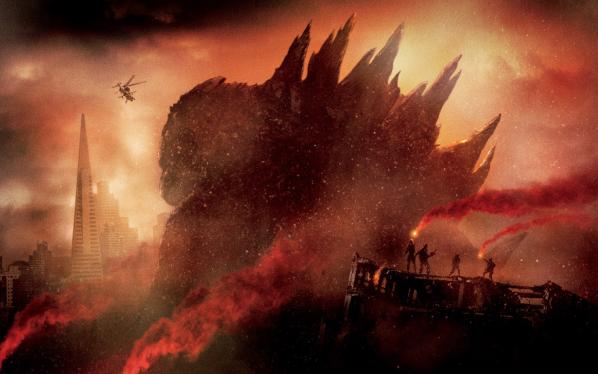
Since the 19th century fears about technology and the notion that scientists are meddling with creation itself has been in the public’s consciousness. Many view Mary Shelley’s Frankenstein as triggering these long-term concerns. Of course, these fears are subjective, but also include people’s concerns about not having control over how technological decisions are reshaping society. After all, many lives have been lost due to brilliant uses of technological advancement made specifically for the act of killing many, as with the development of nuclear and biological weapons.
“Two international treaties outlawed biological weapons in 1925 and 1972, but they have largely failed to stop countries from conducting offensive weapons research and large-scale production of biological weapons.” [14] (Frischknecht 2003)
Using biological and chemical weapons was condemned by international declarations and treaties, notably by the 1907 Hague Convention respecting the laws and customs of war on land. Efforts to strengthen this prohibition resulted in the conclusion, in 1925, of the Geneva Protocol, which banned the use of asphyxiating, poisonous or other gases, usually referred to as chemical weapons, as well as the use of bacteriological methods of warfare. [15]
“Let us now consider what happens when you make the epistemological error of choosing the wrong unit: you end up with the species versus the other species around it or versus the environment in which it operates.” [16] (Bateson 1972)

Mary Shelley’s Frankenstein has given us much to chew on, ranging across gender politics and history, including symbolic, political, psychological and social themes. Shelley was the daughter of writers Mary Wollstonecraft and William Godwin. Godwin is one of the forefathers of the anarchist movement and most famous for two books published within one year: An Enquiry Concerning Political Justice, an attack on political institutions, and Things as They Are; or, The Adventures of Caleb Williams, a novel that attacks aristocratic privilege, but also is the first mystery novel. Based on the success of these publications, Godwin was a prominent figure in the radical circles of London in the 1790s. [17]
Mary Wollstonecraft was a writer, philosopher, and advocate of women’s rights. During her brief career, she wrote novels, treatises, a travel narrative, a history of the French Revolution, a conduct book, and a children’s book. Wollstonecraft is best known for A Vindication of the Rights of Woman (1792), in which she argues that women are not naturally inferior to men, but appear to be only because they lack education. She suggests that both men and women should be treated as rational beings and imagines a social order founded on reason. Wollstonecraft died at the age of thirty-eight, ten days after giving birth to her second daughter, leaving behind several unfinished manuscripts. [18]
Mary Shelley’s publication, Frankenstein or The Modern Prometheus published in 1818, was perhaps the earliest representation of science fiction but it was also a gothic novel. Shelley appropriated the various influences and sources available to her at the time. Her novel is an assemblage of discoveries in science and technology, societal change and political upheavals, mixed with personal interests. In the 19th Century the Romantic poets, artists and writers Lord Byron, Percy Shelley and William Wordsworth explored ideas grounded in their shared rejection of Christianity. Percy Shelley in 1811, declared his rejection of a greater all-powerful being in The Necessity of Atheism saying, “It is easier to suppose that the Universe has existed from all eternity, than to conceive a being capable of creating it.” [19]
In 1817, Mary married Percy Shelley who became her second husband. They enjoyed debating many ideas together and had a passionate relationship. In the summer of 1816, a year before their marriage, Mary and Percy visited Claire Clairmont (Mary’s stepsister) in Switzerland, and also met Claire’s new lover Lord Byron and he was accompanied by a physician called John Polidori. During their stay at a nearby mansion Byron was renting next to the shore of Lake Geneva, they became good friends. Together, they all read volumes of German ghost stories, usually when the weather was too stormy for leisurely walks. Inspired by these ghost stories, Lord Byron issued a challenge for each of them to write their own tales of horror. All immediately began writing them out, however Mary struggled for inspiration taking Byron’s provocation seriously and listened to the various conversations the others had on the subject. Then, her ideas began to evolve once she had discussed at length the radical works of Dr. Erasmus Darwin with Byron. Darwin had experimented with electrical stimulation on dead matter, preserving a piece of vermicelli in a glass case “and by some extraordinary means it began to move…” [20] Hindle (2003)
Both of the Shelley’s were fascinated by Sir Humphry Davy’s publications Elements of Chemical Philosophy written in 1812 and A Discourse, Introductory to a Course of Lectures on Chemistry, 1802. Undoubtedly “the most celebrated and iconic figure of this entire Chemical Age was Sir Humphry Davy (1778–1829), who used his chemical discoveries, his wildly popular lecture series, and his general writings on science, to turn the ‘Chemical Philosopher’ (the term scientist not being coined until 1834) into a figure of social and cultural importance in a quite new way.” (Holmes 2012) more about Davy here link.
Percy Shelley in his youth “bought and experimented with chemical apparatus and materials and read treatises on magic and witchcraft, as well as more modern scriptures detailing the miracles of electricity and galvanism. [21] Mary Shelley was fascinated with the idea of things being brought back to life via electricity, and also studied the works of the Italian physiologist Luigi Galvini. [22]
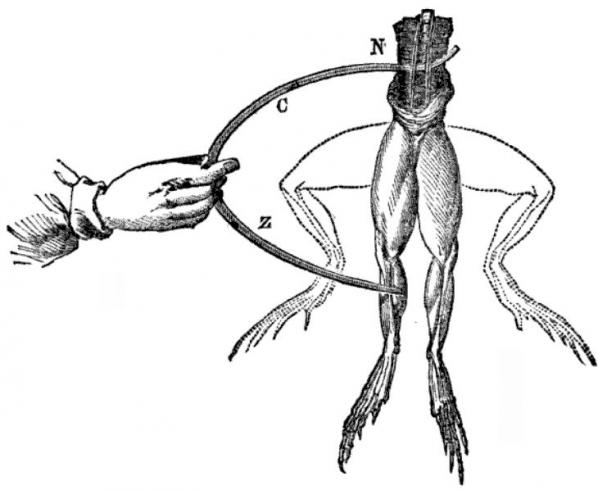
Galvini’s experiments convinced him that ‘animal electricity’ resided inside animal creatures. He observed that when using a circuit consisting of a piece of metal attached to the legs of a frog, convulsions would occur. He assumed the spasmodic jolts were an electrical fluid from within the nerves and muscles of the creature. This led to his announcement that he had brought the limbs of the animal back to life. An Italian physicist Alessandro Volta, who in 1800 made the Voltaic Cell, very soon disproved this. The SI unit of voltage is named after him. [23]
Even if creating life out of dead body parts is an unlawful and immoral proposition. Dr. Frankenstein has the whole of history and an extremely well heeled patriarchal system on his side. However, Shelley’s attack is not against all men but a particular type of man. “The first type is the Promethean scientist who uses nature to gain power and abusively alter it, and the second type is the ‘good’ scientist, who respects and celebrates nature and resists the temptation to fundamentally change the way it operates.” [24] (Munteanu 2001) Passages in Frankenstein reveal “Percy Shelley as the initial model for its ultra-ambitious hero, quite apart from the fact that Victory, Frankenstein’s first name Shelley took for himself a number of times in boyhood and later.” [25] (Hindle 2001)
The psychology expressed through the protagonist Dr. Victor Frankenstein is as a man who manages to transform his extreme, radicalized and revolutionary ideals into the form of a monster. This is a personal characterization informed by Shelley’s own experience with Percy Shelley and her father William Godwin. And, even though her love for them is evident, she also had deep concerns about their shared, revolutionary radicalism. Mary Shelley was well versed in the writings of her father Godwin and her mother Mary Wollstonecraft, as was Percy. They both systematically studied the works of Thomas Paine, and this included even conservative thinkers such as Edmond Burke, Abbe Barruel, John Adolphus. [26] (Sturrenburg 1982) Yet, Shelley’s “world view is less political than Godwin’s and Burke’s; it is also far more labyrinthine and involuted when it comes to telling us why things fall apart.” [27] (Ibid)
Prometheus 2.0.
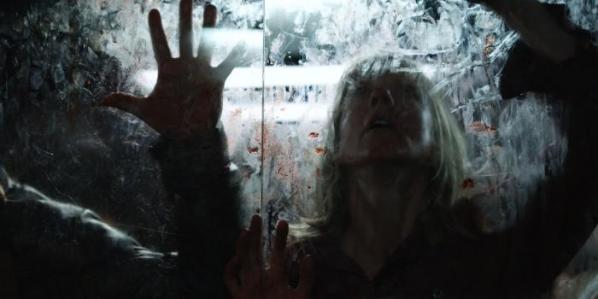
Mary Shelley challenged the cliché narrative of the hero and his belief in the absolute. Her portrayal of Dr. Frankenstein as an egocentric obsessive who will stop at nothing until he completes his mission in bringing his creature to life; represents man’s blind quest in pushing on until the precarious end, at whatever cost. For Shelley, this indicates evident tensions between men and women and their scripted, dualistic roles. This may be an obvious feminist critique now, but in Shelley’s time it was a very different story. Wait a minute! Who am I kidding? The recent interview by Furtherfield’s Ruth Catlow on the New Criticals web site, with the multiple identity female artist(s) Karen Blissett tells us that we are still stuck in this arcane world of male domination. For Karen Blissett, her modern day Frankenstein’s exist in the everyday boardroom in managerial positions as they ‘move forward’ in pushing the top-down, and visionless austerity packages into all aspects of our everyday lives.
“Karen Blissett categorises her most recent artwork Senior Management, An Inspirational Guide, as art for offices […] they demand the impossible. Not in a good way, and not for the enrichment of human futures, but sucking up to power and policy makers – ministers, regulators, corporate leaders – negating their own experiences, demonstrating their loyalty through the implementation of trivial bureaucratic obligations.” [28]
This condition of biopolitics where society is being run by little men affirming their potency through the misleading, heroic trope of managing the life of others can be seen in different areas such as in the military, war, slavery, in education, the media, the economy, religion, technology and science, sex trafficking; on the whole, it is his business to inherit all these power systems from birth. Foucault first mentioned biopolitics on 17 March 1976, during his “Society Must Be Defended” lectures. He described it as a new technology of power and that it exists at a different level, on a different scale, and that it has a different bearing area, and makes use of very different instruments. Foucault’s biopolitics acts as a control apparatus exerted over a population as a whole or, as Foucault stated, “a global mass.” [29]

Karen’s monster is neoliberalism, a monster administered by millions of Frankensteins, feeding a globalized monster consisting of networks, machines, weaponry, surveillance, financial control, and elite groups. Keith Fisher in an article called ‘Frankenstein’s Bankers’ on The Global Dispatches web site said “Just as Dr. Frankenstein was responsible for creating a tragic human monster, so are we collectively ultimately responsible for our severely dysfunctional financial system and the activities of its bankers.” [30]
If we take a look at Facebook we can observe that it is an open and free (to use) platform for all, on the Internet. However, the relationship between users and the platforms of Facebook and Twitter are exploitative. In that they treat social media users as consumers of technological services and producers of data, commodities, value and profit. As Simon Penny points out in his essay ‘Consumer Culture and the Technological Imperative’, “One of the classic techno-utopian myths of computers is that access to information will be a liberation, and the results will be, by definition, democratizing.” [31] (Penny 1995) His critique on networked technology and the dreams it once promised us, can now be clearly seen as in dire trouble. Everyday there is a new story about how NSA and Prism are spying on Internet users on mass, Julian Assange sees this as the militarization of cyberspace. [32] (Assange 2012)
SF can pull us into imaginary settings, in the past, present and future, while relating to scientific or technological advances. Some SF looks at major social and environmental changes or portrays space and time travel, and life on other planets. SF has been a generous gift to the world via the minds of original thinkers, showing us a playful side in dealing with the social contexts of technological determinism. It is a third space or outer region where our imaginations can open up different ways to try and understand scientific and technological impacts on society. It is a place where anything goes whether it relates to reality or not. In contrast to the heroic male warrior who is swashbuckling against a mass of aliens to save the world from total extinction or a large-scale catastrophe. Women’s SF has mainly expressed its cultural identity by using “the figure of the alien to describe systems of difference and domination,” [33] (Flanagan & Booth 2002) and Women’s SF and cyberfiction combines exploring the creation of an alien, as the ‘other’. Representing ‘her’ own collective states of alienation in a world consisting of structures maintaining patriarchal dominance, with the female as a techno-product for men to control for their own sexual, financial, administered and power related needs.
Women’s cyberfiction deals with inclusion of the female in societal frameworks where traditionally the male’s tools for engineering, building and use of machinery typically reflect their own practical needs and an industrial and techno-culture designed for them selves. “This dominant class, which is exclusively white and male, operates on a logic of profit and maintaining their control over society, […] it is also shared by white working-class and minority men who are not so well served by it…” [34] (Benston 1992) While many women have jumped into the SF and cyberfiction field they have somehow bypassed the spectacle of techno-utopian rhetoric.
Alongside the growth of technology we are experiencing similar anomalies as with the jellyfish invasions. It is a period where fantasy and reality and the boundaries which once separated them, are breaking up. It’s as if the natural world has now caught up with it’s own version of a post-modern realization. Reflecting back at us a psychosis into material form, the dysfunctional and nihilistic relationship we’ve had with it since our emergence as a race on this planet. Monsters have always demarcated the limits of human folly, telling us when we have pushed things too far. Whether in the form of Godzilla, a nuclear explosion, mutant jellyfish, a war, mining the earth’s resources, and drone technology, spying networks or Frankenstein; they are poignant symbols screaming back at us a painful message. As all the disasters humanity has created pile up, if nature could talk to us in another way and not in the form of our own making – the language of disaster. What would it say and would we even listen?
However, some are recognizing the cultural value of neoliberal monsters. In an interview with Tatiana Bazzichelli on Furtherfield, we discussed her publication Networked Disruption: Rethinking Oppositions in Art, Hacktivism and the Business of Social Networking. Bazzichelli puts forward the notion of disruptive business and that it “becomes a means for describing immanent practices of hackers, artists, networkers and entrepreneurs”, and sheds “light on two different but related critical scenes: that of Californian tech culture and that of European net culture – with a specific focus on their multiple approaches towards business and political antagonism.” [35]
“Monsters have always defined the limits of community in Western imaginations. The Centaurs and Amazons of ancient Greece established the limits of the centred polis of the Greek male human by their disruption of marriage and boundary pollutions of the warrior with animality and woman. Unseparated twins and hermaphrodites were the confused human material in early modern France who grounded discourse on the natural and supernatural, medical and legal, portents and diseases — all crucial to establishing modern identity. The evolutionary and behavioural sciences of monkeys and apes have marked the multiple boundaries of late twentieth century industrial identities. Cyborg monsters in feminist science fiction define quite different political possibilities and limits from those proposed by the mundane fiction of Man and Woman.” [36] (Haraway 1991)
Patchwork Girl was a hypertext fiction created Shelley Jackson in 1995. It is a retelling of the story of Frankenstein. The emphasis is about appropriation and transformation and the female monster is completed, or rather assembled by Mary Shelley herself. “The conflict highlights the monster’s nature as a collection of disparate parts. Each part has its story, and each story constructs a different subjectivity. What is true for the monster is also true for us, Jackson suggests in her article “Stitch Bitch: the Patchwork Girl.” “The body is a patchwork,” Jackson remarks, “though the stitches might not show. It’s run by committee, a loose aggregate of entities we can’t really call human, but which have what look like lives of a sort… [These parts] are certainly not what we think of as objects, nor are they simple appendages, directly responsible to the brain” [37] (Hayles 2000)
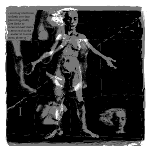
Karen Blissett and Patchwork Girl both express more than one part or selves. Haraway proposes that, “The proper state for a Western person is to have ownership of the self, to have and hold a core identity as if it were a possession.” [38] (Haraway 1991) And that “Not to have property in the self is not to be a subject, and so not to have agency.” [39] (Ibid) Blissett is a living collective of female activists expressing themselves as part of a multitude critiquing male dominance and neoliberalism directly.
So, can we re-mutate ourselves in order to loosen the stranglehold of these neoliberal defaults and forge new or alternative states of agency and psychic freedom? Bazzichelli, says “we should stop looking for the enemy, because who is the enemy today when disruption and its opposition are feeding the same machine?” [40] I do not see it as us feeding the same machine in the absolute sense. Sometimes breaking the loop can be more inline to finding meaning and values with others, and yes this can be difficult. But it does not mean that it’s the wrong thing to do.
For me, Bazzichelli’s proposition is an ideal situation if you are not suffering from pressing societal upheavals. As Blissett points out, there are urgent social situations that need attention. Of course, there are those who’ve fallen so deeply into the void of no return, they will happily serve or become a Prometheus monster without a glimmer of soulful insight. Yet, there is always hope for humanity and the artists and thinkers we’ve explored here have proven this. If this article is about anything it is about how the imagination can forge out new ways in becoming something different than the script we’ve been given. The spirit of the Shelleys, Bazzichelli, the Karen’s, Haraway and Jackson, show us that alternatives are out there available for exploration while at the same time we can still maintain our dignity.
References:
[1] Karl Marx. Grundrisse: Foundations of the Critique of Political Economy. Penguin Classics; New Ed edition (29 April 1993). Martin Nicolaus (Translator). Page 706.
Note: Written during the winter of 1857-8, the Grundrisse was considered by Marx to be the first scientific elaboration of communist theory. A collection of seven notebooks on capital and money, it both develops the arguments outlined in the Communist Manifesto (1848) and explores the themes and theses that were to dominate his great later work Capital. Here, for the first time, Marx set out his own version of Hegel’s dialectics and developed his mature views on labour, surplus value and profit, offering many fresh insights into alienation, automation and the dangers of capitalist society. Yet while the theories in Grundrisse make it a vital precursor to Capital, it also provides invaluable descriptions of Marx’s wider-ranging philosophy, making it a unique insight into his beliefs and hopes for the foundation of a communist state.
[2] Note: The words ‘evolutionary mutation’ refer to ‘technology’ as a default changing process. This includes the constant appropriation and reinvention of human cultures; altering our psychology, perceptions, traits, anatomy, physiology, our DNA, individual and collective behaviour, relations with: objects, machines, work environments, leisure, tools, tribalism, domestic habits and changing attitudes.
[3] Robert Graves. Larousse Encyclopedia of Mythology. Paul Hamlyn, London. 5th Edition, 1964. P.92.
[4] Article. Millions of Jellyfish Invade Nuclear Reactors in Japan, Israel. IBTimes. Jul 09, 2011.
http://www.ibtimes.com/articles/177027/20110709/millions-jellyfish-invade-nuclear-reactors-japan-israel-2011-power-plant-shut-down-unusual-growth-tr.htm
[5] Jellyfish keep UK nuclear plant shut. Jun 29, 2011.
http://www.reuters.com/article/2011/06/29/us-britain-nuclear-jellyfish-i…
[6] Millions of Jellyfish Invade Nuclear Reactors in Japan, Israel (PHOTOS). 9 July 2011.
http://www.ibtimes.com/millions-jellyfish-invade-nuclear-reactors-japan-israel-photos-707770
[7] Ibid.
[8] Jellyfish on the menu as edible fish stocks become extinct. The Telegraph. Louise Gray, Environment Correspondent. 15 Dec 2008.
http://www.telegraph.co.uk/earth/3776788/Jellyfish-on-the-menu-as-edible-fish-stocks-become-extinct.html
[9] Jellyfish Cluster Shuts Down Nuclear Reactor. Sky News, 1 October 2013
http://news.sky.com/story/1148872/jellyfish-cluster-shuts-down-nuclear-reactor
[10] Are we entering ‘The Age of the Jellyfish’? Graham Land. Jun 13th, 2011. Greenfudge.
http://bit.ly/1jOMXrw
[11] Francios Ewald. Two Affinities of Risk. The Politics of Everyday fear. Brian Massumi, editor. University of Minnesota Press. 1993. P.226.
[12] Gareth Edwards, director of the 2014 Godzilla – find link
[13] Ibid P.226.
[14] Friedrich Frischknecht. Human experimentation, modern nightmares and lone madmen in the twentieth century. EMBO Rep. Jun 2003; 4(Suppl 1): S47–S52. Science and Society. http://www.ncbi.nlm.nih.gov/pmc/articles/PMC1326439/
[15] Efforts to ban biological weapons.
The latter are now understood to include not only bacteria, but also other biological agents, such as viruses or rickettsiae which were unknown at the time the Geneva Protocol was signed. However, the Geneva Protocol did not prohibit the development, production and stockpiling of chemical and biological weapons. Attempts to achieve a complete ban were made in the 1930s in the framework of the League of Nations, but with no success.
[16] Gregory Bateson. Steps to an Ecology of Mind. Anthropology, Cybernetics. Publisher: University of Chicago Press. 1972. P491-2.
[17] Bertrand Russell. A HISTORY OF WESTERN PHILOSOPHY And Its Connection with Political and Social Circumstances from the Earliest Times to the Present Day. Chapter VI. The Rise of Science. Page 512. Allen & U.; New impression edition (Dec 1961).
[18] Percy Bysshe Shelley. The Necessity of Atheism. C. and W. Phillips in Worthing. 1811.
[19] Note: Erasmus Darwin (12 December 1731 – 18 April 1802) was an English physician who turned down George III’s invitation to be a physician to the King. One of the key thinkers of the Midlands Enlightenment, he was also a natural philosopher, physiologist, slave trade abolitionist, inventor and poet. His poems included much natural history, including a statement of evolution and the relatedness of all forms of life. He was a member of the Darwin–Wedgwood family, which includes his grandsons Charles Darwin and Francis Galton. Darwin was also a founding member of the Lunar Society of Birmingham, a discussion group of pioneering industrialists and natural philosophers. http://en.wikipedia.org/wiki/Erasmus_Darwin
[20] Maurice Hindle (Editor). Frankenstein or The Modern Prometheus. Mary Wollstonecraft (Godwin) Shelley. Publisher: Penguin Classics (May 6, 2003). Revised edition, Maurice Hindle (Editor) Author’s Inroduction. P. 8.
[21] Ibid P.8.
[22] Note: Luigi Galvani. During the 1790s, Italian physician Luigi Galvani demonstrated what we now understand to be the electrical basis of nerve impulses when he made frog muscles twitch by jolting them with a spark from an electrostatic machine.
[23] Alessandro Volta. Oxford Dictionary of Science. Sixth Edition. Oxford University Press, 2010.
[24] Anca Munteanu. Shelly’s Frankenstein. Commentary by Anca Munteanu Ph.D. Edited by Dr. Stephen C. Behrendt. CliffsComplete published by Hungry Minds 2001. Chapter 3. P.53.
[25] Maurice Hindle. Frankenstein or The Modern Prometheus. Mary Wollstonecraft (Godwin) Shelley. Publisher: Penguin Classics (May 6, 2003). Revised edition. P.XXIV (24).
[26] Lee Sturrenburg. Mary Shelly’s Monster: Politics and Psyche in Frankenstein. The Endurance of Frankenstein. Edited by George Levine and U.C. Knoepflmacher. University of Californian Press. 1982. P.153.
[27] Ibid P.157.
[28] Karen Blissett is Revolting. Interview by Ruth Catlow. New Criticals May 24, 2014. http://www.newcriticals.com/karen-blissett-is-revolting/print
[29] Biopolitics. http://en.wikipedia.org/wiki/Biopolitics
[30] Frankenstein’s Bankers By Keith Fisher. The Global Dispatches. November 26, 2013.
http://www.theglobaldispatches.com/articles/frankensteins-bankers
[31] Simon Penny. Consumer Culture and the Technological Imperative. Critical Issues in Electronic Media. State University of New York Press. Editor, Simon Penny. 1995. P.63.
[32] The Militarisation of Cyberspace. Publication — Cyperpunks: Freedom and the Future of the Internet. Julian Assange, Jacob Appelbaum, Andy Moller-Maguhn and Jereme Zimmerman. Or Books, New York and London. (2012) P.33.
[33] Mary Flanagan and Austin Booth. Reload: Rethinking Women and Cyberculture. The M.I.T Press. Cambridge, Massachusetts, London England. 2002. P.31.
[34] Margaret Lowe Benston. Article 1.2. Women’s Voices/men’s Voices: Technology As Language. Publication – Inventing Women: Science, technology and Gender. Edited by Gill Kirkup and Laurie Smith Keller. Polity Press, 1992. P.35.
[35] We Need to Talk About Networked Disruption, Art, Hacktivism and Business: An interview with Tatiana Bazzichelli. By Marc Garrett – 13/02/2014.
http://www.furtherfield.org/features/interviews/we-need-talk-about-networked-disruption-and-business-interview-tatiana-bazzichel
[36] Donna Haraway. Simians, Cyborgs, and Women: The Reinvention of Nature. Free Association Books. 1991. P.180.
[37] Flickering Connectivities in Shelley Jackson’s Patchwork Girl: The Importance of Media-Specific Analysis. N. Katherine Hayles. 2000.
http://pmc.iath.virginia.edu/text-only/issue.100/10.2hayles.txt
[38] Donna Haraway. Simians, Cyborgs, and Women: The Reinvention of Nature. Free Association Books. 1991. P.135.
[39] Ibid P.135.
[40] We Need to Talk About Networked Disruption, Art, Hacktivism and Business: An interview with Tatiana Bazzichelli. By Marc Garrett – 13/02/2014.
http://www.furtherfield.org/features/interviews/we-need-talk-about-networked-disruption-and-business-interview-tatiana-bazzichel
[41] Karen Blissett is Revolting. Interview by Ruth Catlow. New Criticals May 24, 2014. http://www.newcriticals.com/karen-blissett-is-revolting/print
2 March: 1812 Crossing of the Berezina scenario for Richard Borg, Commands & Colors Napoleonics.
6 April: Mac Gerdts, Imperial 2030
4 May: Bruce Quarrie and Russell King, Apokalypse 1945
1 June: Ty Bomba and Joseph Miranda, Russian Civil War 1918-1922
13 July: Greg Costikyan, Pax Britannica. CANCELLED
3 August: H.G. Wells, Little Wars.
“Political theories are only made to die in the war of time. Like military units, they must be sent into battle at the right moment; and whatever their merits or insufficiencies, they can only be used if they’re at hand when they’re needed.” – Guy Debord.
Clausewitz v. Jomini at the Ludic Science Club. 1812 Crossing of the Berezina scenario for Richard Borg, Commands & Colors Napoleonics.
The first of 5 monthly board game ‘Ludic Science Club Sunday Sessions’ organised by Class Wargames at the Furtherfield Commons. This Sunday join writer and academic Dr Richard Barbrook with Class Wargame collaborators for the 1812 Crossing of the Berezina scenario for Richard Borg, Commands & Colors Napoleonics. All Welcome.

Dr Richard Barbrook is the author of Imaginary Futures: From Thinking Machines to the Global Village. In 2008 it won the Marshall McLuhan Award for Outstanding Book of the Year in the Field of Media Ecology. He is a founding member of Class Wargames and co-wrote the script to the group’s film: Ilze Black (director), Class Wargames Presents Guy Debord’s The Game of War.
6th April: Mac Gerdts, Imperial 2030.
4th May: Bruce Quarrie and Russell King, Apokalypse 1945.
6th July: Greg Costikyan, Pax Britannica.
3rd August: H.G. Wells, Little Wars.
All sessions begin at 2.00pm.
To book sessions please contact: ale AT furtherfield DOT org
Furtherfield Commons,
Finsbury Park,
London N4 2PF
To Visit view link – http://www.furtherfield.org/gallery/visit
My Voice Means is a workshop that gives participants an opportunity to listen mindfully to the sound of their own voice, to discover the many layers of its meaning, and to discover how this process can be expanded by means of technology.
In a three hour session you will:
Cost: £20
To book a place visit http://tinyurl.com/mnwbj6h or contact info@contemplatech.net
Delivered by Contemplatech, a creative collaboration by Ron Herrema and Ximena Alarcón
Featured image: Jane and Louise Wilson – ‘False Positive, False Negative’ (2012 Screen print on mirrored acrylic)
The Negligent Eye the Bluecoat Liverpool Sat, 08 Mar 2014 – Sun, 15 Jun 2014 http://www.thebluecoat.org.uk/events/view/exhibitions/1971
Featuring artists: Cory Arcangel, Christiane Baumgartner, Thomas Bewick, Jyll Bradley, Maurice Carlin, Helen Chadwick, Susan Collins, Conroy/Sanderson, Nicky Coutts, Elizabeth Gossling, Beatrice Haines, Juneau Projects, Laura Maloney, Bob Matthews, London Fieldworks (with the participation of Gustav Metzger), Marilène Oliver, Flora Parrott, South Atlantic Souvenirs, Imogen Stidworthy, Jo Stockham, Wolfgang Tillmans, Alessa Tinne, Michael Wegerer, Rachel Whiteread, Jane and Louise Wilson.
The Negligent Eye revolves around the way a digitally-native generation of artists – particularly printmakers – are questioning their relation to the digital, using the notion of ‘scanning’ as a kind of mid-state of the creative process of the human-digital hybrid. The show is co-curated curated by the Bluecoat’s Sara-Jayne Parsons and head of printmaking at the RCA, Jo Stockham, and features several works by her graduates, and other artists from around the RCA, such as Bob Matthews and Christiane Baumgartner. “The relationship between the material and virtual worlds is a question, a set of contradictions we are all inside and how technical images exert their influence on our everyday experience is of ever increasing importance.” Jo Stockham.

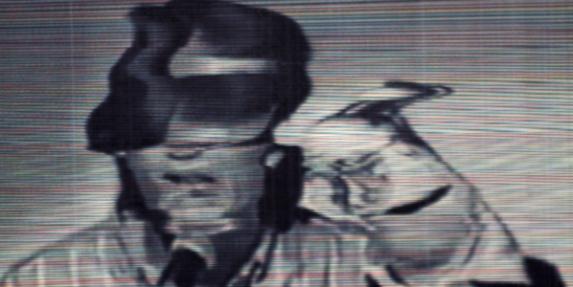
In her article Too Much World: Is the Internet Dead? Hito Steyerl asks what happened to the internet, after it died – that is, in an era of the “post-internet” after it stopped becoming a possibility, even in the midst, because of, and symptomized by, its permeation of everything. Steyerl is a major force in understanding our relationship to digital images, and her use of ‘death’ occurred to me often during viewings of this show and surrounding events, particularly as it could be applied to the post-digital.
So in a sense, I experienced the show as an autopsy of the digital image. From the tragic, simian face looking out from the first ever digital image, taken by Russell Kirsch of his son in 1950, exhibited at two points in the exhibition like an insistent memory. To Marilène Oliver’s figures from her 2003 Family Portrait series where bodies have been evoked as series of horizontal cross-section prints layered on acetate, so that they appear as though stored, but only partially in this world; the exhibition continually references, exemplifies and unpacks the death of its medium.
The post-digital is a paradoxical term – at once assuming the reliance of all contemporary culture in digitality, but also looking past it; affirming the death of a form, while embodying its afterlife. This is what Elizabeth Gossling’s images of a dead comedian says to me, when it is scanned from a computer screen and printed back on to archival paper, with his image waving from behind an ether of static, living in the solid pulp. The best works in this show, Gossling’s included, speak very eloquently about the post-digital, and how artists are motivated into hybrid forms of production, always acknowledging and working in a context of the saturation of the digital.

The notion of saturation, and its implications of the dissolution and liquidity, itself saturates the show: the first work, Maurice Carlin’s monumental print, scrolling down from the ceiling of the vide space is in one sense a spectral ancestor of Monet’s waterlilies, but with gashes and pustules of CMYK colour oozing up from behind the serine blue and greens of the pond, and white pixel-like rectangles plugging up the gaps; London Fieldworks’ 3D image of data collected from Gustav Metzger’s brain while he thought of nothing, is presented on a screen with a trickling sound – perhaps of information leaking inexorably back in?

Marilène Oliver’s glitch-sculpture of body parts fused in the heart of the 3D scan/print machine hang in the chute of the gallery corridor, their surfaces mid-ripple as though submerged; Jo Stockham’s etherized black and white shot of an element of the London skyline, seen perhaps through a teary bus window, but now writhing with red in its afterlife as a veined and depthless skin.

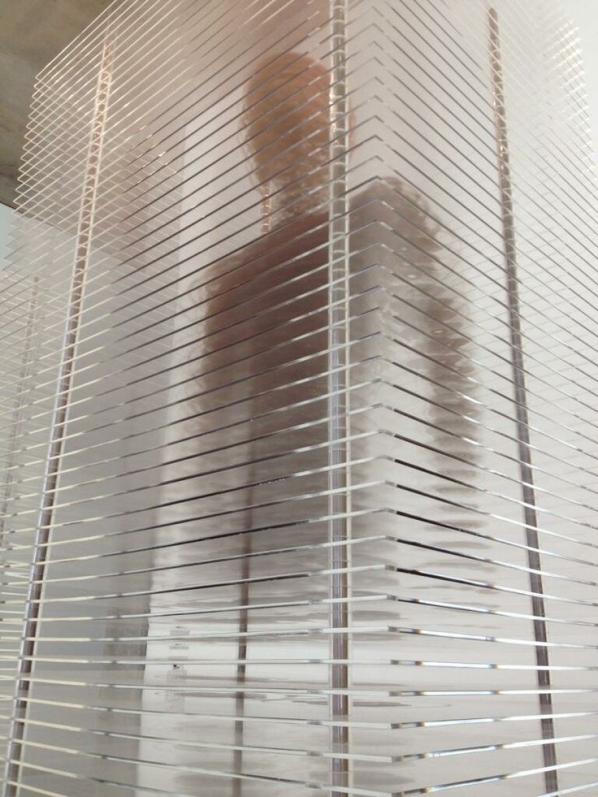
Using damage and error to expose the affectivity of a medium, particularly in the context of the digital is the central mode of Glitch Art. I have already used the term glitch to describe the aesthetic of Marilène Oliver’s sculptures, and the traces of digital-to-digital scan in Gosling’s work and the rich material pixilation of Christine Baumgarner’s inscription of CCTV camera stills into largescale wood prints, also contain these signatures.
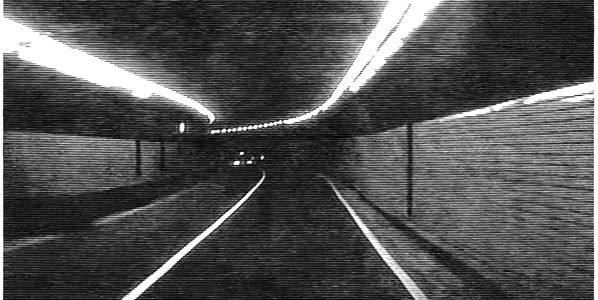
If there is a criticism to be leveled at these admirable and, frankly gorgeous, works. It is in their distance from what Rosa Menkman refers to as the moment(um) of the glitch. In the medium of print-making, the material fact of the object dominates, and with this show, no-matter the stated and playful interest in the ‘between-state’ of scanning, there remains the focus on material production – and therefore an irrefutable commodification.
Prints on archival paper and tempered steel, casts in plaster and large-scale hardwearing plastics, each speak of an appropriation of the tactical and fluid glitch, and its migration into commodifiable form. Maurice Carlin’s large-scale printwork could adorn a restaurant wall, just as Monet’s waterlilies functioned during his era, and Oliver’s sculptures also speak and modernise the language of sculpture as produced for private collections through the ages.
There are works also which say nothing of the ‘post-digital’, such as Imogen Stidworthy’s Sacha, a deeply thoughtful study of a wire-tap transcription ‘artist’ Sacha van Loo. Stidworthy’s enigmatic works are often hard to pin down thematically, and here it feels like the loft-type space of Gallery 3 has been used as an outer limit to the reach of the show. And then there are other works that say nothing at all and lessen the show’s conceptual rigor. I see Jeaneu Project’s peice, and think ‘smudge lawn’. I see a Cory Archangel print and a Rachel Whitereed miniture and their names flash through my consciousness like a Google Glass press release.
Truly though, this is a really refreshingly vibrant and precient show at the Bluecoat, and a great partner to the Mark Lecky exhibition featured at the venue last year in its pressing contemporaneity. The exhibition has also been a fulcrum for a really interesting series of events which have dealt with image production – including a day of talks and presentations, i-Scan, artist talks from contributing artists such as Imogen Stidworthy, and independently curated events such as the second in Deep Hedonia’s excellent Space/Sound series, where artists such as Madeline Hall, Jon Baraclough, Simon Jones and Andy Hunt explored the multiple angles from which digital scanning can be exploited as a performance and av medium. As with the Mark Lecky show, there is something about the context of the Bluecoat, as Liverpool’s most paradoxical space, which delivers an archival retrospective out of the most up-to-date material, and this tension is what pulls appart the body of works before us.
The Rubik’s Cube is not just a forgotten toy from the 80’s. The fact is that it’s even more popular than ever before. You can play with this great puzzle here.
First of 6 articles as part of the Piratbyrån and Friends exhibition at Furtherfield. Mariana Delgado, Coordinator of El Proyecto Sonidero (Mexico), writes about the Polymarchs posters (1980-1990) by Jaime Ruelas. Translation by Tess Wheelwright.
Panther / Jaime Ruelas / Polymarchs. On How We Came To a World of Legend By Mariana Delgado, Coordinator of El Proyecto Sonidero, I met José Luis Lugo in 2009 in the office above the Publicidades Panther print shop in Mexico City. Lupita La Cigarrita introduced us: sonidera, collaborator and number one follower of Sonido La Changa, el Rey de Reyes – the King of Kings. Later we learned from Lupita that José Luis had an important collection of sonidero event posters and flyers. Marco Ramírez, the co-founder of El Proyecto Sonidero, grew enthusiastic.
As soon as we released the book Sonideros en las aceras, véngase la gozadera (roughly Sonideros on the Sidewalks: Bring on the Revelry) in 2012, we began to see what should come next. In 2013 we launched the Proyecto de Gráfica Sonidera, in association with Panther, and in collaboration with draftspeople, poster artists, graphic designers, graffiti writers, sign painters, printers, promoters, collectors and researchers.
We are taken back to the origins of the tropical sonidero movement, which began in the 60s with turntables and LPs – loudspeakers and tweeters set up in the streets, dances thrown in the barrio. Over time various sound systems are added, each with its own crew; soon the multicolored Aztec or robotic lights are streaming. The biggest parties feature close to 50 systems at once, working simultaneously for hundreds of thousands of people. Music is introduced and mixed the Mexican way. Equipment is fiddled with; beats are slowed. Bass rumbles out from walls of speakers. Followers take their places and multiply along with vernacular genres. Transsexual dance clubs form circles on the dance floor; here a family, there a group of insiders – la banda – make their way through the crowd. The mic starts up, amplifying the shout-outs that will circulate the continent on CD and DVD, through streaming, links, posts. From Peñon de los Baños aka Colombia Chiquita to Neza York; from the barrio Tepito aka Puerto Rico to Chimalwaukee, out to all the brothers in Illinois.
In this world, all hatched from La Sonora Matancera. Cumbia and salsa are the queens of a grand court of rhythms. The Virgin of Guadalupe reigns supreme; it’s her congregation. Changó, San Judas Tadeo, and the Santa Muerte share the power thereafter. Epic is important, and family, too. What begins as a passion for Cuba soon builds: music from Colombia, Puerto Rico, Venezuela, Ecuador, Panama, Peru, the Dominican Republic, Buenos Aires, New York… The sonideros leave behind the established Mexican labels and their standardizing limitations, heading out on their own to comb the continent. They become vinyl diggers, import records, discover bands and musicians; they turn into promoters, create record companies and pirate labels, compile mixtapes to disseminate in the street markets and plazas, at parties and on commercial stands, through the internet.
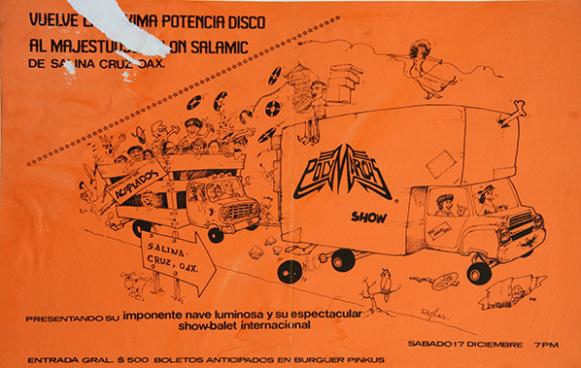
In the margin within – those more notorious neighborhoods of the Distrito Federal – embroidered logo jackets circulate, lending publicity to the sonidos along with their cards, posters, flyers, banners. Nonetheless, fewer and fewer dance parties are thrown. The city government has issued a discretionary ban of sonidero events in public spaces, canceling even traditional dances like the anniversary celebrations of Tepito’s markets. In the outer margins, ringing the DF and beyond, painted walls announce upcoming events and sonido trailers take over the streets. The dances go on.
We aren’t as familiar with the electronic scene, headed by Polymarchs. Our inroad is through the graphic materials comprising the collection Panther has amassed since 1979, which he rightly considers his primary asset. It all began in the Zona Rosa, where he used to go to trade posters, leaflets, stickers. At thirteen he formed part of the Polymarchs crew, coiling cables. Later he became a publicist, promoter, producer. He never stopped his gathering; stacks of paper tower in the office. Hundreds of posters and dozens of original drawings from the golden age of Hi-NRG pass in front of the camera, as José Luis remembers key scenes and events from this world: when they brought Gloria Gaynor to Mexico for the first time, when Sylvester came, when they packed the World Trade Center.
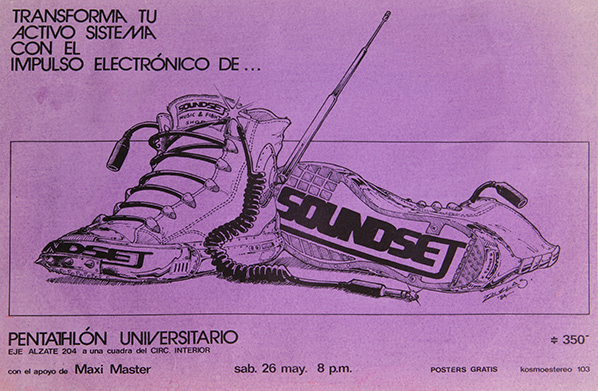
We are introduced to the world of artists and designers who created an imaginary to suit the precursors of the genre: pharaonic, galactic, utopian, spectacular, and futuristic. Always epic. Tailored to the moment, to the experience of the fans. The posters of the electronic sonidero movement are unique in format, employing unexpected techniques and materials; they are distinct, painstaking, sensational, new. In contrast, the works of tropical sonidos follow in the typographic vein of Mexico’s Gráfica Popular – reminiscent of the wrestling, taking the freedoms of the tropics, whether with box cutter or in full pixel. In the world of disco, Hi-NRG, and techno, the graphics are like the sound system: cult objects, concepts, myth.
“Do you want to meet Jaime Ruelas?” asks José Luis. The master of ink drawing, creator of logos and illustrations as iconic as La Changa or Polymarchs themselves. Of course we do. We are his fans, and we are an army. We arrive nearly punctually to the interview, with photography, audio and video gear in tow. Nearly punctually, because Jaime is already waiting; the son of a watchmaker, he knows machines, design and sound from the inside. He also knows the history of Polymarchs well, and from the beginning. Polymarchs’s first gig took place in his apartment in Tlatelolco. Later, Jaime became the sonido’s first DJ, before switching his focus to images.
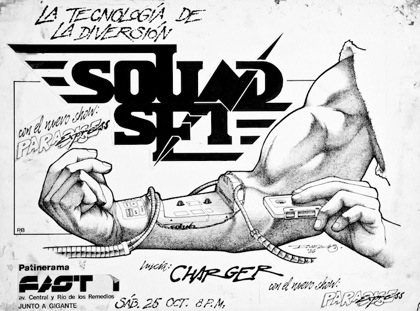
Like the sonidos thriving now in the capital, Polymarchs began in Puerto Ángel, on the Oaxaca coast, with a modest set-up – just a single Telefunken console and two baffles. The collective was formed by three siblings in 1975: Apolinar, Elisa and María de los Ángeles Silva Barrera. In 1978 they moved to Mexico City. Apolinar took charge of the sonido, and with Jaime Ruelas he discovered disco and Hi-NRG. The tenacity of Polymarches transcends mere selection of musical genres; the approach here is different. With tropical sonidos, the music, the equipment, the role of DJ and MC are the purview of one person, a single all-powerful figure operating from behind the console. Polymarchs is coming from somewhere else, assembling great towers of scaffolding, creating a spectacle, an experience, an environment. Neither DJ or MC, this is an entire machine. Polymarchs designs, produces and operates structures of light and sound as have never been seen before, radiant vessels that travel, carrying immense tech crews and companies of retro-futuristic dancers, from Tenochtitlan to outer space. There are explosions in the cosmos. On the floor all hands are up, cellphones by the thousands.
When Apolinar Silva and the Polymarchs team arrive at the Centro Cultural de España to give a conference in the context of the Proyecto de Gráfica Sonidera, the auditorium is brimming. Followers sport the distinctive t-shirts and jackets, hold up posters they’ve collected, wave cellphones. Apolinar is glowing; he is the supreme authority and, more than mythic, he is mystic. The audience takes the microphone to share their experiences. Like the time a Polymarchs event was organized in Mexico City’s Zócalo and what people thought was an earthquake turned out to be the earth shuddering under such dance. Below, in one of the exhibition spaces, Polymarchs set up a kind of black-light temple, aglow with, among many others, the visions we now share now with you.
The Proyecto de Gráfica Sonidera was an intensive program that resulted in records and research, specialized workshops and others for children, the painting of walls, the exhibition of graphic, photographic, and video material, and a series of talks along with book and documentary releases. We had the honor of including a drawing by Jaime Ruelas, and we kicked off with a dance party dedicated to Polymarchs… which was epic. There was a little boy who stole the dance floor, winning it against the odds from the more seasoned dancers.
All this was made possible thanks to many people and institutions. Shout-outs to the following generous collaborators: Marco Ramírez, José Luis Lugo, Javier Echavarría, Jaime Ruelas, Livia Radwanski, Mark Powell, Mirjam Wirz, Rocío Montoya, Tonatiuh Cabello, Diego Delgado, Alan Lazalde, Sonido Fajardo, Luis Sánchez, Héctor Rubí, Julio Díaz Corona, Sonido Leo, Christian Cañibe, Eduardo “Aníbal” Dueñas, Eleazar “Canuto” Escobar and the shop personnel of Publicidades Panther, Publicidades Lupano, Aisel Wicab, Citlali López Maldonado, Pedro Sánchez, Marisol Mendoza, Lupita La Cigarrita, Sonido Pío, Víctor Hernández, Edgar Ramírez, Laura Zárate, Griska Ramos, Mirna Roldán. Official respects to FONCA, to CONACULTA, to the Fundación Alumnos 47 and to the Centro Cultural de España.
Furtherfield presents DIGITAL ZOO: Life from the world wild web, a touring exhibition that invites audiences to explore and marvel at new patterns of human and digital behaviours in the network age.
Featuring Andy Deck, Mary Flanagan, Genetic Moo, Liz Sterry, Thomson & Craighead, Pete Gomes, and a new interactive mobile artwork commission by Transnational Temps.
DIGITAL ZOO features experimental software, interactive videos, installations, workshops, networked and mobile media created by internationally recognised artists inspired to explore the ways in which our lives are being shaped by digital technologies, and challenge the concept that digital art is only accessible in galleries or online.
Since 2008 artist group Genetic Moo have been developing a series of interactive video installations using choreographed video clips that respond in a variety of life-like ways to user motion and touch. With Animacules they take inspiration from the 19th century sea life illustrations of Ernst Haeckel and the work of the 17th century Dutch scientist Antonie van Leeuwenhoek to create a dark sea of wiggling, luminescent creatures that gorge on torch light.
Internationally renowned artist duo Thomson & Craighead create a new site-specific installation especially for the DIGITAL ZOO tour. A wall of propaganda style posters of the Tweets and other status updates drawn from people in the local area of the tour venues, offers a poetic snapshot of the invisible conversations taking place, “the idle mutterings of ourselves to ourselves as a form of concrete poetry.” The work is based on the artists’ London Wall series shown at the Museum of London (2010), Furtherfield Gallery (2012) and Carroll/Fletcher (2013).
Liz Sterry is an artist fascinated with the way people use the Internet to express themselves. In Kay’s Blog she presents an exact physical replica of a young woman’s bedroom, recreated through information, images and notes about her daily life that the real Kay posted on her public blog. With social media often used as a platform for self-expression and performance, the work questions how much of ourselves we share online with strangers without even realising it.
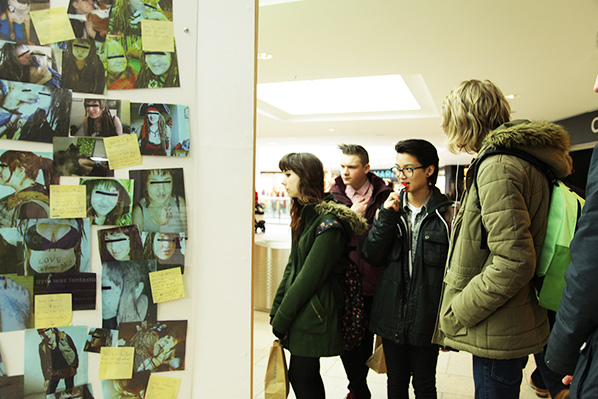
With his novel use of Twitter, US artist Andy Deck savours the wildness of everyday language with people around the world, inspired by the wealth of nature-related sayings passed down over centuries. He invites audiences to help him build a bestiary of animal idioms using social media and an interactive installation.
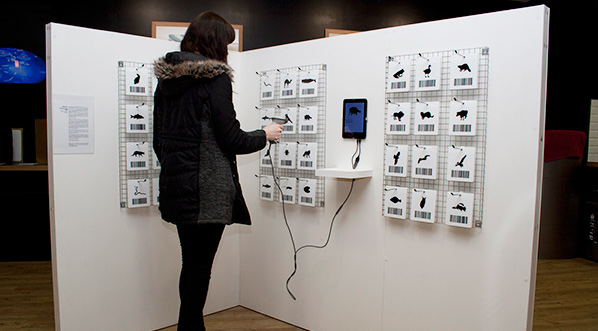
Experimental filmmaker Pete Gomes invited residents in Sunderland with no acting experience to participate in a 45 minute long acting session. Each participant was directed to perform on camera for a single five-minute take. Screened as a series, Cycle of Purposes questions reality and artifice by exploring how thoughts and feelings are acted, amplified, exaggerated and stylised every day in response to different people and places.
Mary Flanagan travels overland and undersea, in virtual worlds built and inhabited by other virtual beings. [borders] is a video documentation of her walks in beautiful and hypnotic landscapes that expose the boundaries of the virtual world by testing its edges. Her walks are inspired by Thoreau, the great American nature writer and walker, who, avoiding highways, chose instead to wander in order to understand the spiritual possibilities of the landscape.
Mall of the Wild by Transnational Temps is a new commission created especially for Digital Zoo. Players help the famous artist Magritte to find fake wildlife in the shopping centre. Equipped with a store map and a smart phone app, they have limited time to find a number of representations of wild animals visible in the products of the shopping centre. They map rare species and share their wildlife documentary photos in the online “Ceci n’est pas…” collection via social networks.
In creating DIGITAL ZOO, Furtherfield believe that digital networks and social media offer the potential for a more open relationship between artists and audiences, changing the life of an artwork in the world, and the ways in which people encounter it, and sometimes collaborate in its creation.
Personal information is exchanged with increasing frequency, and daily lives are becoming ever more public, as if in a public zoo. People are both animals and visitors; hunters, trackers, observers, naturalists and zookeepers; and educators and pundits. The longer-term social effects of this collective public performance are awaited…
The exhibition was accompanied by a series of creative workshops inspired by Crow_Sourcing for children aged 6-11 years old.

Curated and produced by Furtherfield in collaboration with Culture Code and Land Securities.
Digital Zoo is supported by Arts Council England through the Strategic Touring programme.
Crow_Sourcing by Andy Deck was made possible with funding from the Jerome Foundation, and was a 2012 Commission of New Radio and Performing Arts, Inc. for its Turbulence website.
Featured image: Screen capture of Joseph DeLappe’s intervention in America’s Army
The Fresno Art Museum, in collaboration with the Fresno State Center for Creativity and the Arts, is exhibiting “Social Tactics,” a mini-retrospective of the work of Joseph DeLappe, a new media artist and director of the Digital Media Program at the University of Nevada, Reno. The exhibit has been running alongside the construction of a to-scale sculptural reproduction of an MQ1 Predator Drone on the campus of Fresno State, coordinated by DeLappe and executed by students and volunteers. I had the opportunity to interview DeLappe about his work, and the way it connects to militarism, memorialization, and embodiment. His work has been an ongoing critique of games that look like war, and warfare that looks like gaming – insisting that, within the hall of mirrors that forms “simulation culture,” reality still must be accounted for, and attended to.
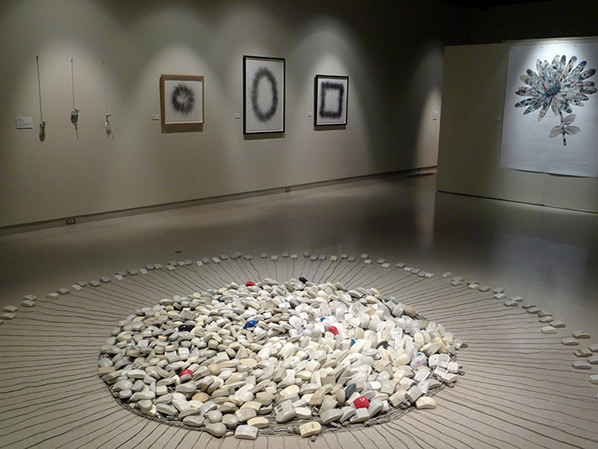
The earliest work in the show is a series of riffs on the computer mouse. The “Mouse Mandala” (2006) splits the difference between a trash heap and an object of meditation – a small sargasso of computer mice is ringed by a circle of yet more mice. The outer radius, tethered to the central mass by extended mouse cords, makes the whole sculpture resemble a dingy grey sun – one that has been pawed by innumerable, invisible fingers. His “Artist’s Mice,” first begun in 1998, are a series of mice that have drawing implements attached to them, so that the mice can draw while being utilized for their normal activities. The drawing attachments resemble braces, as though the mice are being rehabilitated from an injury – the drawings produced by them are beautiful abstractions, circular or square scribblings that give the illusion that, while working or gaming or goofing off, we could also be making art – skimmed off the surface of our interface with our machines.
All these mice, removed from the context of their guiding hands, inevitably – if ambiguously – echo with a pair of outsized sculptural hands, titled “Taliban Hands” (2011). Modeled from white plastic polygons, the left hand in particular looks as if it could be cradling an invisible, equally outsized mouse. The right hand has its pointer finger extended, as if it were about to press a button. The fact that the hands are upturned short-circuits those prosaic possibilities of gesture, turning them into gestures of supplication. The hands were constructed from 3D data extracted from the model of a Taliban fighter in the game “Medal of Honor,” and once you learn that, it’s easy to imagine the right hand gripping a gun, the extended finger wrapped around the trigger. The disembodied nature of the hands is discomfortable – it feels like a dismemberment, a pair of hacked war trophies offered up for display.
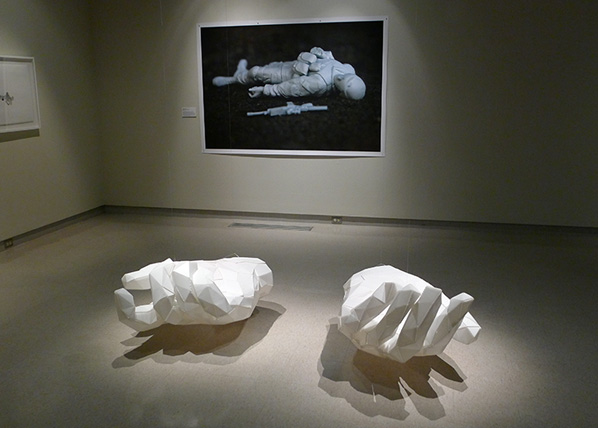
DeLappe also used polygon modeling for a small replica of a US military Drone that hangs in the gallery, which served as a prototype for the life-size drone constructed as a memorial on the grounds of Fresno State. Where the “Taliban Hands” and drone prototype are white and pristine, the Drone Memorial was designed to be inscribed upon. In a public ceremony, volunteers wrote the names of 334 civilian casualties of drones on the faceted surface of the sculpture.

DeLappe’s years-long project “dead-in-iraq” (2006-2011) is represented by a machinima video and a large-scale digital print modeled after his fallen avatar in the US Army recruitment game America’s Army. Over the course of the American war with Iraq, DeLappe entered the multiplayer first person shooter game, and at the start of each mission threw down his weapon and began typing in the names of US military personnel who had been killed in Iraq. His avatar was invariably shot, either by the opposing team or by members of his own team. In the latter case, it’s as though his killers are trying to gun down an itch of conscience – or the nuisance of reality itself. In the machinima of this intervention, when Delappe positions his camera above his virtual corpse, there is sometimes a very profound effect of quietude. The body occasionally twitches, in a gruesome effluvium of game physics, or puffs of smoke are kicked up by stray bullets – but those filigrees of activity only heighten the feeling that the game has moved on. It brings to mind bodies left on real battlefields, unattended to, abandoned to the weather and the birds and the insects while the important business of fighting continues.

“Project 929: Mapping the Solar” (2013) echoes the circularity of the Mouse Mandala. For the project, DeLappe rode a bicycle 460 miles in a circuit around Nellis Air Force Base in Southern Nevada. The bicycle was outfitted with an apparatus that held a series of pieces of chalk to the road – DeLappe was both marking a chalk outline around the base, and mapping out the dimensions of a solar farm that could power the entire United States, based on a size estimate from the Union of Concerned Scientists. The project is shown through a series of photographs, a video, and the modified bike itself, with a circle of chalk stubs positioned under the frame. In some ways, the piece expands the logic of the “Artist’s Mice” to a different scale. Instead of the hand being the driving force, the whole body is the recorded object, and rather than being confined to the top of a desk, the drawing itself is allowed to range across hundreds of miles. In this case, the drawing is the opposite of accidental – it’s utopian.

Not represented in the show – but a point of discussion in our interview – was the “Salt Satyagraha Online” (2008), a 26-day durational performance which used a customized treadmill to control the movement of a Second Life avatar modeled after Mahatma Gandhi. On the treadmill, installed at Eyebeam Art and Technology in New York, DeLappe walked the 240 miles Gandhi marched in protest of a British Salt tax – driving his avatar, step by step, across the territory of Second Life. That project was yet another of DeLappe’s exploratory reconfigurations of the relationship between protest, performance, and physicality.
Chris Lanier: With the mouse-derived work, from the “Mouse Mandala” to “The Artist’s Mouse” and the drawings that are made as you’re playing a game – what was it like putting those things together at this time, when it’s possible to imagine the disappearance of the mouse? Right now there is eye-controlled software , and even thought-controlled software…
Joseph DeLappe: Part of my thought process when doing the mouse pieces was doing a sort of reverse engineering, and trying to figure out what that thing is, because it really is a useless little object otherwise. It’s not a hammer, it’s not a screwdriver, it doesn’t have a function beyond plugging into a computer to allow you to move around this detached marker on a screen. There’s already something separate happening, and so attaching a pencil to it was a way of perhaps returning it to its roots. It’s sort of a drawing device, a pointer, all these things that a pencil might be, but I was intrigued by the possibilities of extracting some kind of meaning out of it.
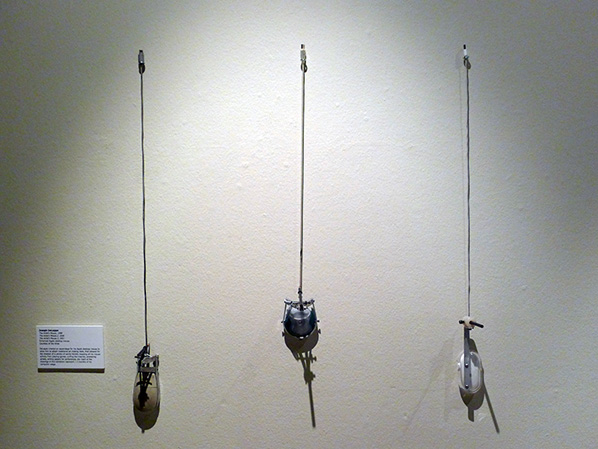
CL: It’s funny because it’s an extension from the computer to the human, like an organ that extends itself to us, and I wonder what you think of that interface becoming even more disembodied. If the hand is taken out of that circuit, what do you think that says about our relationship to the screen?
JD: I think it will change it. I can really only speak from my experience, not having played the wii, or things like that. I messed around with the kinect a little bit. When you’re putting the body into works like what I did in the Gandhi project (which is something that’s not in the exhibition) – I placed myself on a treadmill to actually interact with Gandhi, walking him through Second Life. My body became the game controller in a kind of way, the mouse – or however you want to refer to it. I didn’t realize it at first but there was an intrinsic alteration of my relationship to the experience going on, on the screen. I wonder if that deterioration of that awkward physical thing you have to do with the mouse or track ball, if that’s going to bring us closer to our machines. As it becomes gestural and everyday, I suspect it will become more naturalistic.
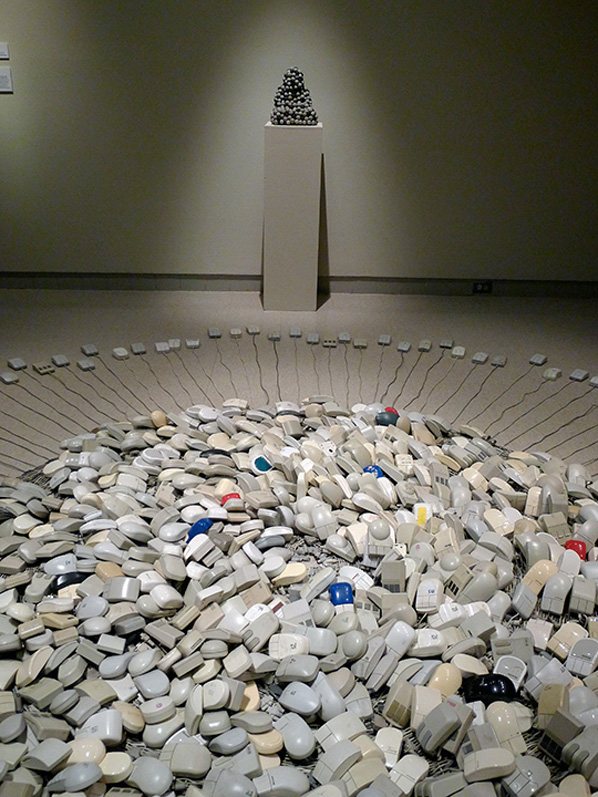
CL: Listening to you talk about the Gandhi project, it seemed to bring you more directly and somatically into that virtual world.
JD: Which was very unexpected. I went into that project from a conceptual durational performance ideation – this would be an examination of “performance,” in quotes. Performance and protest. It was done at Eyebeam in New York, and I was thinking about the many durational performances that had taken place in New York, from Tehching Hsieh, to Linda Montano, to Joseph Beuys. I had done performance works online for almost a decade prior to that piece, but that action that the body involves, that was just transformative. It was amazing and intriguing and kind of disconcerting in a way, because I found myself completely drawn into that experience, and connected to my avatar in a way that I never had previously. I was walking in Second Life, which you’re really not supposed to do – you’re supposed to teleport – so I was navigating over mountains and in places people don’t generally walk. And Gandhi would fall off a mountain-side into the next region, and I’d find myself almost falling off the treadmill. Or, after finishing the performance for the day, walking to the subway and thinking I could click on someone to get information. It became this mixed reality in my head.

CL: Embodiment seems to be a crucial part of your practice. With “Taliban Hands,” you extracted hands from Medal of Honor, and brought them into physical space. In the “dead-in-iraq” project you brought the names of the dead soldiers into the game space of America’s Army. It seems that bringing bodies into that space, or extracting bodies out of that virtual world, is important to you.
JD: Well, each of those pieces had different but connected intents. With the America’s Army project, “dead-in-iraq,” the intent was to embody the reality of the war, to bring it to this virtual space. So when you’re dying and or you’re killing in that virtual space, and you see these names go across the screen, you realize that this is an actual person that died in that conflict. That might change another player’s thought process about what they’re doing, and about that visualization – when you get shot you end up hovering over your fallen avatar. So there is this attempt to change how one considers that experience.

CL: It’s interesting, with the self-portrait as dead soldier – the way of marking yourself as dead is to show the body within the game. Moving you from a first-person space, a first-person-shooter space, into a third-person space. The body becomes a marker of death.
JD: That is certainly a problematic aspect of that game. I think the vast majority of the people playing the game – certainly there are some veterans and active military – but there are more people who aren’t in that situation. So there is this kind of temporary inhabiting of the US military. Bringing this out into real space is an attempt to drive home the connection of that fantasy pretend space to a very real space. It’s like bringing it to a sort of mid-ground. The America’s Army game is in fact official US military virtual space. I mean they own it. It is federal space – it’s part of the system of hundreds of bases around the world.

With the Taliban hands, it’s a similar attempt, but with a different thought process. With the America’s Army game, one of the most devilish things they did with that game is that they’ve created a system where everybody gets to be a good guy. There are two teams, and you see your team of 2 to 12 cohorts playing against 2 to 12 other cohorts. You always see yourself as Americans. They always see themselves as Americans, but you see each other as terrorist enemies. So there’s this digital switching, where they see your avatar as a Middle Eastern terrorist and vice versa.
CL: The strange thing that happens is that you’re inhabiting two bodies.
JD: Yeah, at the same time, exactly. But in the Medal of Honor game it’s not like that. That was a controversial game when it came out in 2010 because you could play as a Taliban killing American soldiers. It was the only game that was actually banned from military bases. They ended up changing it before they released it – they weren’t called “Taliban,” they were called OP 4, which stands for opposition forces. But you’re still Taliban. So anytime that game is being played as an online match, 50% of the players are being American and 50% are being Taliban.
I found that really curious. I started extracting these maps from that particular game, and then diving into this incredible morass of 3-D data. I would have to dig through all of this wireframe stuff to find these objects, and I found the Taliban and started deleting everything else, and landed at one point with the hands. It was just so intriguing – these hands were gorgeous. When they became disembodied from their source and I started visualizing them in the 3-D software, they took on a kind of Da Vinci-esque quality – like the hand of God or something.
CL: There is a gestural quality to it.
JD: Yeah, exactly.
CL: I’m curious if this work has brought you more into contact with the idea of simulation. Simulation can be useful, obviously – it allows you to think through a situation before it’s actually encountered. But then it can actually introduce errors into the actual [situation], because the simulation doesn’t correspond absolutely to reality.
JD: I don’t know if this connects to your question at all, but if you die in America’s Army – this is standard in most shooter games – they have something called the ragdoll effect. It’s a simulation of your body going limp. It’s meant to give a naturalistic [simulation of] you collapsing, and you’re dead. But the effect is actually quite different – there are points where your avatar, in that space – it can be almost comical, like you’re going to do a somersault. And every time you actually die, your body – because of that ragdoll effect – you watch the video and the avatars do this kind of shaking thing, that’s part of this ragdoll effect. When I first saw it I thought it was this macabre death spasm, but it’s just part of the simulation. It’s not meaningful in the context of the game, but it becomes meaningful in the work that I did and in the recording of it.
CL: It’s funny that a simulation can have these unintentional, almost poetic, effects – if you are attuned to it.
JD: And that’s a good metaphor for the whole project, right? It’s taking this simulated wargame – this recruiting tool – and re-branding it, remaking it. It’s a way to say: “No, let’s see if we can make this game be about this, not about that.” I appropriated the space – I took it over in a simple way, and I think it was quite effective.
CL: You frame yourself as an activist as well as an artist.
JD: Yeah, and sometimes uncomfortably. I drift in and out of that. There’s a difference between being an artist and activist. And right now I’m feeling rather reticent [about the “activist” label] – but I’m an artist at base. It’s a little bit more symbolic I guess…
CL: Making a political act in a virtual space – is that inherently symbolic?
JD: That’s a really interesting question because in the progression of my work, I think my work has slowly emerged towards existing in a real space – with the bike-riding around the Air Force base, and now building a life-sized predator drone down in Fresno.

As an artist you do deal with a kind of symbolic reality – metaphor and symbolism, and things that communicate ideas through form. As an activist it seems there would always be a goal of actually fostering change, making change happen in the world. Whether activism is effective at doing that – that’s a really big question too, right? I’m not sure sure if that’s the case these days. That’s one of the reasons I was interested in going into the America’s Army project. It was seeing the – I wouldn’t say the complete failure – but the invisibility of traditional forms of protest. You had the world’s largest worldwide gatherings of protest, a year before we started that war, which was totally under-reported…
CL: And under-counted.
JD: Right. And I’m not saying that I never want you to go protest in these places, but you do have to push that envelope into places where people would not expect it, to actually reach people. And that was a surprise actually, that that piece resonated so powerfully with others – and became a viral thing that, by accident, was disseminated to a huge audience. That was good. But I’m not sure how I feel about it as a kind of permanent venue for trying to do that kind of thing.
With the “dead-in-iraq” project, there were some people who were criticizing it, saying, “Well, you’re just sitting there at your keyboard.” It’s like: “Yeah? Right. I know that – that’s part of the point. Everybody playing that game is sitting at their keyboard.”
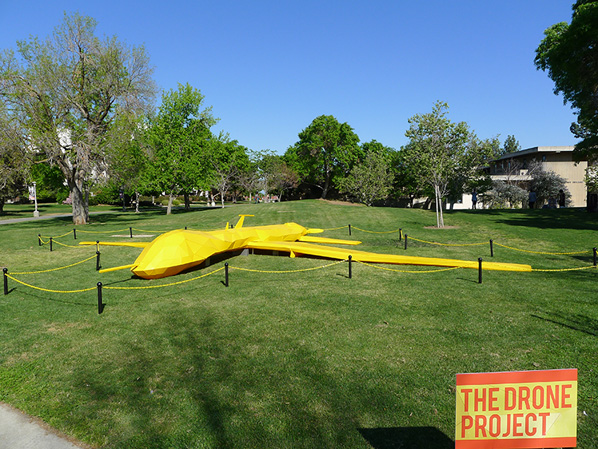
CL: And the people who are manning drones are sitting at their keyboards.
JD: Precisely, and that’s exactly one of the reasons I’m so interested in drones. Speaking of embodiment, the drones –it’s like a perfect synthesis of computer gaming culture, and our militarism, and our love for the latest possibilities of technology. It’s like somebody bashed those things together and out came this perfect system for blowing shit up on the other side of the planet – sitting in your comfortable gamer’s chair.
CL: The way you’re activating the Drone Memorial as an extension of your art activism – I’m wondering if part of the appeal is doing it within an educational institution, where you’re enlisting students to help you out, so it actually becomes part of an educative process. How much do they know about the drone policy?

JD: What’s interesting with that project is that they brought up these different groups – art students, design students, and there has been a group of activists from Fresno called Peace Fresno who’ve come out to work. There have been some TV interviews, and there’s a journalism class – they’re taking turns, every day there’s a different crew and they’re documenting the process and interviewing the people that are involved. And it’s been interesting talking to some students because there have been a number of students that are like: “What, drones? We can blow stuff up in Pakistan, from sitting in Las Vegas at Creech Air Force Base?” They don’t know about it, so there is a kind of basic informational aspect of the project.
But what I’m finding most interesting is that the students and volunteers – and myself – at this stage of the work we’re so absorbed in the embodiment, if you will, of the physical sculpture. It’s a building process and there’s a kind of pleasure in that. There’s the hands-on aspect of building, and seeing this form come into being. What I’m waiting for is that realization when we get the whole thing together, and it has this 48 foot wing span and 27 foot fuselage, sitting on the ground at the campus – and then we write the names [of the civilian casualties on the sculpture] – we have 334 names in English and Urdu.

I think that’s going to have a powerful impact, that’s going to completely flip the equation. Not just to give them a sense of their making something as a community build – but that we own these drones – we are this policy. These victims that are on the drone are connected to us, right? There’s a direct lineage from that pilot sitting in Creech Air Force Base, from the missile that rained down on that village and killed a 12-year-old girl, to you and me. It may be tentative, but it’s our government – it’s us.
Conclusion.
The interview was conducted several days before the completion of the Drone Memorial. After the sculpture was assembled and installed, there was a public ceremony at the site. Afterward, I asked Joseph if the effect of the ceremony was in fact what he envisioned, and he sent me the following reply via email:
We finished the drone just as the ceremony was scheduled to commence. There was a crowd of about 75 people – I made some brief comments thanking the volunteers and the CCA. The actual ceremony was being coordinated by a wonderful group, “Peace Fresno”, who coordinated the creation of individual, hand written index cards, each with the name, date of death and age (if available), of each of the 334 Pakistani drone victims. These were read aloud by individuals from Peace Fresno of Pakistani or Indian descent to ensure that the names were correctly pronounced. Those gathered for the event stood in line to take possession of a name after it was read aloud – walking towards the drone where they were given a pen. Each name was written with the associate dated of death and age of the victim when available. Several volunteers followed this process by filling in the names translated into Urdu.

I personally completed the process of standing in line, taking a pen and writing names on the drone 7-10 times, I lost count. The most memorable was that of an 8 year old girl – I don’t recall her name but after writing on the drone the realization of the death of a child was quite overwhelming. Others had similar experiences – there were several walking away from the drone after writing their name who were in tears. This cycle of writing, standing in line and continuing the process went on for perhaps 45 minutes until all 334 names were written upon the drone. All the while there were passersby stopping, asking what we were doing, some joined us. I recall a father on a bicycle have a discussion with his young son about drones, “are you ok with being surveilled 24/7?”, that kind of thing.
In my exhaustion after working 2 weeks followed by an additional weekend of 11 hour work days, the experience was moving and quite overwhelming. There was indeed a palpable realization of the nature of the project. The camaraderie established among the workers and volunteers evolved into a collaborative process of memorialization.
“Social Tactics” runs through April 27, and the Drone Memorial will be on display through May 31.
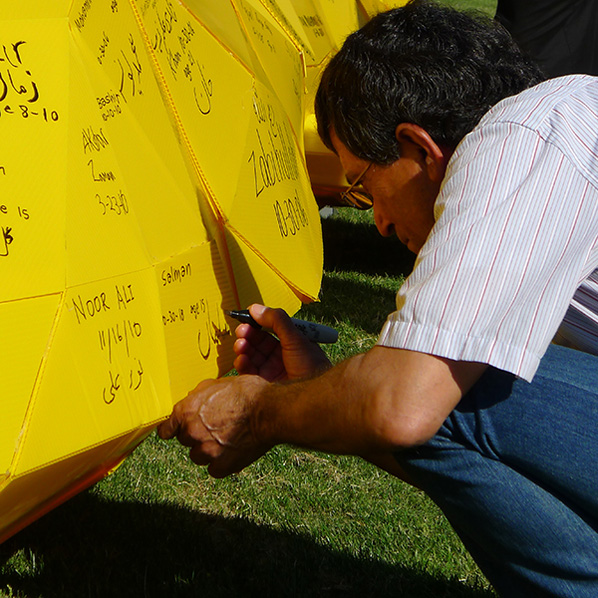
Joseph DeLappe’s website: http://www.delappe.net
A previous furtherfield interview on another drone-related project by DeLappe:
The 1,000 Drones Project, by Marc Garrett – 05/02/2014, furtherfield.org
http://furtherfield.org/features/interviews/1000-drones-project-interview-joseph-delappe
News story on US Military objections to ‘Medal of Honor’:
Sales of new ‘Medal of Honor’ video game banned on military bases, by Anne Flaherty – 09/09/2010, Washington Post
http://www.washingtonpost.com/wp-dyn/content/article/2010/09/08/AR2010090807219.html
News story and video on the Drone Memorial:
Drone project at Fresno State a call for ‘contemplation’ (video), by Carmen George – 03/26/2014, The Fresno Bee
http://www.fresnobee.com/2014/03/26/3845089/drone-project-at-fresno-state.html
Fresno College Newspaper story on the Drone Memorial:
Drone sculpture construction begins, by Collegian Staff – 03/18/2014, The Collegian at Fresno State
Drone sculpture construction begins
Essay on the visualization of the “Enemy” in military games, with a focus on “America’s Army”:
The Unreal Enemy of America’s Army, by Robertson Allen – 01/2011, Games and Culture 6(1):38–60
http://www.academia.edu/231295/The_Unreal_Enemy_of_Americas_Army
Featured image: Pablo Garcia’s presentation at Resonate 2014
Resonate, the Belgrade, Serbia digital arts and design festival, now in its third year unfolds over a long week at the start of April. Its central tenet is to bring together “artists, designers and educators to participate in a forward-looking debate on the position of technology in art and culture.” It is also an emerging and challenging festival that raises many more questions than it answers. The festival starts off with a number of workshops held by practitioners for practitioners. Foregrounding the demystification of the creative process immediately sets it apart from any number of other media arts festivals. Whereas many festivals might be broader in their approach to what the digital can include, and focus on themes that don’t always feel like they directly influence what happens in the festival, Resonate doesn’t give itself a curatorial focus. But, and so, the workshops set the festival off with a focus on making. Most people who come to Resonate are just that: makers of work. It feels as though there are fewer curators, producers and academics here than you would expect.
Resonate, the Belgrade, Serbia digital arts and design festival, now in its third year unfolds over a long week at the start of April. Its central tenet is to bring together “artists, designers and educators to participate in a forward-looking debate on the position of technology in art and culture.” It is also an emerging and challenging festival that raises many more questions than it answers. The festival starts off with a number of workshops held by practitioners for practitioners. Foregrounding the demystification of the creative process immediately sets it apart from any number of other media arts festivals. Whereas many festivals might be broader in their approach to what the digital can include, and focus on themes that don’t always feel like they directly influence what happens in the festival, Resonate doesn’t give itself a curatorial focus. But, and so, the workshops set the festival off with a focus on making. Most people who come to Resonate are just that: makers of work. It feels as though there are fewer curators, producers and academics here than you would expect.
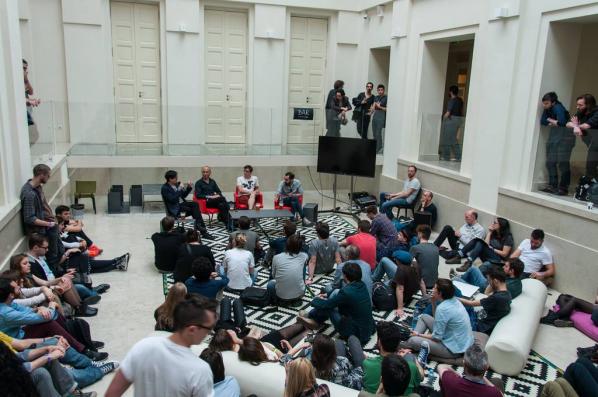
This year, shifting location from 2013’s Dom Omladine, perhaps learning from some of the problems of last year’s over-heated and occasionally too-tightly packed events, they have moved to a spread of venues, with the base being the Kinoteka Cinema, a sleek-looking modern building with a number of different spaces. Any decent festival has a spread of overlapping events making it impossible for one person to attend everything. Resonate makes no apologies for being just as packed with events as any other festival. The one time it might be possible to sit and spend a day in one place is if you’ve managed to get on to a workshop event that takes place on the Thursday. Once the workshops are over though, Friday kicks off with the panels and presentations. Choreographic Coding discussion, led by NODE Forum’s Jeanne Charlotte Vogt opened the panel discussions. A broad ranging talk with Raphael Hillebrand, Florian Jenett, Peter Kirn (CDM), Christian Loclair and Klaus Obermaier, (returning again after last year’s Resonate, possibly being an ongoing presence at the festival). All of the panel talks took place in the central lobby of the Kinoteka, which proved to be a terrible choice for anyone who wanted to actually hear the speakers. At times the discussions descended into a barrage of mumbles blending with the sound of people emerging from surrounding presentations and the poor choice of PA equipment placements. A shame, as the themes for these were well chosen, including Ways of Seeing, chaired by Greg J. Smith of HOLO magazine, and Generative Strategies, across the Friday and Saturday. The best laid plans of mice and journalists. I had planned to interview a number of presenters during the event, key amongst them was Pablo Garcia, who was on a panel and presented his own work on the Saturday. Apart from a brief conversation, we finally caught up over email several days later. I fired a number of questions at him, which are dotted across the rest of this review.
Do you find that Resonate offers something different than some other digital festivals? If so, what might that be? “It feels a lot like some of the better festivals I have seen, like EYEO. It is selecting from the best digital artists/makers out there, and giving them free reign on the stage to talk and share. The city has a great vibe and the overall feel is truly a “festival”, and not so much a conference or academic gathering.” ~ Pablo Garcia.
Friday’s talks included Cedric Kiefer (Onformative) giving a presentation in Gallery of Frescos, a short hop and stumble from Kinoteka Cinema. I’ve always enjoyed the juxtaposition that occurs when digital media is presented in contrast to, in this case, a venue “exhibiting in one place the highest achievements of Serbian Mediaeval and Byzantine art.” In other words, old stuff that enforces the modernity of the digital work we are being shown. Kiefer’s presentation covered some of their major projects including their work for Deutsche Telekom which used the company’s Facebook interactions to create beautiful data visualisations (Facebook Tree – 2013). There’s an unabashed acceptance of the interaction between corporate funding and creativity on display with many of the presentations. It’s something which never provokes debate, at least not in any of the conversations I had with participants or the panels I attended. Maybe that’s no longer ‘a thing’ that concerns creatives and the money required for some of the bigger projects has to allow for corporate sponsorship? I’m not suggesting we shouldn’t embrace funding from wherever it comes, it would just have been nice to have some debate around it.
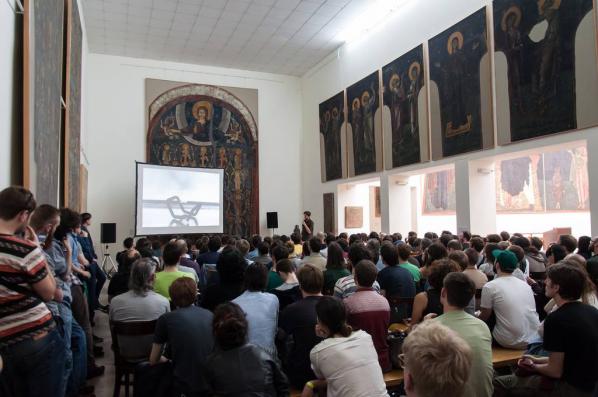
The schedule for the whole festival is broad and busy. There’s no chance of making it to every presentation or discussion, which is a great reason to go with others or to make an effort to talk to other attendees about what you’ve seen. The festival is a research port of call for many established, practicing digital artists. The UK’s Ludic Rooms have been to the past two festivals and consider it an opportunity to engage and re-establish contact with their peers in the community. “It is a coming together on an international scale with a thoughtful focus on practice,” reckons Ashley Brown, one half Ludic Rooms. Co-Director Dom Breadmore adds, “for us, Resonate has quickly superseded other events to become an annual pilgrimage for discussion and inspiration.”

One of the final presentations of the festival is by Daito Manabe in the Kolarac, another add-on venue of the festival, again an improvement on last year’s Dom Omladine. Daito’s work reflects something of the current state of digital media work. His presentation includes his (literally) home-made research videos, as well as the documentation of bigger projects. Whether he’s attaching electrodes to his own face to see what the effect is (hilarious facial distortions in this case), or working with dancers to create a drone/dancers piece, there’s humour and an enquiring mind at the center of his work. Daito showed his Ayrton Senna project, using the data transmitted from Senna’s car during his world-record lap in 1989, an ambitious and challenging project, least of all being the decision to erect it on the original racetrack. The data is used to trigger LEDs and numerous speakers laid out on the course. The LEDs follow the path taken by the car, while the sound is the engine accelerating and decelerating as the car would have taken the corners. It’s a ghostly piece, at once recreating that frustration that race fans must have of just having missed the car and a reminder that this is an event that happened many years ago. An echo of the past. Data mining, big data, is like this, in most contemporary projects. Data visualisation is a zombie, rising up to challenge the present. And like all the best zombie films, it can be a metaphor for our own rampant consumerism and reliance on technology. Still, at least in the hands of someone like Daito, our guilt is assuaged by humour.
What is your own take on the current landscape of digital media/art/design? “It’s an exciting time, for sure. Not only because there is so much digital access today for all to experiment with. We are starting to see makers move past the “wow” phase of tech and really start to integrate digital techniques into various historical techniques. Watching digital work cease to be about digitality will go a long way to opening new avenues of exploration.” ~ Pablo Garcia.
In those important few hours after a festival when you make your way back home, you finally get a chance to take stock. Thoughts crash over you in what better place for free-form thinking than the nowhere of airport waiting zones. In the neverzones I realised that what I’d thought was my frustration with Resonate, was actually the thing that gives it a unique flavour. Resonate doesn’t present a theme and then hope to find an answer through precarious curation of speakers who most likely will follow their own path anyway. What it does do, and does well, is ask questions that might not have answers. The focus on knowledge and learning gives attendees a broad enough palette to choose their own ambitions for the festival. There isn’t any guided pathway through the diverse range of speakers. There are many things that Resonate could do better. It would have been nice to see more actual work in the various spaces. Line of Sight, a collaborative project by Kimchi and Chips and Nanika, (produced by CAN_LABS and Resonate Festival) was installed and produced for Kinoteca goers during the festival, giving a taste familiar to many attendees, of the stress of having to deliver a working project to a tight deadline. Thankfully, they did so. More projects would have been nice though. Even the digital needs to explode out of the screen and smear itself across a few walls or public spaces, obstructing and challenging people around the venues. After all, contextuality is nine tenths of the art law. Equally, some of the audio/visual problems need addressing. Complaining about them seems like a mean sideswipe, but these are the things that leave people with the suspicion that a festival isn’t as bothered as it should be. Resonate does care about attendees, as is evidenced by the free workshops and focus on helping to develop practitioners. It reflects this in its very DNA as an ever-becoming environment for creatives. And besides, the good stuff always happens in the rough and frayed edges. Resonate needs space and time to stretch and breath and see what it can become, just as Serbia, despite a rich and ‘interesting’ history (Belgrade is one of Europe’s oldest cities) is still finding its feet in the modern world (it applied for membership of the European Union in 2009). The festival supports emerging digital media practitioners by accelerating interaction with other countries to support the country’s upper-middle income economy with its strong service sector economy.
What was your experience of Resonate? “Resonate is a jam-packed, head-spinning experience. So many amazing people showing all their goodies in tightly packed spaces. It’s a lot of fun. Caveat: don’t go expecting to see everything. So many events and talks are happening simultaneously, you can’t see it all. Personally, I found it incredibly valuable to be able to show my work to a really talented and smart group of people to get solid feedback on what I do. I learned a lot by presenting and by seeing sympathetic artists.” ~ Pablo Garcia.
As the festival evolves, it would be nice if it smoothed out some of the frayed edges. But maybe this isn’t possible without allowing the freedom the open spaces allow for the fun stuff to happen. As Daito Manabe’s presentation showed, the open, unordered spaces are where all the best artistic developments take place.
Jonas Lund’s artistic practice revolves around the mechanisms that constitute contemporary art production, its market and the established ‘art worlds’. Using a wide variety of media, combining software-based works with performance, installation, video, photography and sculptures, he produces works that have an underlying foundation in writing code. By approaching art world systems from a programmatic point of view, the work engages through a criticality largely informed by algorithms and ‘big data’.
It’s been just over a year since Lund began his projects that attempt to redefine the commercial art world, because according to him, ‘the art market is, compared to other markets, largely unregulated, the sales are at the whim of collectors and the price points follows an odd combination of demand, supply and peer inspired hype’. Starting with The Paintshop.biz (2012) that showed the effects of collaborative efforts and ranking algorithms, the projects moved closer and closer to reveal the mechanisms that constitute contemporary art production, its market and the creation of an established ‘art world’. Its current peak was the solo exhibition The Fear Of Missing Out, presented at MAMA in Rotterdam.
Annet Dekker: The Fear Of Missing Out (FOMO) proposes that it is possible to be one step ahead of the art world by using well-crafted algorithms and computational logic. Can you explain how this works?
Jonas Lund The underlying motivation for the work is treating art worlds as networked based systems. The exhibition The Fear Of Missing Out spawned from my previous work The Top 100 Highest Ranked Curators In The World, for which I assembled a comprehensive database on the bigger parts of the art world using sources such as Artfacts, Mutaul Art, Artsy and e-flux. The database consists of artists, curators, exhibitions, galleries, institutions, art works and auction results. At the moment it has over four million rows of information. With this amount of information – ‘big data’ – the database has the potential to reveal the hidden and unfamiliar behaviour of the art world by exploring the art world as any other network of connected nodes, as a systemic solution to problematics of abstraction.

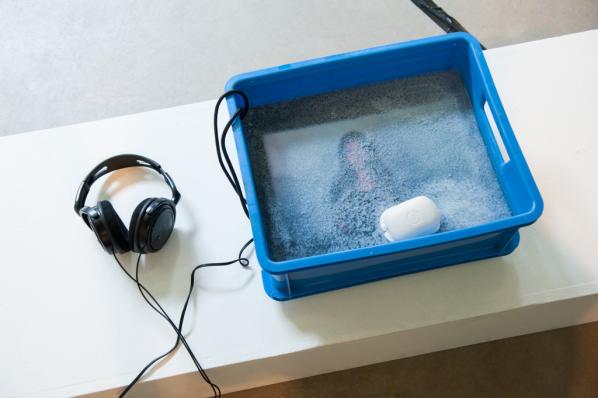
In The Top 100 Highest Ranked Curators In The World, first exhibited at Tent in Rotterdam, I wrote a curatorial ranking algorithm and used the database, to examine the underlying stratified network of artists and curators within art institutions and exhibition making: the algorithm determined who were among the most important and influential players in the art world. Presented as a photographic series of portraits, the work functions both as a summary of the increasingly important role of the curator in exhibition making, as an introduction to the larger art world database and as a guide for young up and coming artists for who to look out for at the openings.
Central to the art world network of different players lies arts production, this is where FOMO comes is. In FOMO, I used the same database as the basis for an algorithm that generated instructions for producing the most optimal artworks for the size of the Showroom MAMA exhibition space in Rotterdam while taking into account the allotted production budget. Prints, sculptures, installations and photographs were all produced at the whim of the given instructions. The algorithm used meta- data from over one hundred thousand art works and ranked them based on complexity. A subset of these art works were then used, based on the premise that a successful work of art has a high price, high aesthetic value but low production cost and complexity, to create instructions deciding title, material, dimensions, price, colour palette and position within the exhibition space.
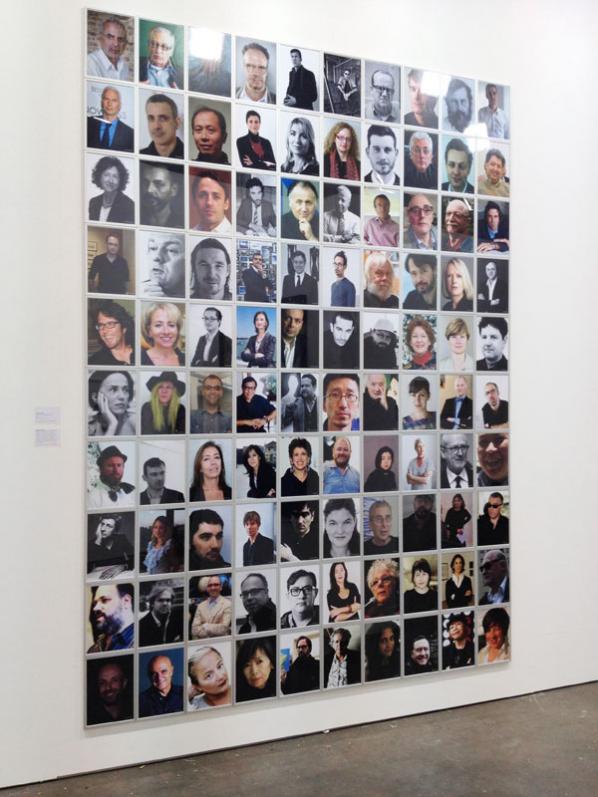
Similar to how we’re becoming puppets to the big data social media companies, so I became a slave of the instructions and executed them without hesitation. FOMO proposes that it is possible to be one step ahead of the art world by using well-crafted algorithms and computational logic and questions notions of authenticity and authorship.
AD: To briefly go into one of the works, in an interview you mention Shield Whitechapel Isn’t Scoop – a rope stretched vertically from ceiling to floor and printed with red and yellow ink – as a ‘really great piece’, can you elaborate a little bit? Why is this to you a great piece, which, according to your statement in the same interview, you would not have made if it weren’t the outcome of your analysis?
JL: Coming from a ‘net art’ background, most of the previous works I have made can be simplified and summarised in a couple of sentences in how they work and operate. Obviously this doesn’t exclude further conversation or discourse, but I feel that there is a specificity of working and making with code that is pretty far from let’s say, abstract paintings. Since the execution of each piece is based on the instructions generated by the algorithm the results can be very surprising.
The rope piece to me was striking because as soon as I saw it in finished form, I was attracted to it, but I couldn’t directly explain why. Rather than just being a cold-hearted production assistant performing the instructions, the rope piece offered a surprise aha moment, where once it was finished I could see an array of possibilities and interpretations for the piece. Was the aha moment because of its aesthetic value or rather for the symbolism of climbing the rope higher, as a sort of contemporary art response to ‘We Started From The Bottom Now We’re Here’. My surprise and affection for the piece functions as a counterweight to the notion of objective cold big data. Sometimes you just have to trust the instructionally inspired artistic instinct and roll with it, so I guess in that way maybe now it is not that different from let’s say, abstract painting.
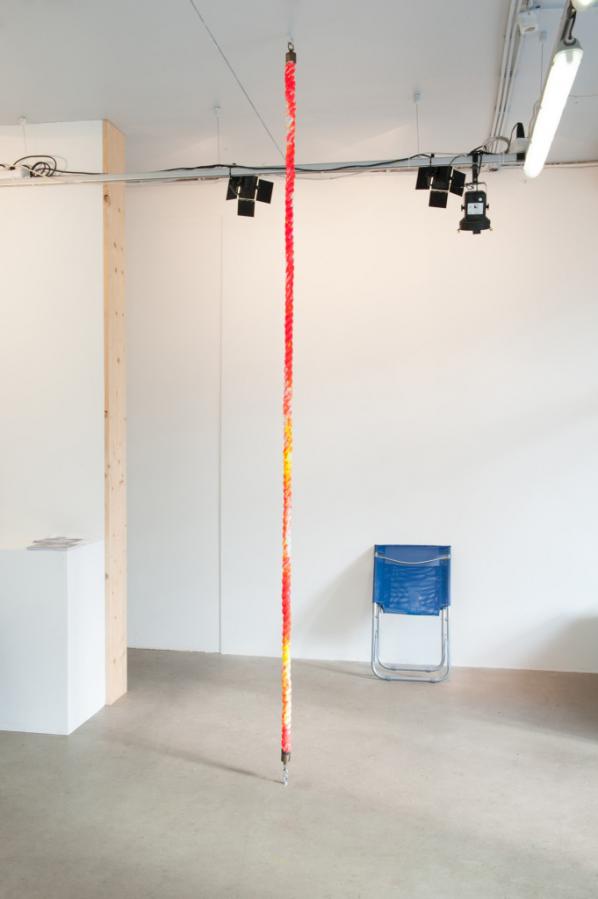
AD: I can imagine quite a few people would be interested in using this type of predictive computation. But since you’re basing yourself on existing data in what way does it predict the future, is it not more a confirmation of the present?
JL: One of the only ways we have in order to make predictions is by looking at the past. Through detecting certain patterns and movements it is possible to glean what will happen next. Very simplified, say that artist A was part of exhibition A at institution A working with curator A in 2012 and then in 2014 part of exhibition B at institution B working with curator A. Then say that artist B participates in exhibition B in 2013 working with curator A at institution A, based on this simplified pattern analysis, artist B would participate in exhibition C at institution B working with curator A. Simple right?
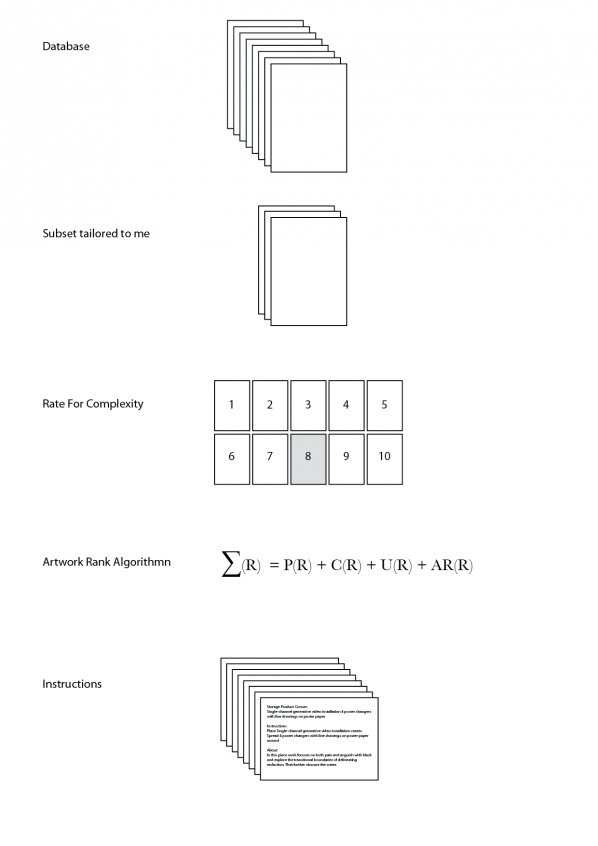
AD: In the press release it states that you worked closely with Showroom MAMA’s curator Gerben Willers. How did that relation give shape or influenced the outcome? And in what way has he, as a curator, influenced the project?
JL: We first started having a conversation about doing a show in the Summer of 2012, and for the following year we met up a couple of times and discussed what would be an interesting and fitting show for MAMA. In the beginning of 2013 I started working with art world databases, Gerben and I were making our own top lists and speculative exhibitions for the future. Indirectly, the conversations led to the FOMO exhibition. During the two production phases, Gerben and his team were immensely helpful in executing the instructions.
AD: Notion of authorship and originality have been contested over the years, and within digital and networked – especially open source – practices they underwent a real transformation in which it has been argued that authorship and originality still exist but are differently defined. How do see authorship and originality in relation to your work, i.e. where do they reside; is it the writing of the code, the translation of the results, the making and exhibiting of the works, or the documentation of them?
JL: I think it depends on what work we are discussing, but in relation to FOMO I see the whole piece, from start to finish as the residing place of the work. It is not the first time someone makes works based on instructions, for example Sol LeWitt, nor the first time someone uses optimisation ideas or ‘most cliché’ art works as a subject. However, this might be first time someone has done it in the way I did with FOMO, so the whole package becomes the piece. The database, the algorithm, the instructions, the execution, the production and the documentation and the presentation of the ideas. That is not to say I claim any type of ownership or copyright of these ideas or approaches, but maybe I should.
AD: Perhaps I can also rephrase my earlier question regarding the role of the curator: in what way do you think the ‘physical’ curator or artist influences the kind of artworks that come out? In other words, earlier instructions based artworks, like indeed Sol LeWitt’s artworks, were very calculated, there was little left to the imagination of the next ‘executor’. Looking into the future, what would be a remake of FOMO: would someone execute again the algorithms or try to remake the objects that you created (from the algorithm)?
JL: In the case with FOMO the instructions are not specific but rather points out materials, and how to roughly put it together by position and dimensions, so most of the work is left up to the executor of said instructions. It would not make any sense to re-use these instructions as they were specifically tailored towards me exhibiting at Showroom MAMA in September/October 2013, so in contrast to LeWitt’s instructions, what is left and can travel on, besides the executions, is the way the instructions were constructed by the algorithm.
AD: Your project could easily be discarded as confirming instead of critiquing the established art world – this is reinforced since you recently attached yourself to a commercial gallery. In what way is a political statement important to you, or not? And how is that (or not) manifested most prominently?
JL: I don’t think the critique of the art world is necessarily coming from me. It seems like that is how what I’m doing is naturally interpreted. I’m showing correlations between materials and people, I’ve never made any statement about why those correlations exist or judging the fact that those correlations exist at all. I recently tweeted, ‘There are three types of lies: lies, damned lies and Big Data’, anachronistically paraphrasing Mark Twain’s distrust for the establishment and the reliance on numbers for making informed decisions (my addition to his quote). Big data, algorithms, quantification, optimisation… It is one way of looking at things and people; right now it seems to be the dominant way people want to look at the world. When you see that something deemed so mysterious as the art world or art in general has some type of structural logic or pattern behind it, any critical person would wonder about the causality of that structure, I guess that is why it is naturally interpreted as an institutional critique. So, by exploring the art world, the market and art production through the lens of algorithms and big data I aim to question the way we operate within these systems and what effects and affects this has on art, and perhaps even propose a better system.
AD: How did people react to the project? What (if any) reactions did you receive from the traditional artworld on the project?
JL: Most interesting reactions usually take place on the comment sections of a couple of websites that published the piece, in particular Huffington Post’s article ‘Controversial New Project Uses Algorithm To Predict Art’. Some of my favourite responses are:
‘i guess my tax dollars are going to pay this persons living wages?’
‘Pure B.S. ……..when everything is art then there is no art’
‘As an artist – I have no words for this.’
‘Sounds like a great way to sacrifice your integrity.’
‘Wanna bet this genius is under 30 and has never heard of algorithmic composition or applying stochastic techniques to art production?’
‘Or, for a fun change of pace, you could try doing something because you have a real talent for it, on your own.’
AD: Even though the project is very computational driven, as you explain the human aspects is just as important. A relation to performance art seems obvious, something that is also present in some of your other works most notably Selfsurfing (2012) where people over a 24 hour period could watch you browsing the World Wide Web, and Public Access Me (2013), an extension of Selfsurfing where people when logged in could see all your online ‘traffic’. A project that recalls earlier projects like Eva & Franco Mattes’ Life Sharing (2000). In what way does your project add to this and/or other examples from the past?


JL: Web technology changes rapidly and what is possible today wasn’t possible last year and while most art forms are rather static and change slowly, net art in particular has a context that’s changing on a weekly basis, whether there is a new service popping up changing how we communicate with each other or a revaluation that the NSA or GCHQ has been listening in on even more facets of our personal lives. As the web changes, we change how we relate to it and operate within it. Public Access Me and Selfsufing are looking at a very specific place within our browsing behaviour and breaks out of the predefined format that has been made up for us.
There are many works within this category of privacy sharing, from Kyle McDonalds’ live tweeter, to Johannes P Osterhoff’s iPhone Live and Eva & Franco Mattes’ earlier work as you mentioned. While I cannot speak for the others, I interpret it as an exploration of a similar idea where you open up a private part of your daily routine to re-evaluate what is private, what privacy means, how we are effected by surrendering it and maybe even simultaneously trying to retain or maintain some sense of intimacy. Post-Snowden, I think this is something we will see a lot more of in various forms.
AD: Is your new piece Disassociated Press, following the 1970s algorithm that generated text based on existing texts, a next step in this process? Why is this specific algorithm of the 70s important now?

JL: Central to the art world lies e-flux, the hugely popular art newsletter where a post can cost up to one thousand dollars. While spending your institution’s money you better sound really smart and using a highly complicated language helps. Through the course of thousands of press releases, exhibition descriptions, artist proposals and curatorial statements a typical art language has emerged. This language functions as a way to keep outsiders out, but also as a justification for everything that is art.
Disassociated Press is partly using the Dissociated Press algorithm developed in 1972, first associated with the Emacs implementation. By choosing a n-gram of predefined length and consequently looking for occurrences of these words within the n-gram in a body of text, new text is generated that at first sight seems to belong together but doesn’t really convey a message beyond its own creation. It is a summary of the current situation of press releases in the international English art language perhaps, as a press release in its purest form. So, Disassociated Press creates new press releases to highlight the absurdity in how we talk and write about art. If a scrambled press release sounds just like normal art talk then clearly something is wrong, right?